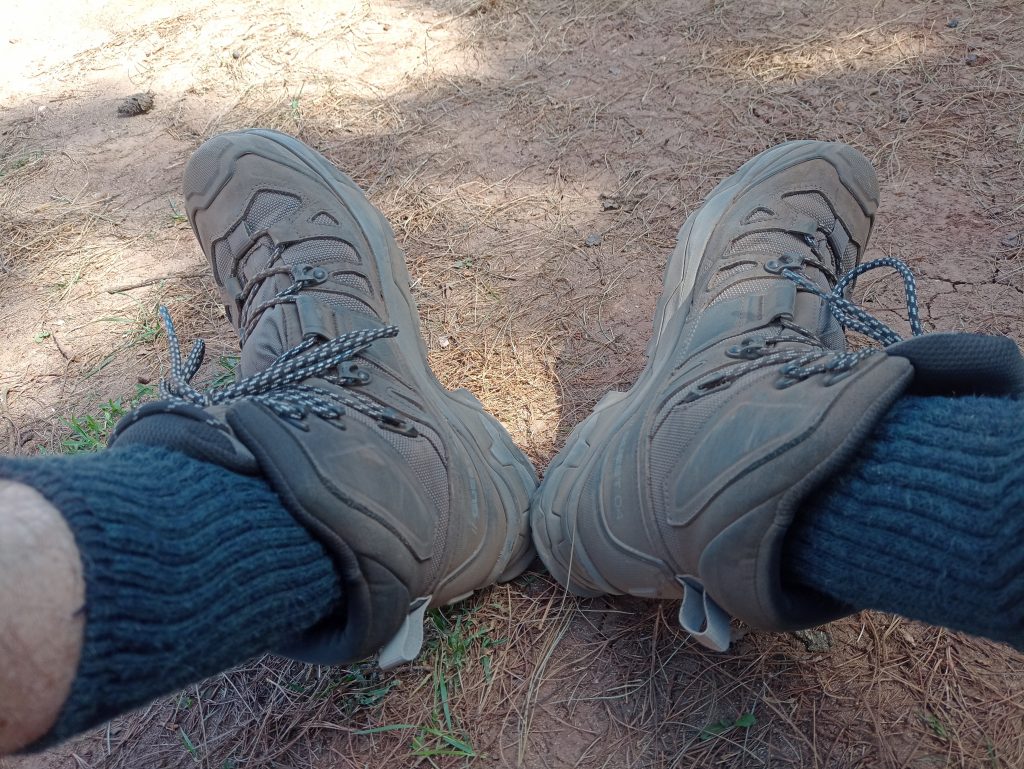About admin
View all posts by admin
We did it – Mount Kenya
I’m back in Nairobi having successfully summitted Mount Kenya’s Lenana Point, the third peak and the only one accessible on foot.

The trip started on Tuesday when we drove to Naru Moru on the west side of the mountain, and did an 8km warm up hike.
Early on Wednesday we drive via the park gate to the Metrological Station, where the hike began. We hiked 10km, ascending from 3000m to 4300m, through forest, bog and moorland. It was tough going, negotiating rocks and water/mud. We reached Mackinders Camp about 4, prepared ourselves for the morning, ate supper and had an early night.
On Thursday we rose at 1am and started hiking at 2:30. By the light of head torches we traversed rocks and streams, always pole pole to Austrian Hut on a plateau below the three peaks. Then we started climbing up Lenana. There was snow on the ground, frozen hard so providing purchase for hiking poles. There were steel cables to hang onto to avoid falling off the mountain, but not for use with bare hands in the sub-zero temperature. The sun was rising as we approached the summit, and we started to see our spectacular surroundings.
I was pretty much exhausted and the descent was steep and hard work, but the views were stunning. I also realised just how much we had climbed in the dark. By the time we returned to camp I could barely stand!
After breakfast and a short nap we were off again, hiking back to the Met Station. 10km, 1300m of descent, you’d expect a rapid hike. But the terrain in rough, rocky, boggy, so it took 4 hours.
Overall it was a fantastic experience, much tougher than Kilimanjaro despite being lower, because of the terrain. The views were amazing! And it was quiet – there were only 5 of us on the mountain (3 hikers and 2 guides).
I’ll add some more photos later.
If you want to support my fundraiser, donations can be made via Eyes For East Africa’s own website. If you do donate, please tell me.
https://www.eyesforeastafrica.org/support-us.html
Climbing Mount Kenya
Back in January I climbed Kilimanjaro and through the generosity of many supporters raised over £3000 for the Kwale Eye Centre in Kenya.
I am currently back in Kenya and next week will climb Mount Kenya, Africa’s second highest mountain, on a 4-day hike from West to East. I’m told it’s tougher and colder than Kilimanjaro, and the El Niño rains that have been battering Kenya will add an extra dimension!
I thought it might be too soon to squeeze people for money again, but a number of friends have asked how to donate and it’s such an important cause… So if you want to support that’s great, but don’t feel pressured.
For technical reasons we can’t use GoFundMe at the moment, but donations can be made via Eyes For East Africa’s own website. If you do donate, please tell me.
https://www.eyesforeastafrica.org/support-us.html
I will add some updates to this blog.
Many thanks
Aidan
Mount Kenya – Nithi Falls & Lake Ellis
When I was planning my trip to Kenya, coach Steve had posted pictures from a hike on Mount Kenya that made me jealous, so we hatched a plan to squeeze in a day hike before I headed for home.. Detailed plans for an early start were made and, although Nashon and I were up at 04:00 and on the road at 04:45 as planned the sequence of pick ups dragged on so that by the time we were approaching Embu we were about 90 minutes behind schedule. Then disaster befell: the throttle cable jammed in Embu town. Luckily a credible mechanic appeared but we had a 90-minute wait (drinking coffee etc) while the van was fixed.
When we left the highway we had to follow some 30km of rough gravel road climbing up to Chogoria Gate.
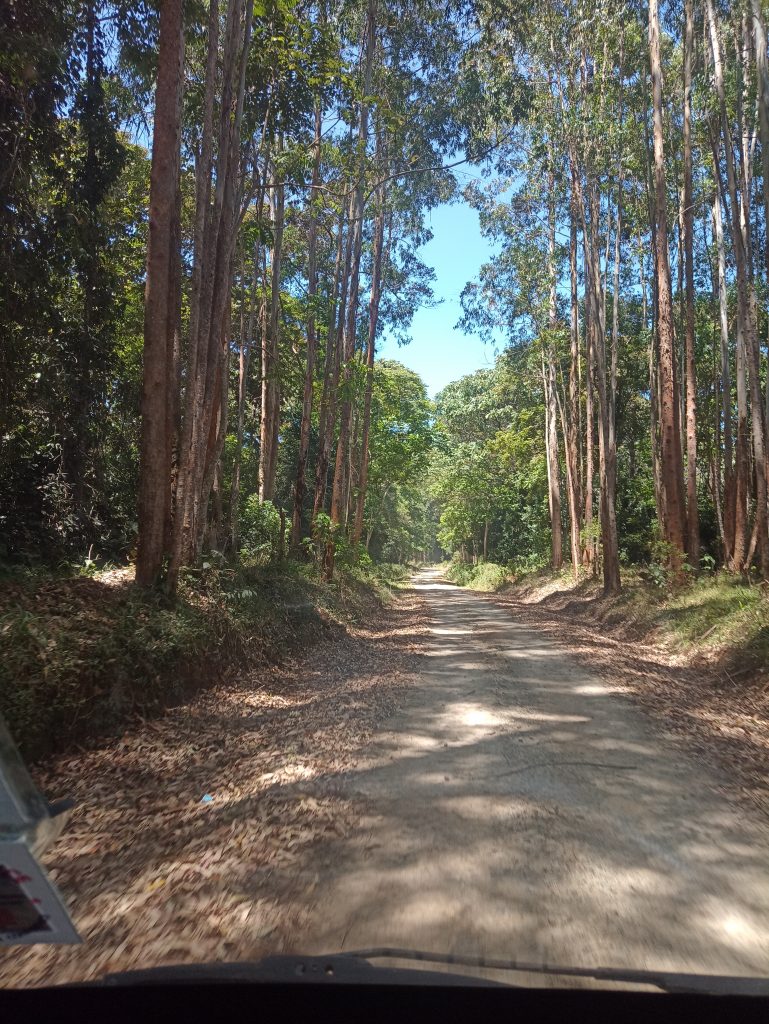
Climbing very slowly as the 1800cc engine was too feeble to carry 7 people up the hill and eventually stopped dead. We all got out and Steve got it going again; Nashon and I ran after him and jumped in, then we drove on leaving the others to walk! At the gate (rather further than we’d expected) we met my friends Makena ad Brian who had driven up in their Prado and Brian was despatched to rescue the walkers!

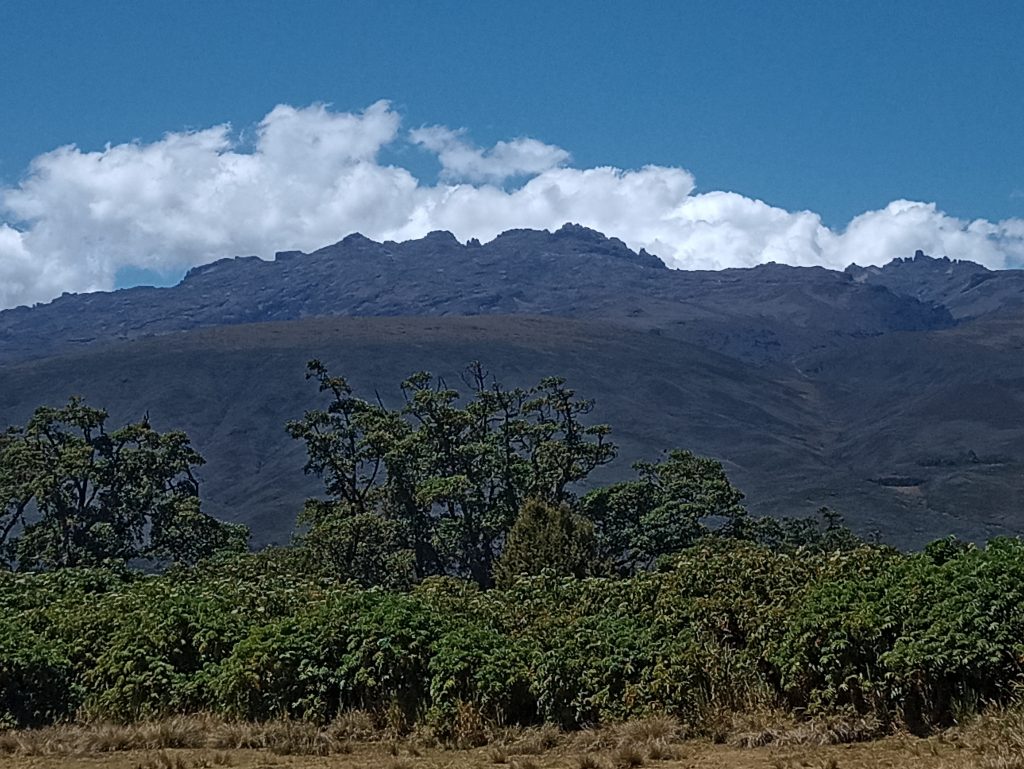
So it was after 1pm rather than 9am that we actually started walking.
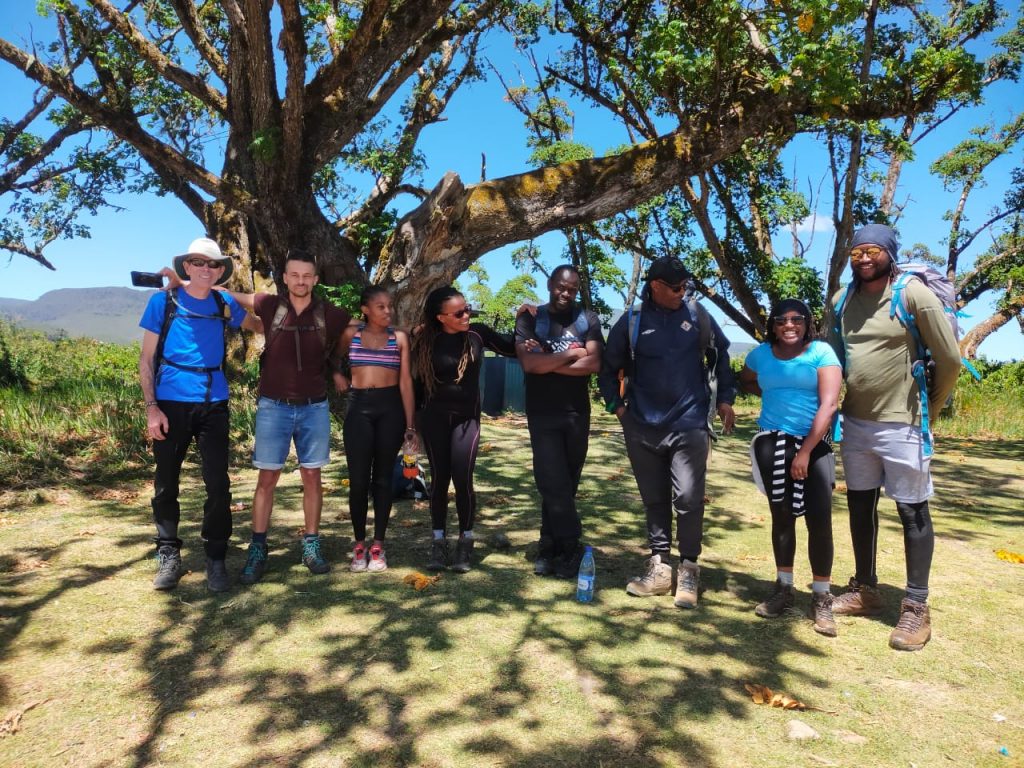
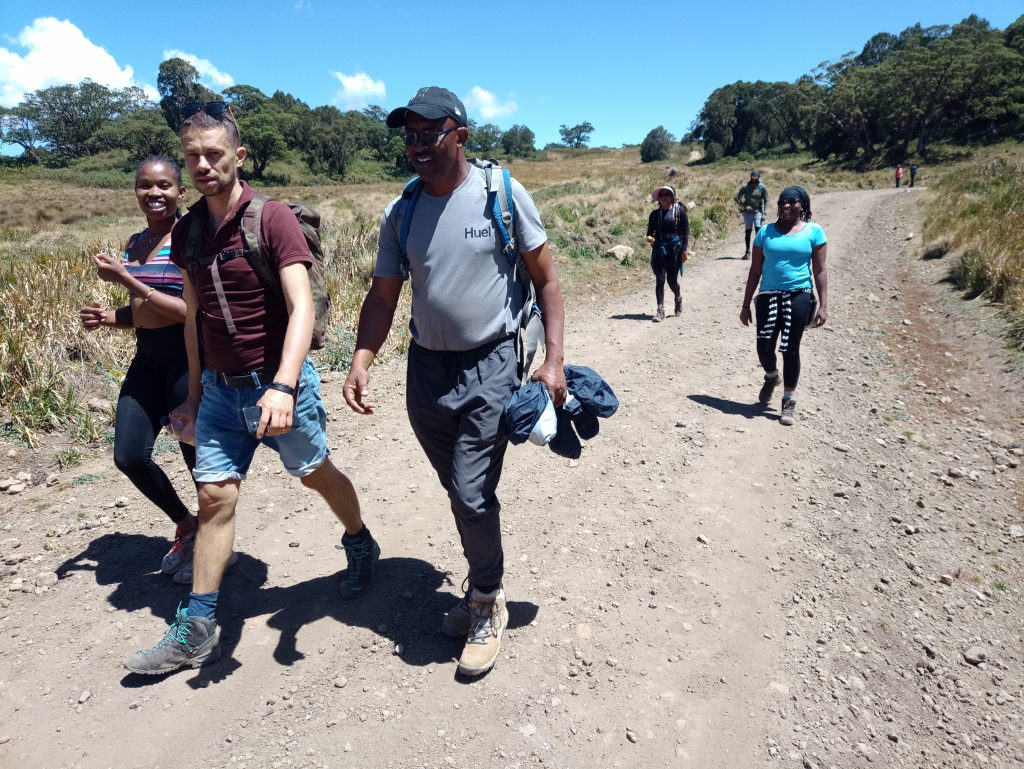
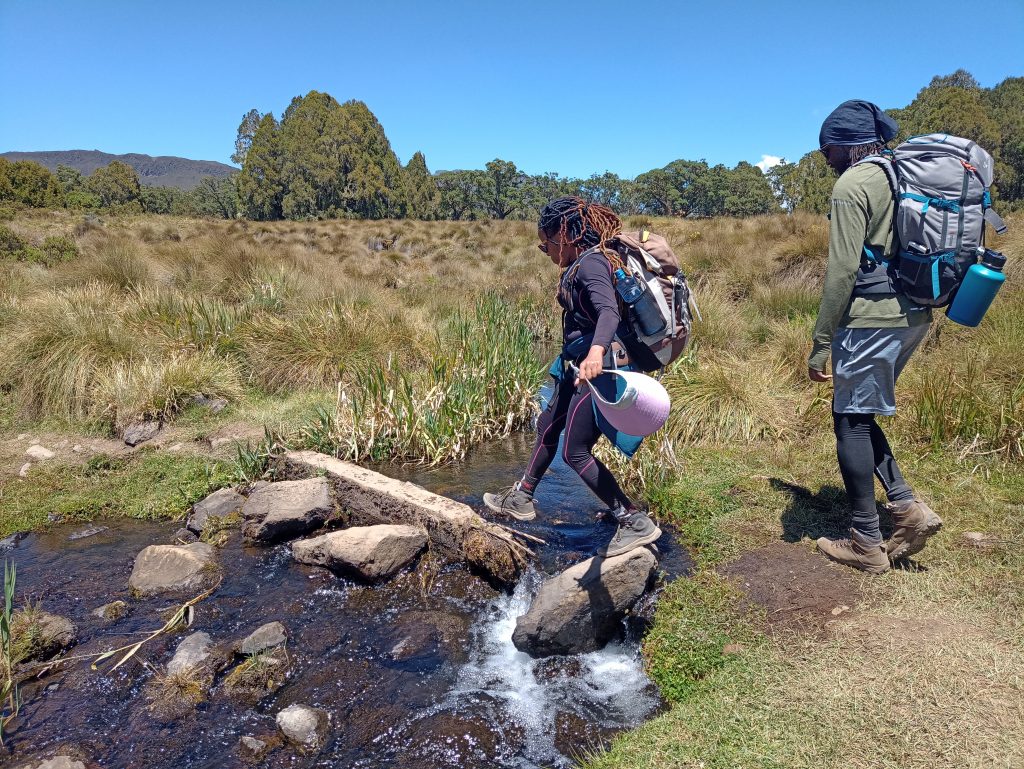
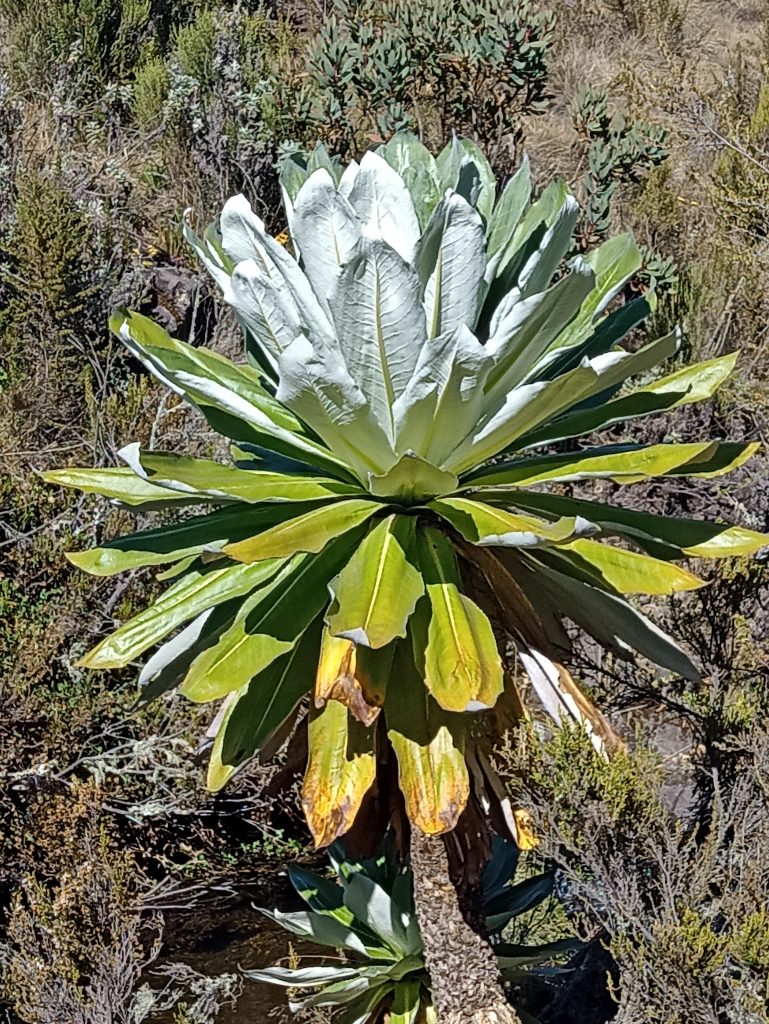

After a long steady climb, we descended to the stunning Nithi Falls.
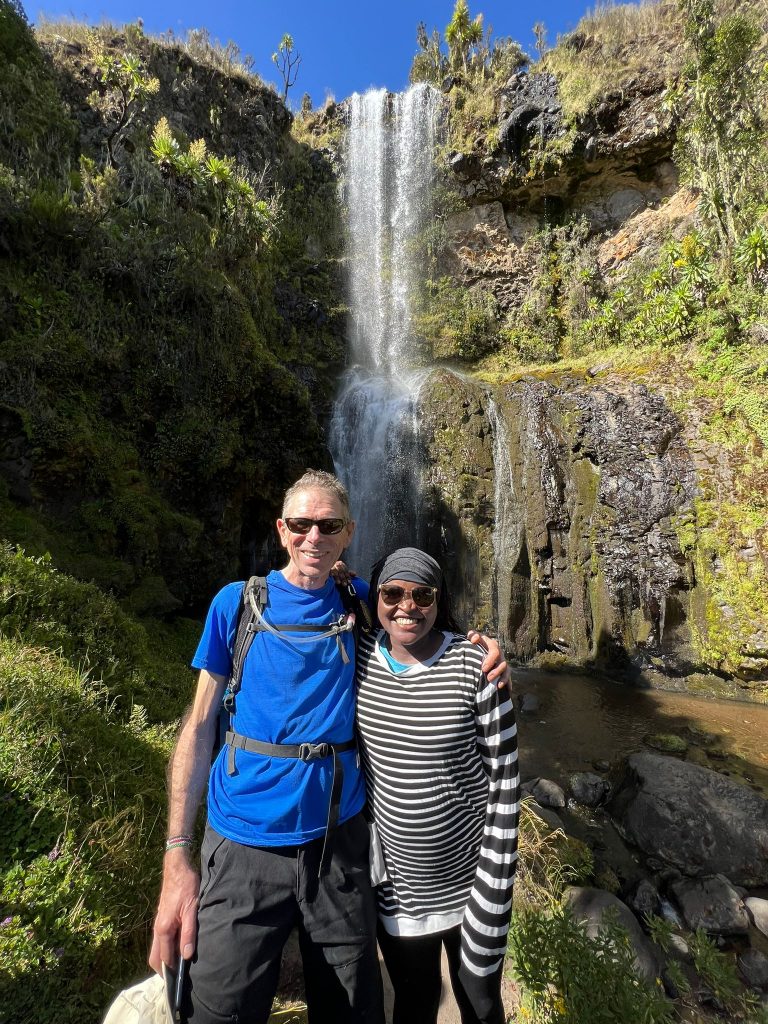
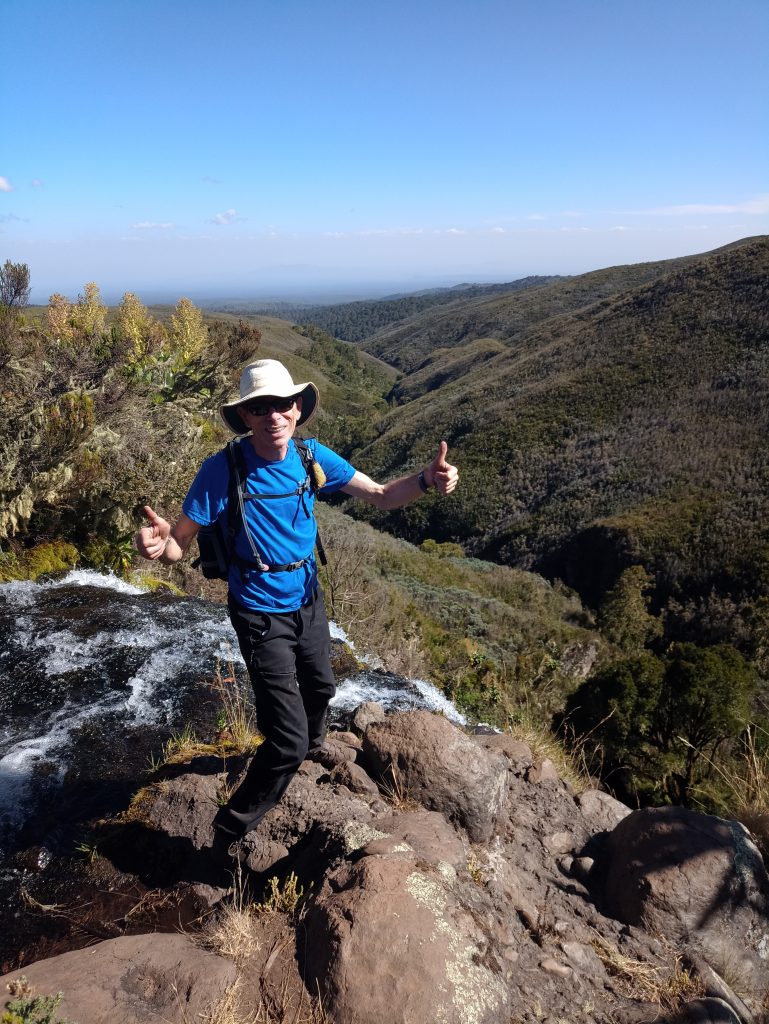
Then back up and on across the mountainside
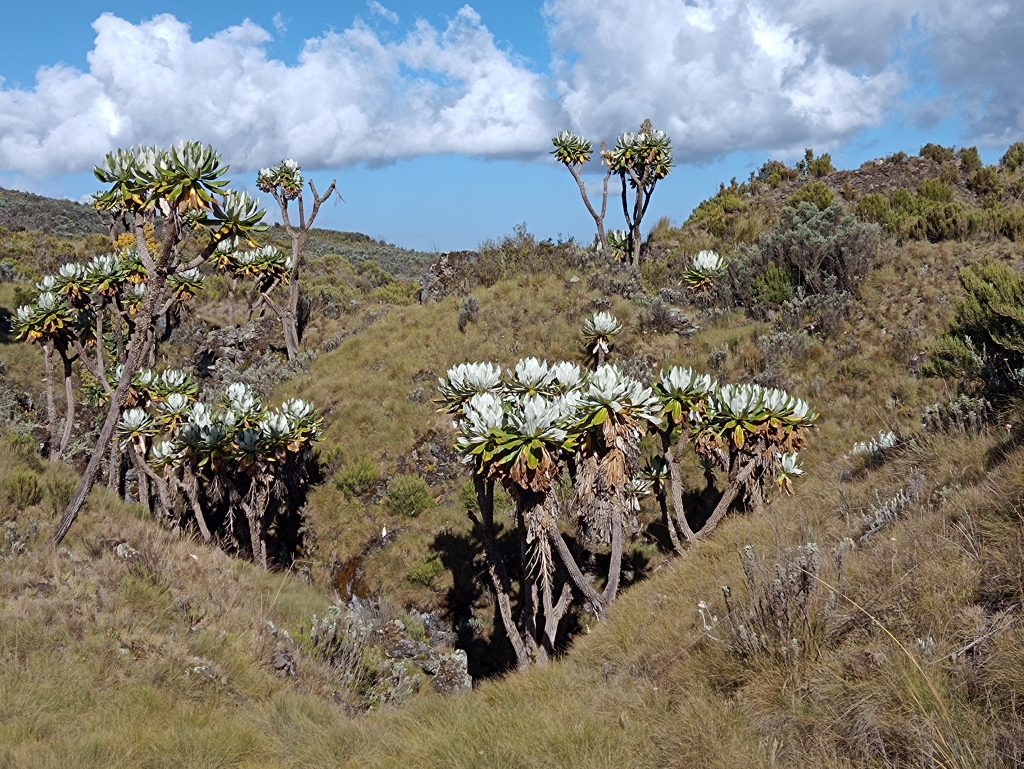
The giant Lobelia are weird and wonderful
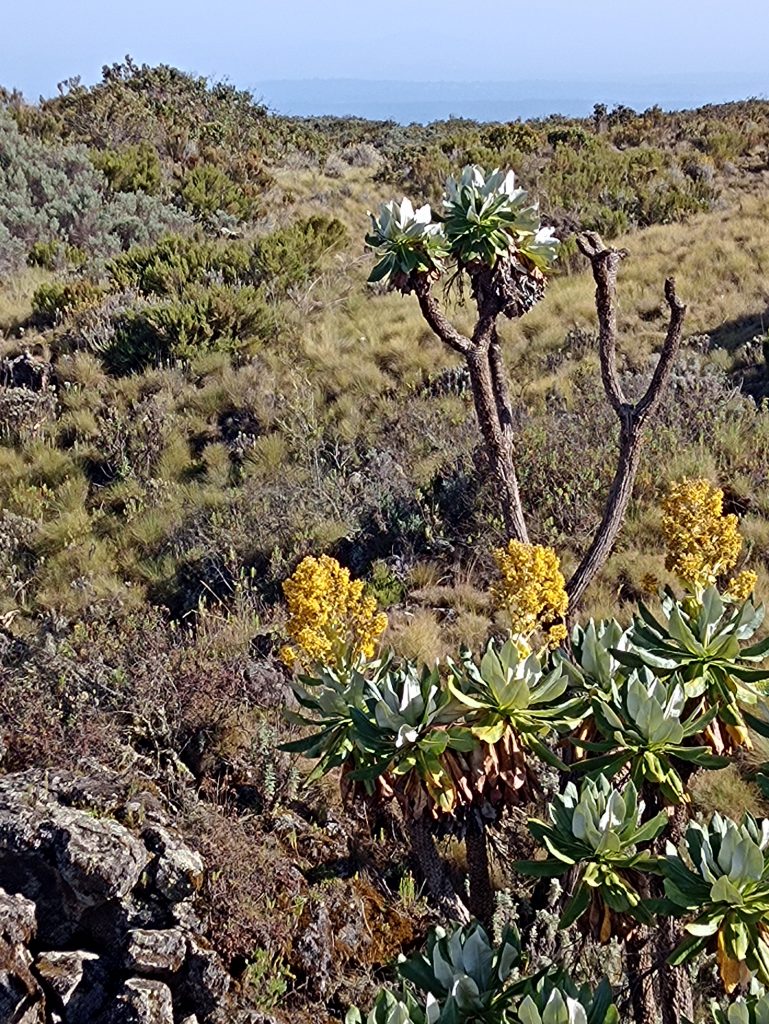
Eventually we got sight of Lake Ellis

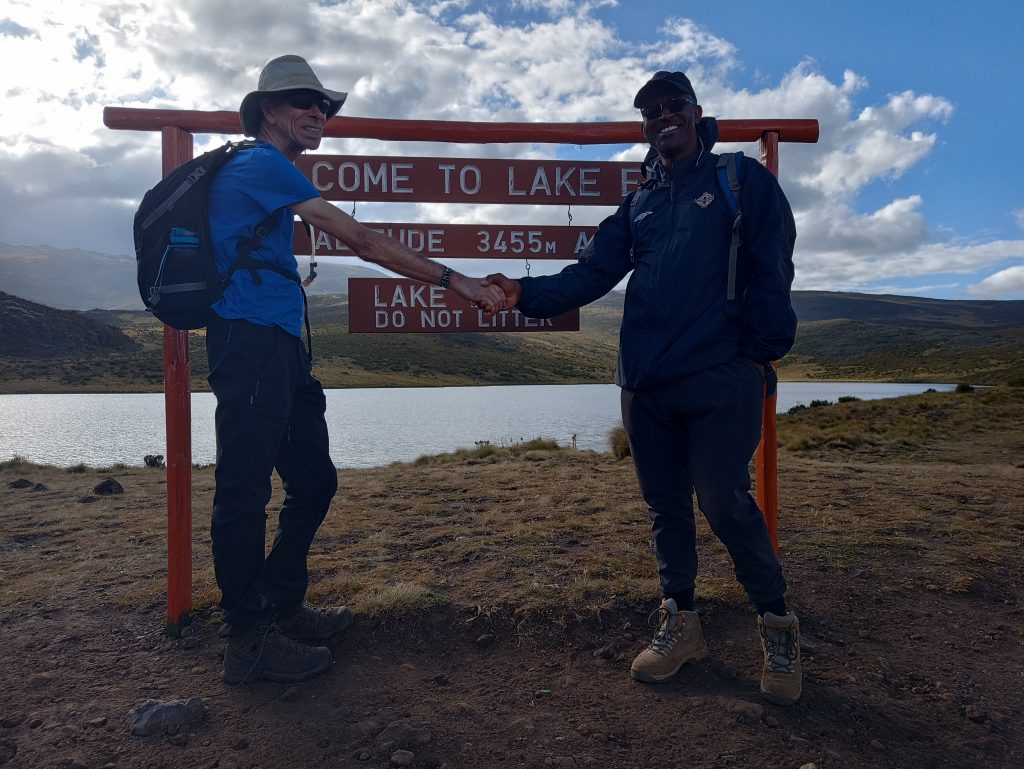
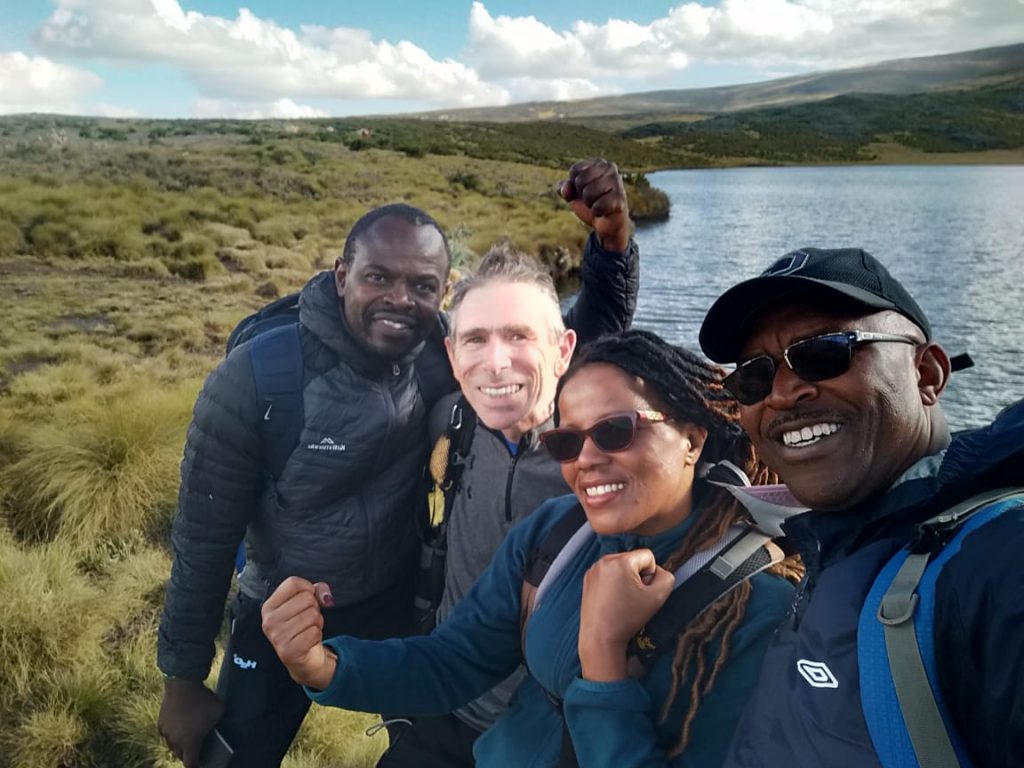
On the way back down it was getting late. Brian had driven up to collect Makena from the road head and stopped to pick the rest of us up for the last 2 or 3km. How many people can you squeeze in a Prado? (There were 3 more of us in the boot)
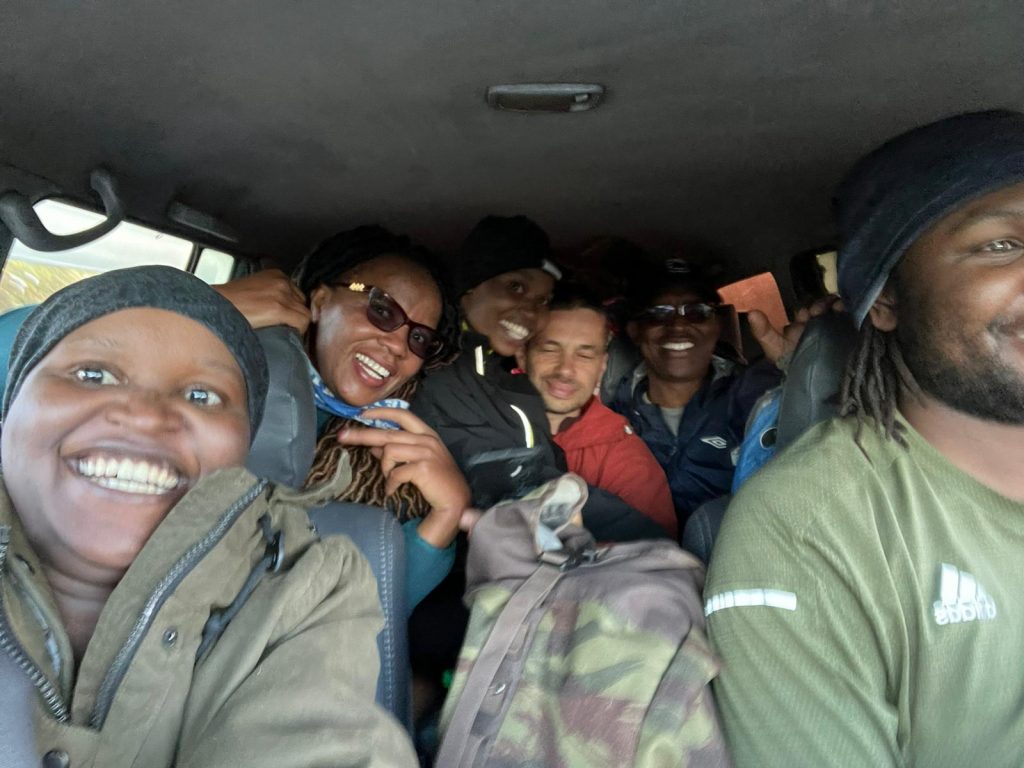
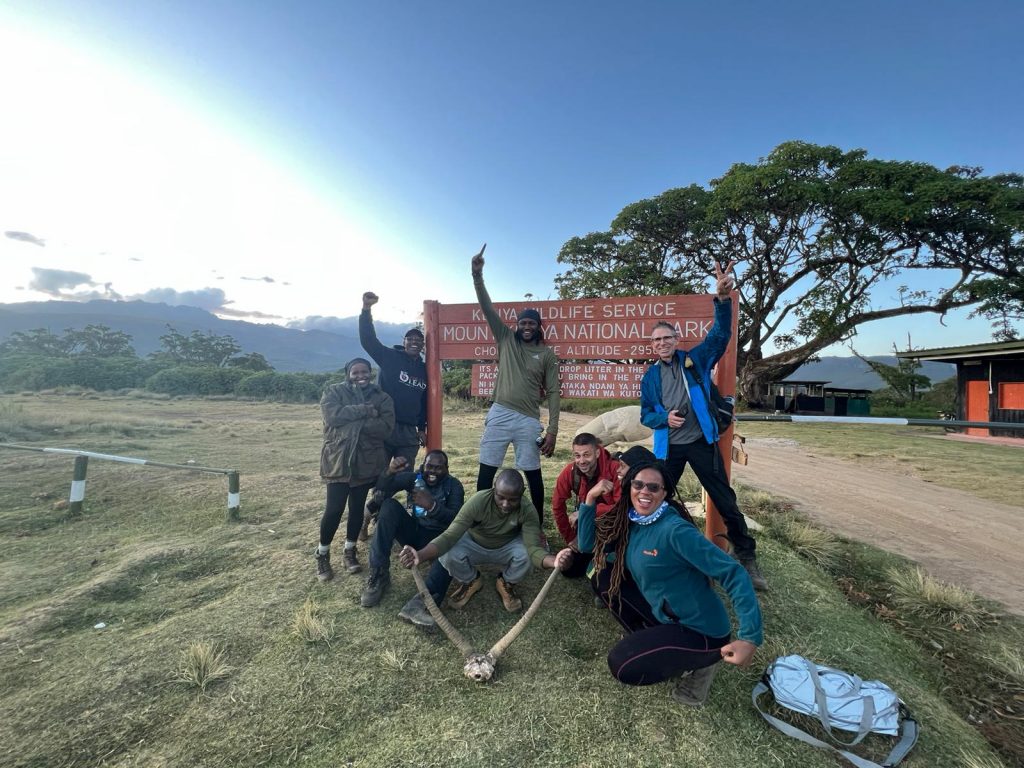
We ate our “lunch” quickly then started the descent by road, in the dark. I had elected to accept an invitation to stay with Makena and Brian (only 15 minutes from the lower gate) rather than travel all the way back to Nairobi that night.
After a great night’s sleep (no mosquitoes, fresh cool air) I awoke to birds singing, cattle lowing, cocks crowing, and a splendid sunrise across the tea gardens.
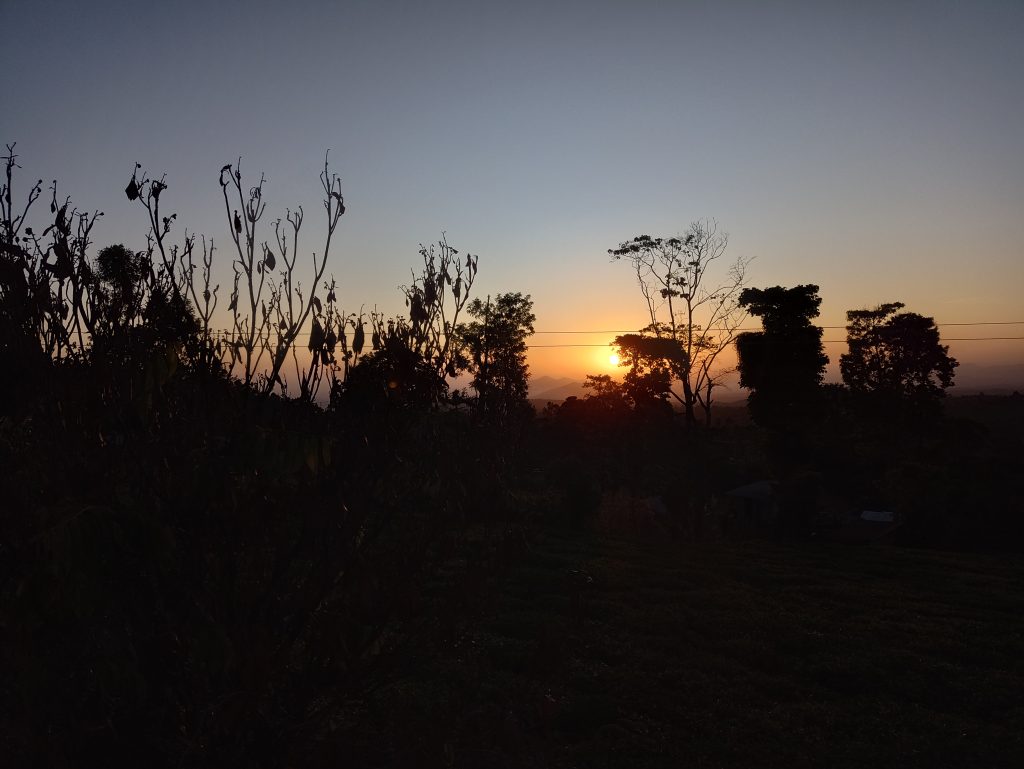
Before breakfast I took a short walk through the tea gardens, down to the river and back up again. So green, so peaceful. Is this heaven?
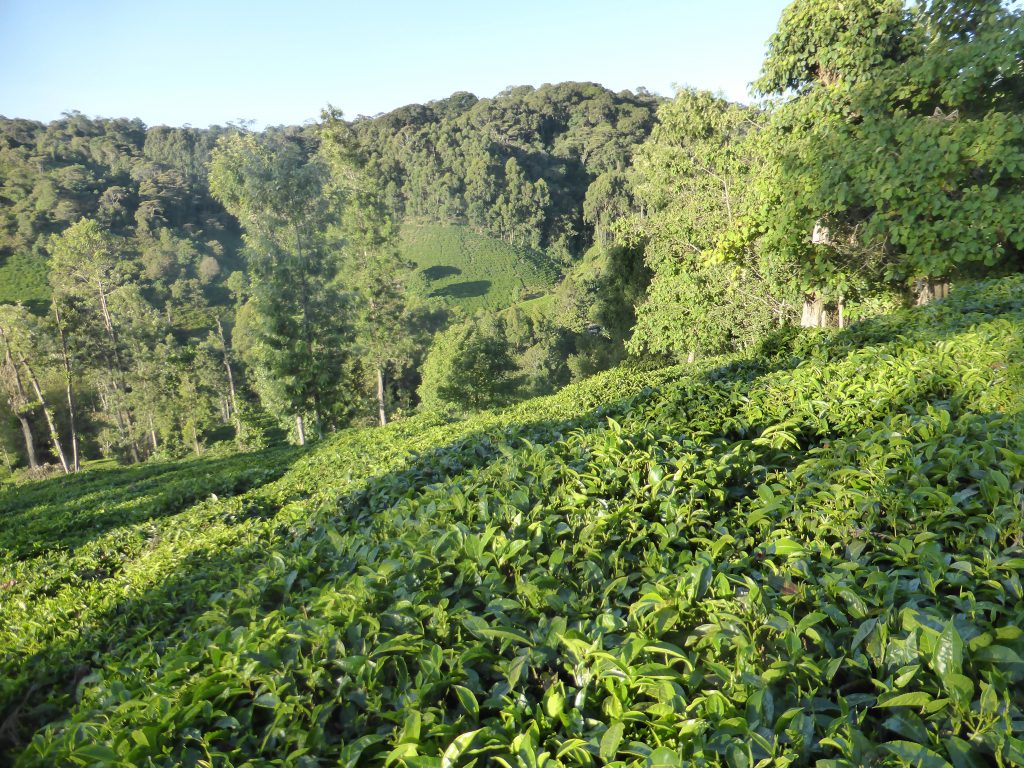
My final day in Kenya consisted of visits to Makena’s relatives, sharing chai and chakula, exploring shambas (it was lovely) before a drive back to Nairobi, and a couple of cheeky beers with Brian and Makena before heading to Nashon’s to pack, eat and head to the airport.
This bonus trip was the icing on the cake – despite all the morning’s grief (and thanks to Makena and Brian’s rescue service!)
Kwale Eye Centre
Having used my Kilimanjaro Hike as a fundraiser for the Kwale Eye Centre, I was keen to visit the centre and understand how the money is used.
I was given a great welcome by the founder, Dr Helen, the staff and visiting ophthalmologist Roger and shown around all the departments (even having my glasses cleaned and adjusted). Helen told me a lot about their work and the challenges they face on a daily basis. Apparently eye trauma (e.g. sticks in the eye) is much more common here than in UK – safety generally is not a high priority and eye protection less so.But the bulk of the work seems to be cataract-related, soling avoidable blindness.
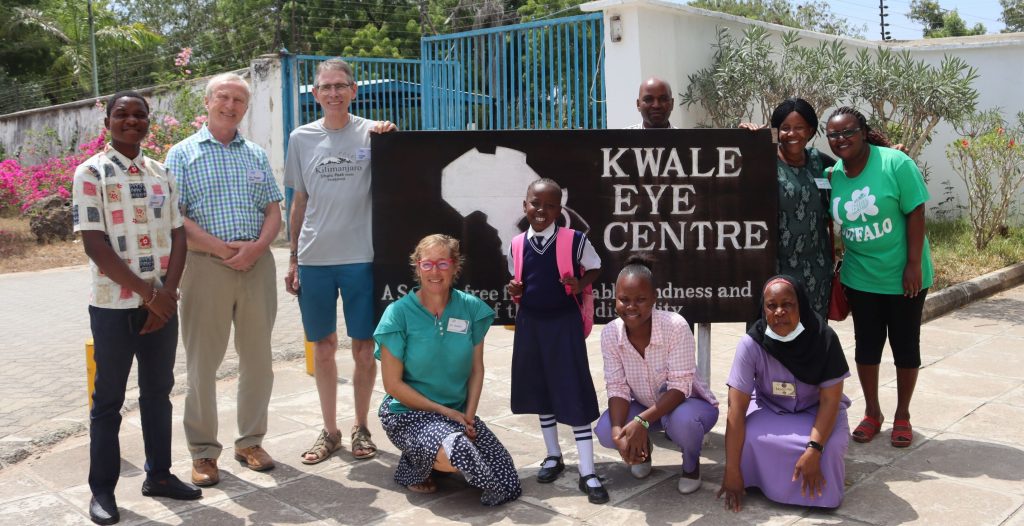
Then I went on a field visit with 2 of the staff, Vera and Mishi. We picked up a field worker by the road and went to visit 3 people who’d had eye surgery to check on their recovery, make sure they had medication. It was interesting for me and also for Vera who is normally office based and hadn’t appreciated the distances involved.
Me with Vera talking to the first patient.
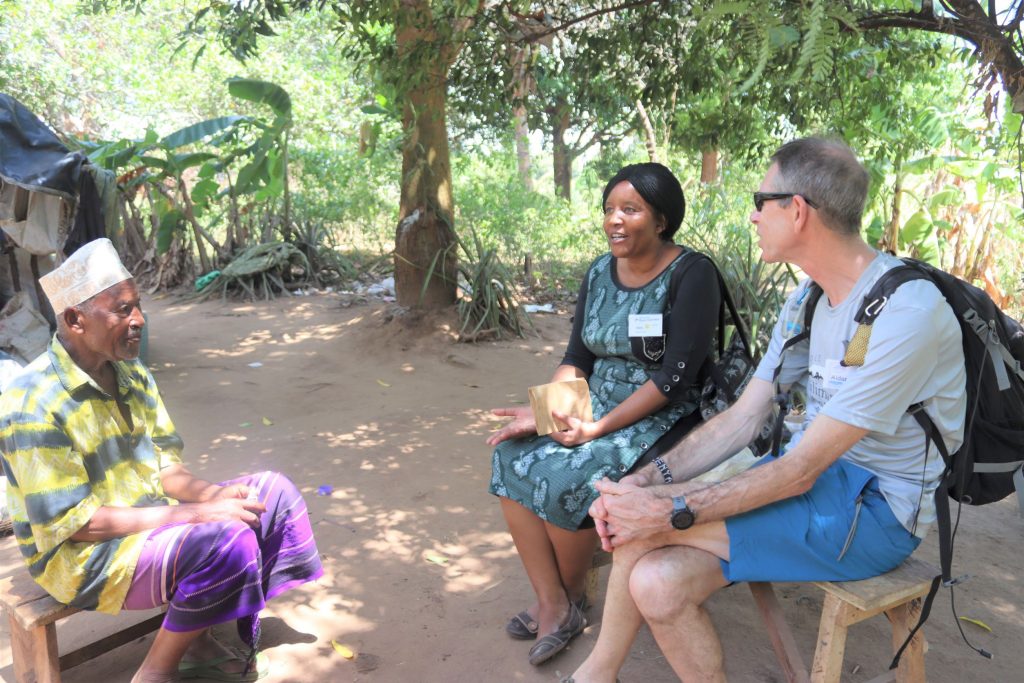
At the second stop, I was given a traditional stool to sit on. It was comfortable for a while!
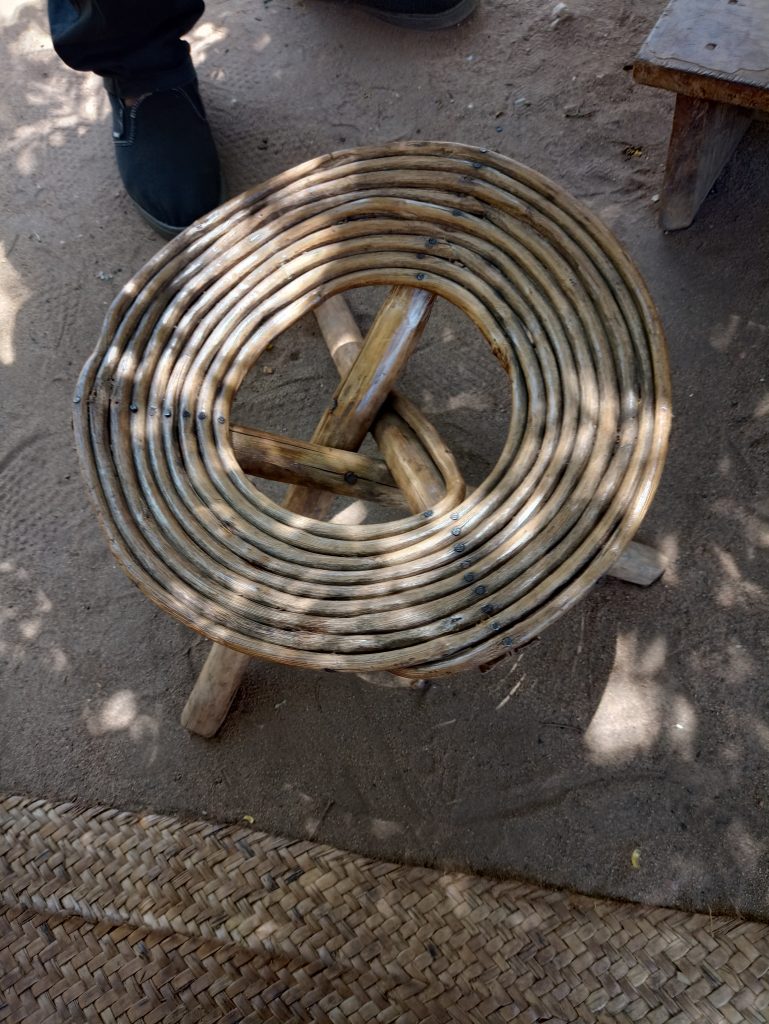
The patient is out of shot – we’re talking with her over her family.
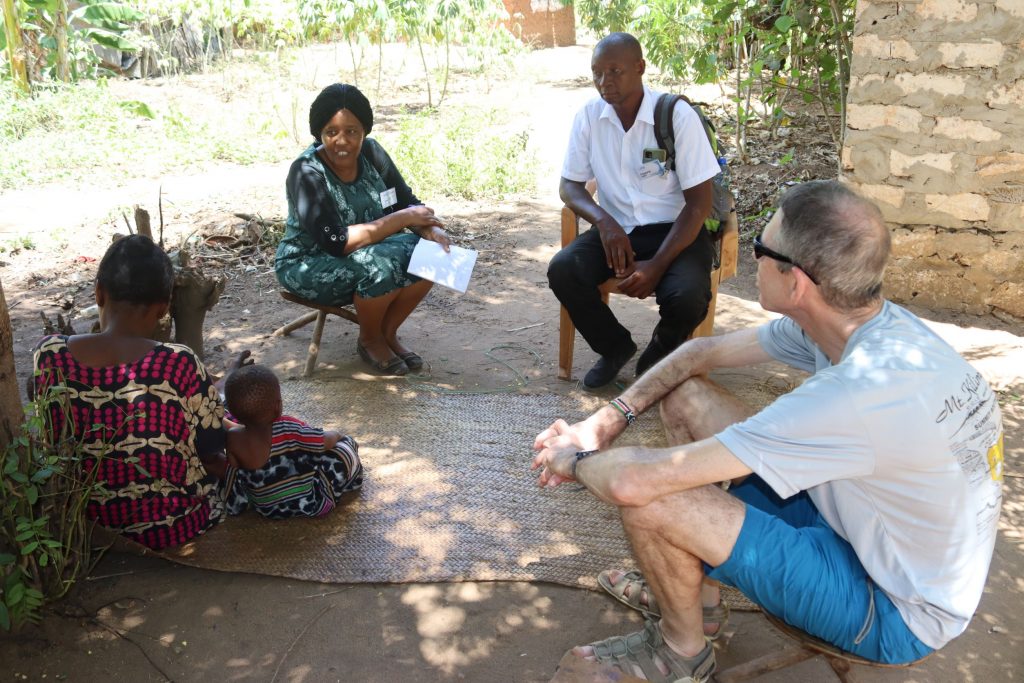
These are the patient’s twin granddaughters: she’d never seen them until after her cataract operation. She was so happy.
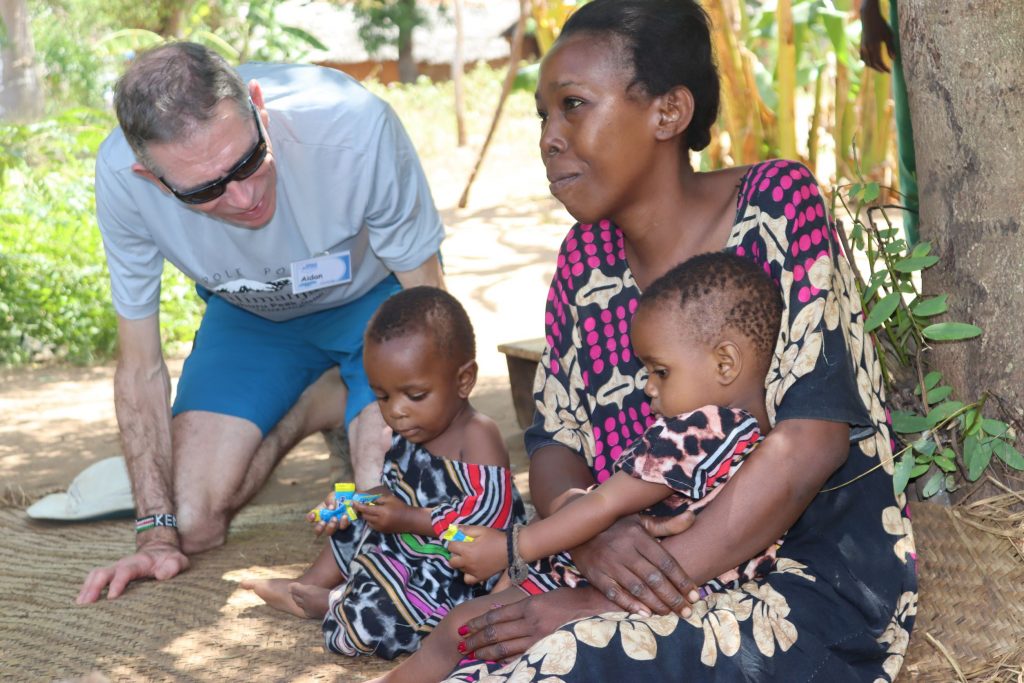

The third patient was a lady (in her thirties I’d guess) with children. When she lost her sight to cataracts she was unable to work, unable to do much for her family, and life fell apart. She was told she was incurable, tried the witch doctor, tried herbal treatment in Tanzania, all to no effect. Then she was discovered by the field worker’s network and was soon treated and is back caring for her family, working as a cook, and happy.
I guess this last bit was the eye-opener for me (pardon the intended pun). I thought access to healthcare was the problem (well, it is a problem), but awareness and education is also a problem. People don;t know that conditions are treatable, or where to get help. As with other illnesses and disabilities (epilepsy, deafness) sufferers are too often considered an embarrassment and hidden away. A bigger part of the centre’s worh than I’ ever imagined is trying to get the word out there that help is available.
Well, after all that driving and visiting (I was the driver) I was hungry, so we stopped for lunch in Shimoni – samaki na ugali.
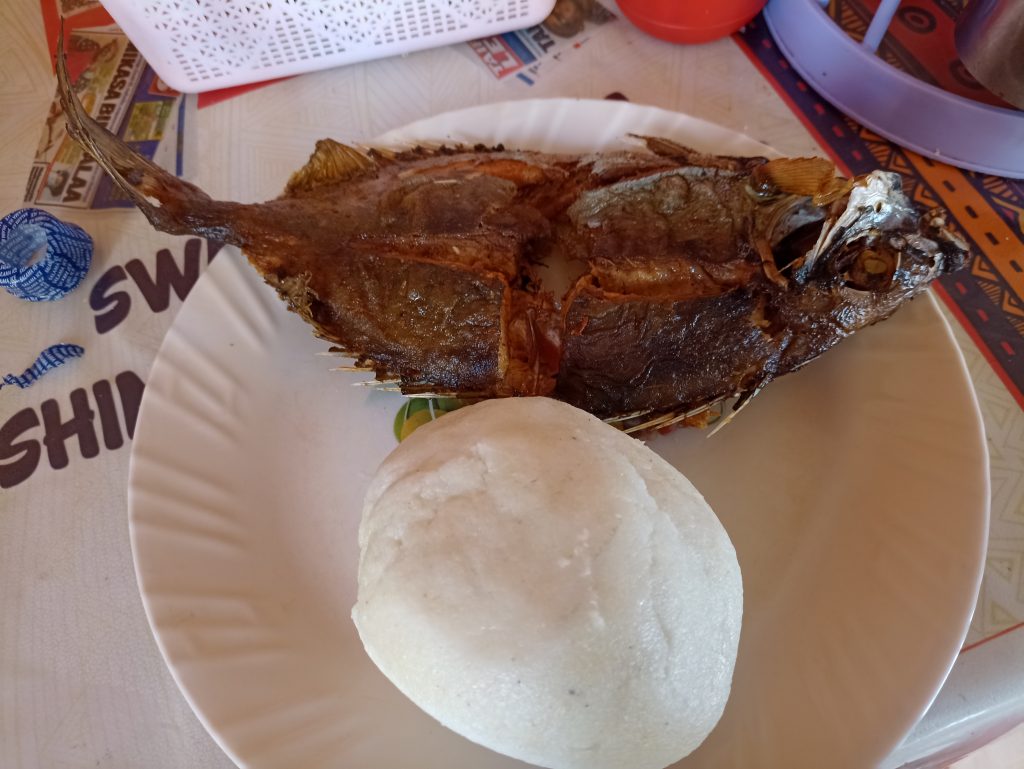
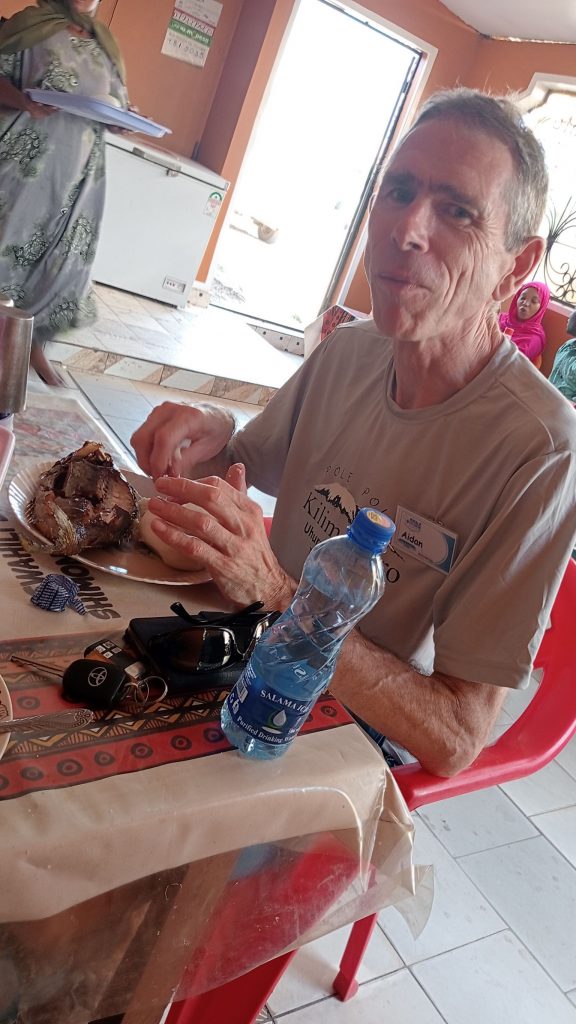
I returned to the Eye Centre on my way north 2 days later, giving feedback on the field visits to the doctors, then touring the departments again as a patient – glasses check, eye exam, then being used as a training aid by Dr Helen showing students what Fuchs Dystrophy looks like.
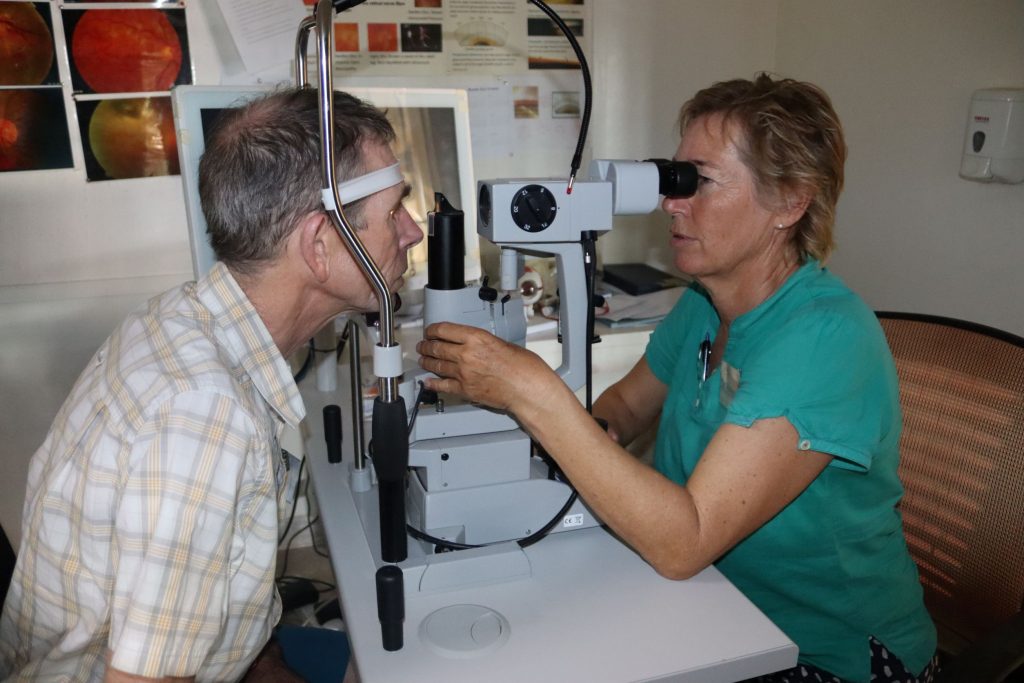
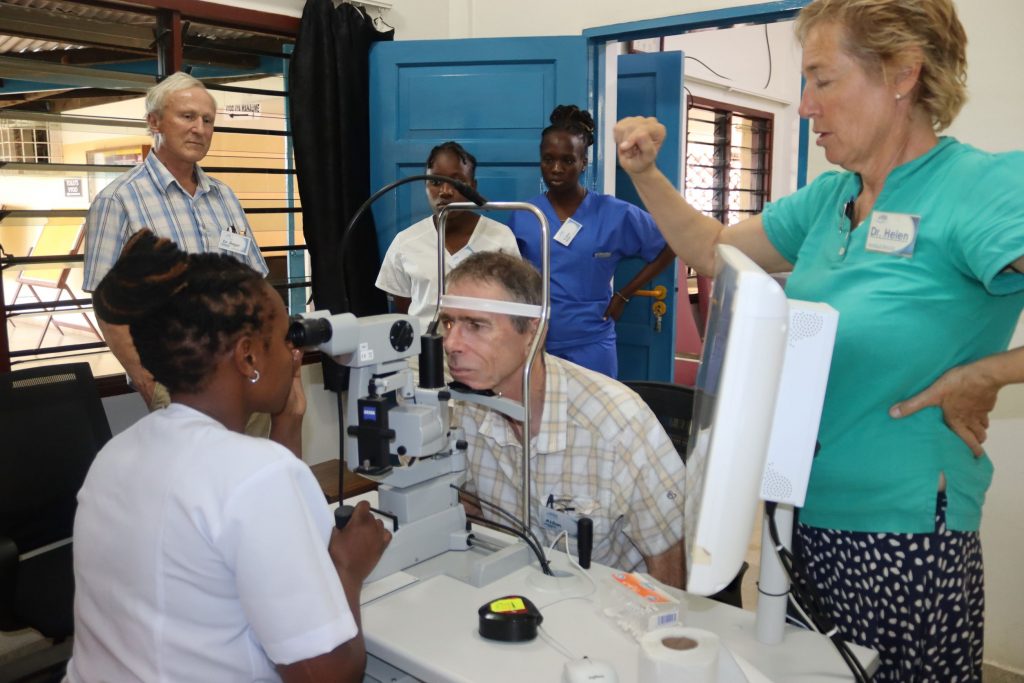
Thanks to Mishi who took all the photos (and is therefore in none!)).
Malindi Visit
A week after out Kilimanjaro adventure I drove up to Malindi to meet fellow hiker Joyce who wanted to show me the sights.
First stop (after breakfast of course) was Marafa (Hell’s Kitchen), a canyon in the sandstone with spectacular colours. The soft sandstone has been eroded to great effect.
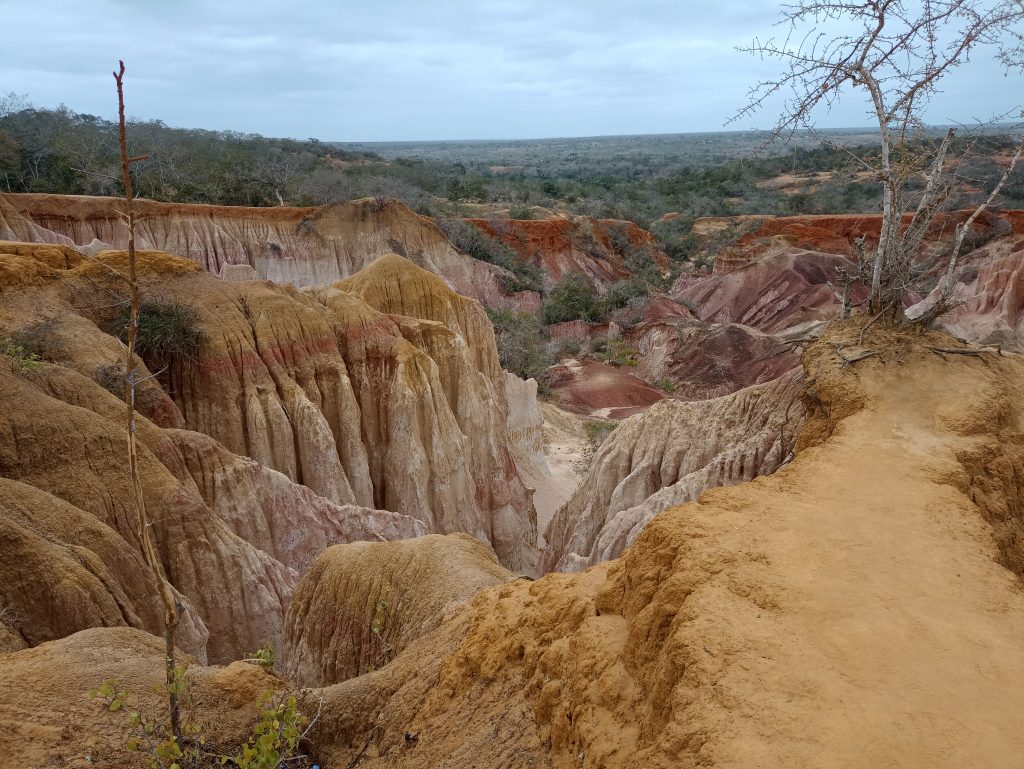

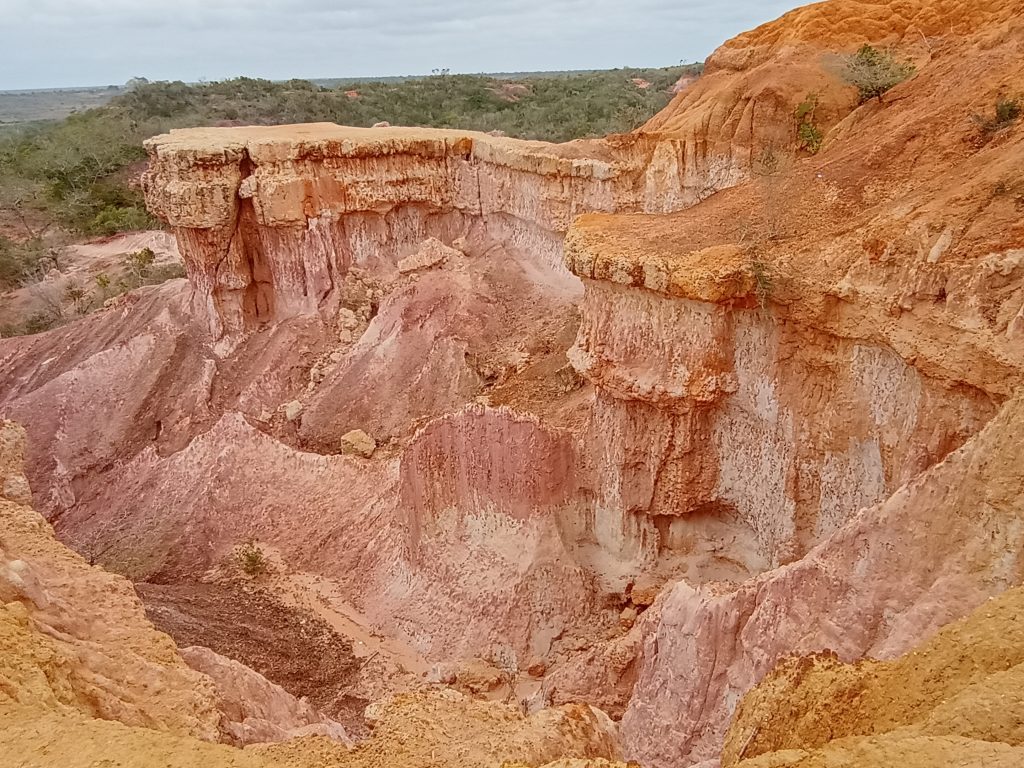
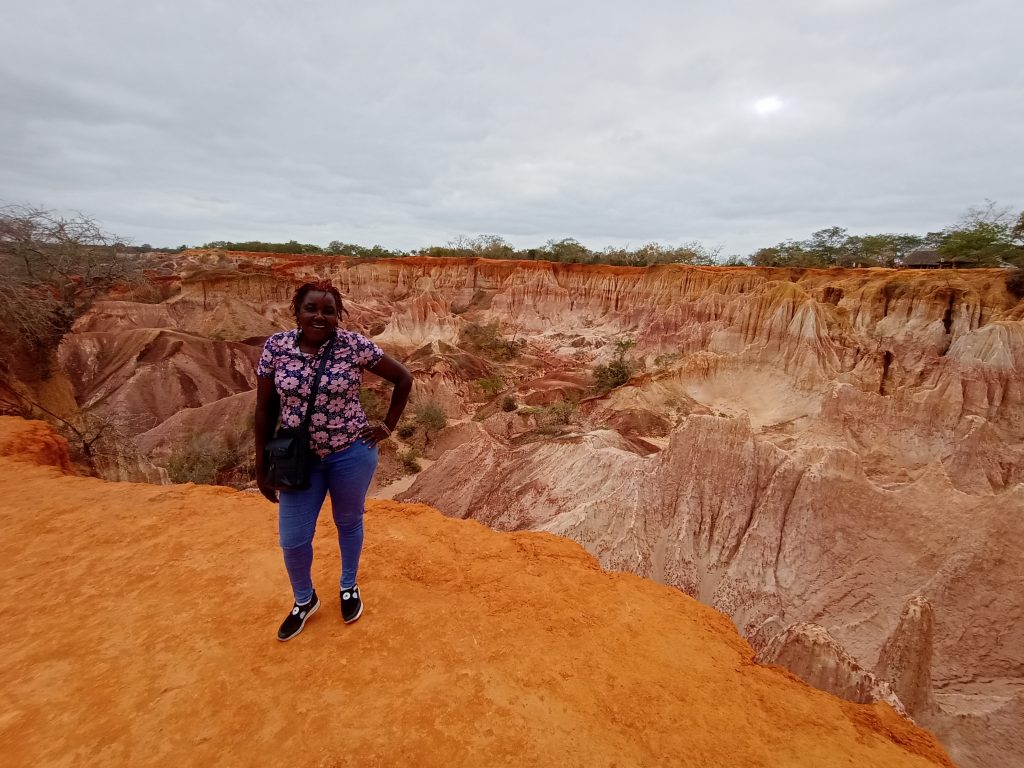


The soft sand was traditionally been used for body paint (red, yellow and white). Here we compare the appearance on differing skin colours.
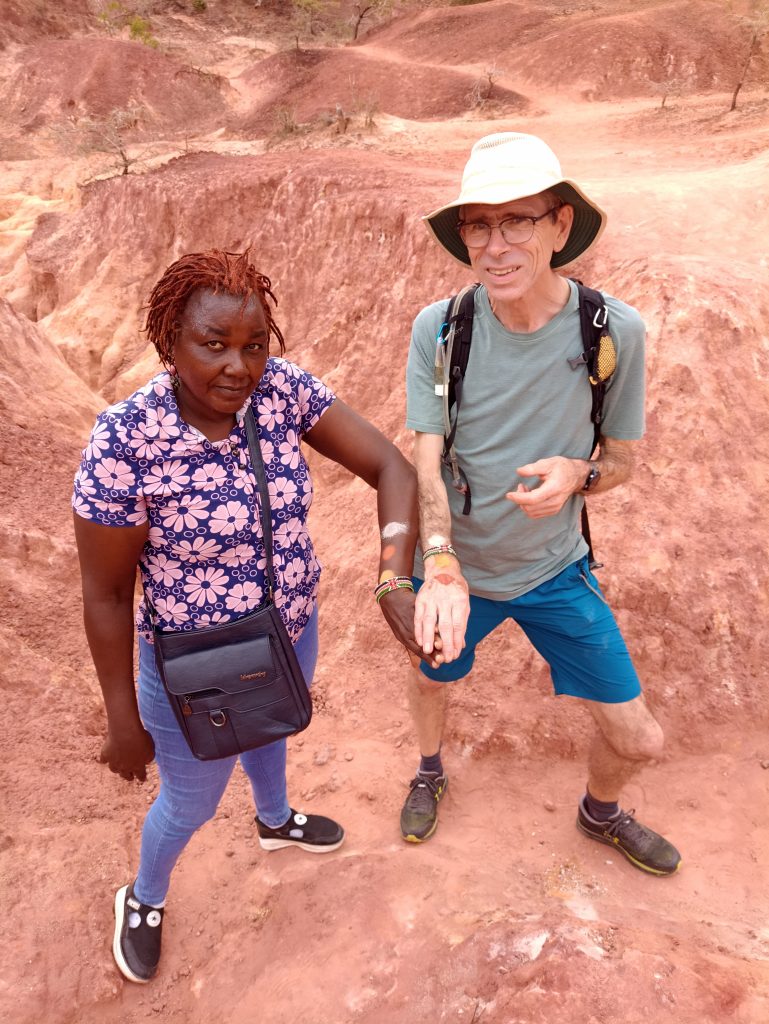
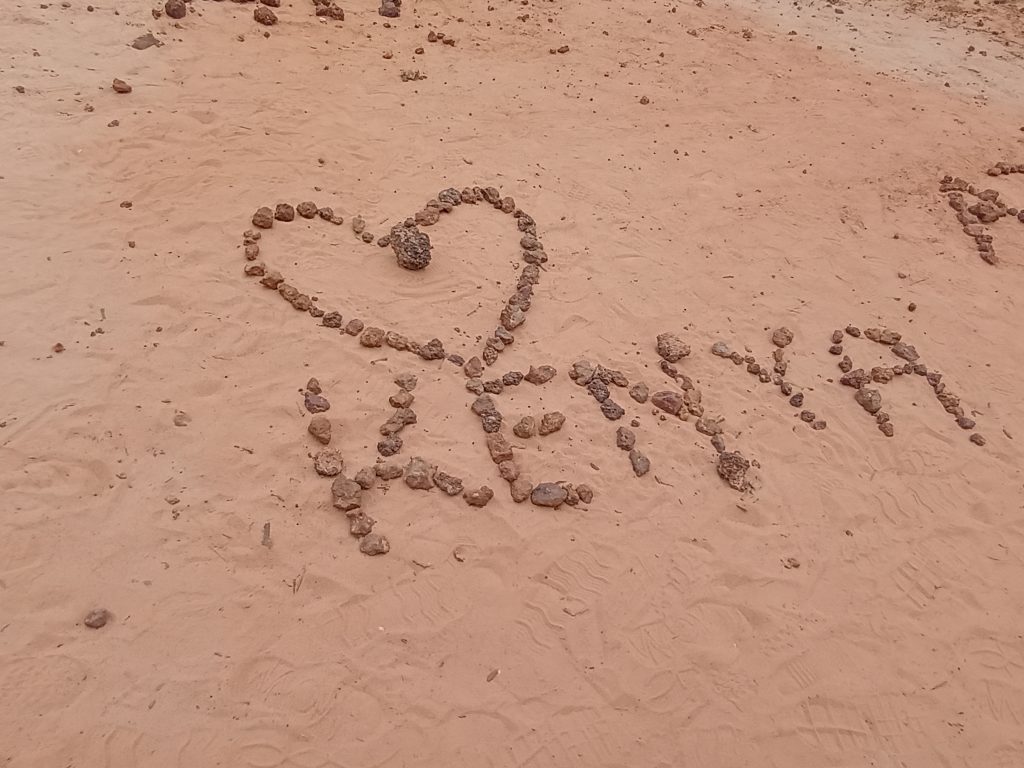
From Marafa, back through Malindi and Gede to Medi where we had fish lunch on the beach before trying the elevated boardwalk through the mangroves. I have to say this was more alarming than anything we’d encountered on Kilimanjario!

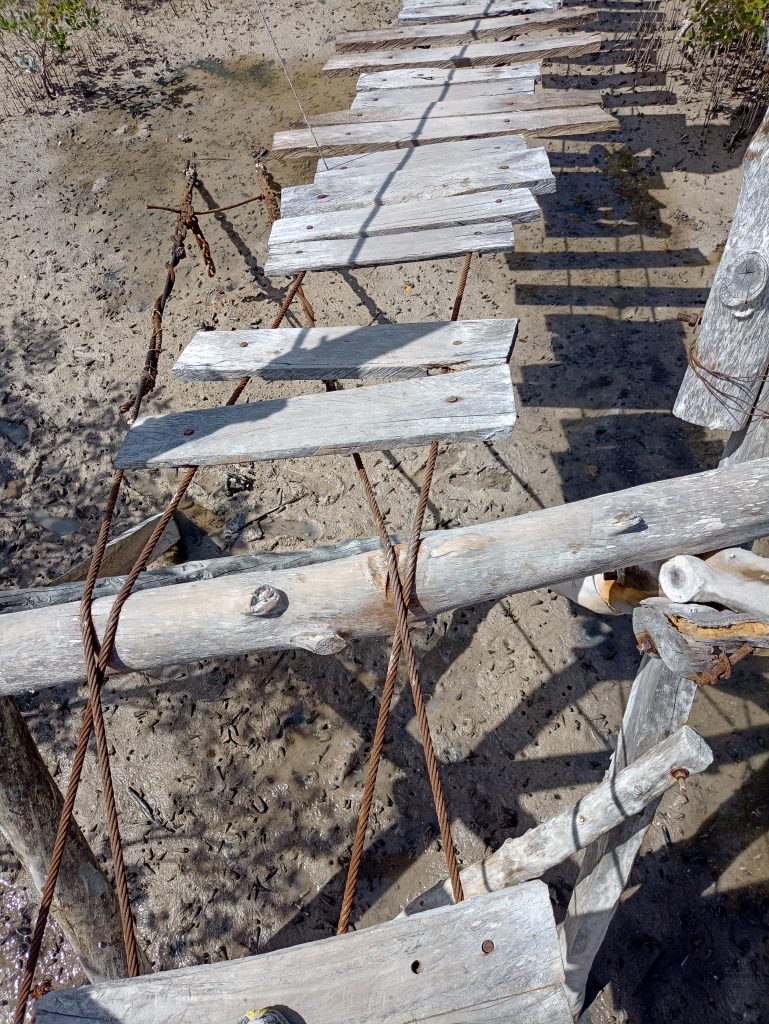
From Medi to Watamu for a swim and a run on the beach (avoiding kite surfers and their strings)
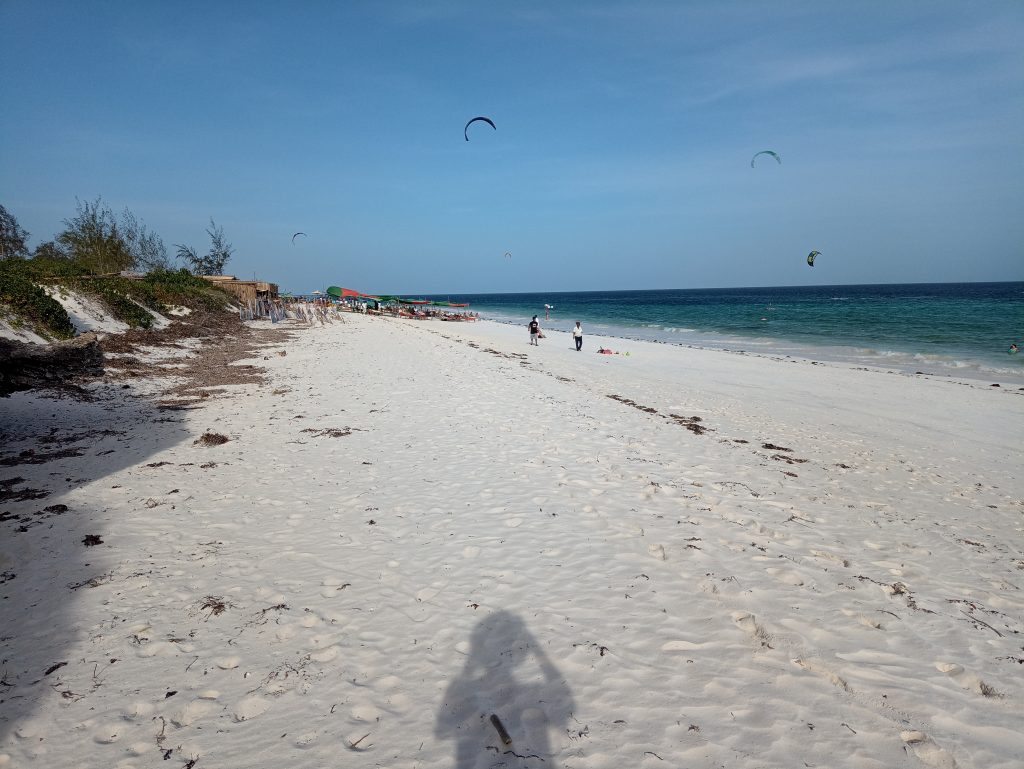
After an excellent coffee and gelato (Non Solo Gelato, Watamu) we headed to Gede ad a road alongside the Araboko Sokoke forest to see the elephants coming for their evening drink. Light was a bit low, but you’ll get the gist.
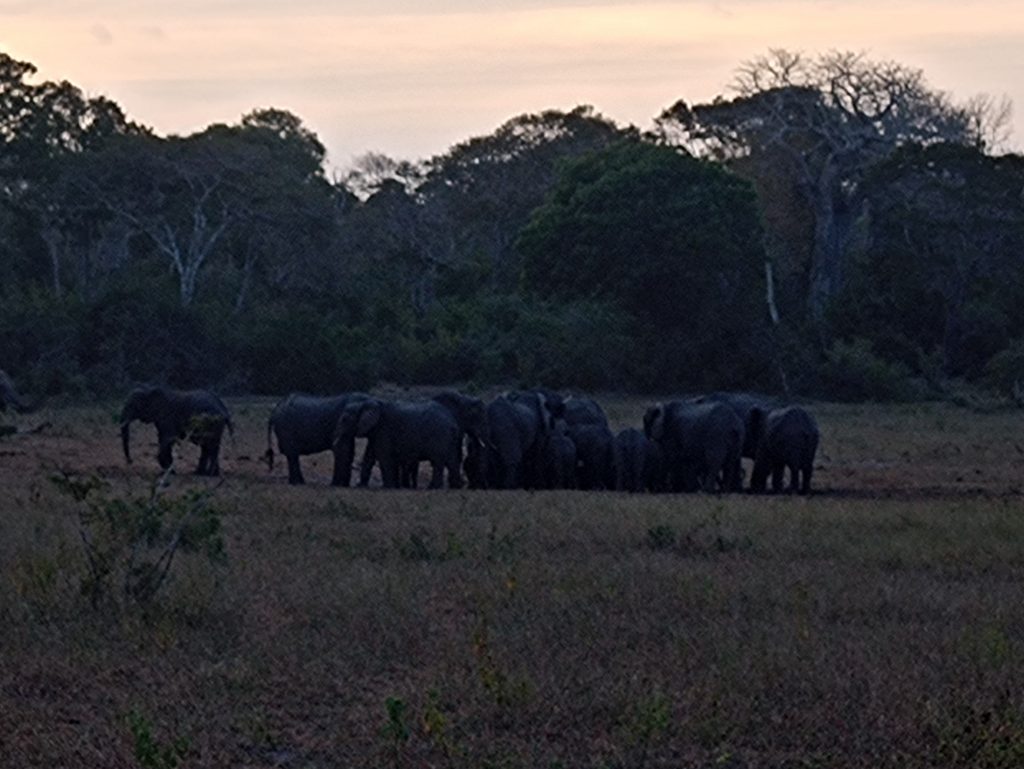
Next morning, before heading south again, we went to Malindi Beach for a swim and a walk .
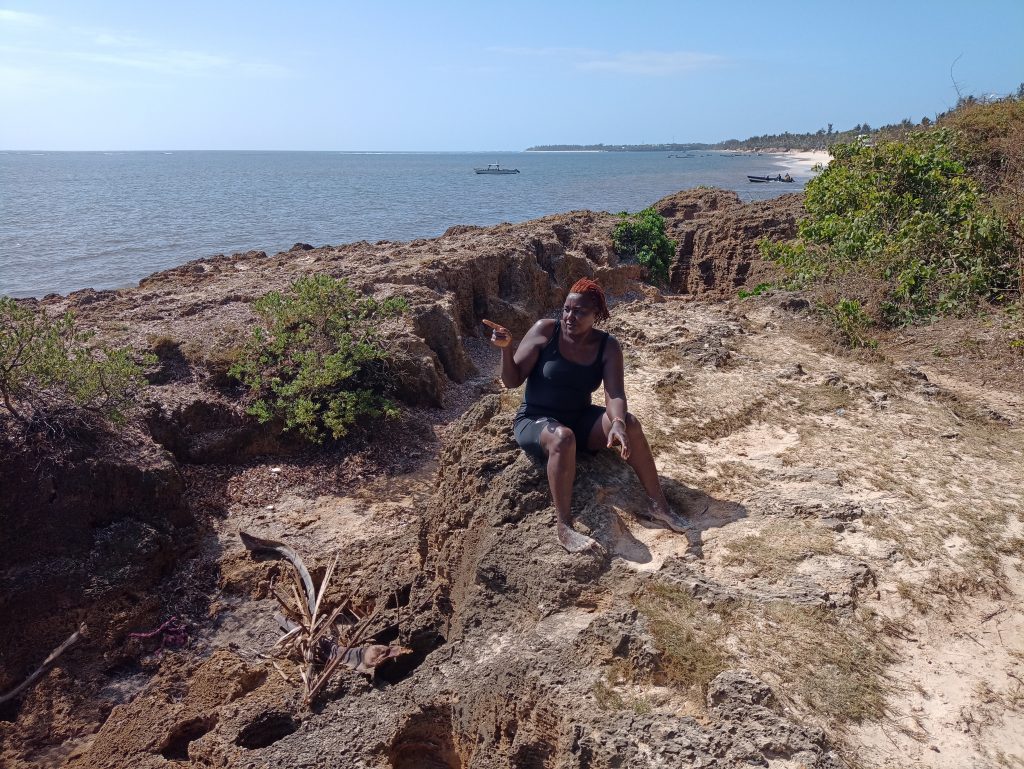
Rounded off with a glass of passion juice
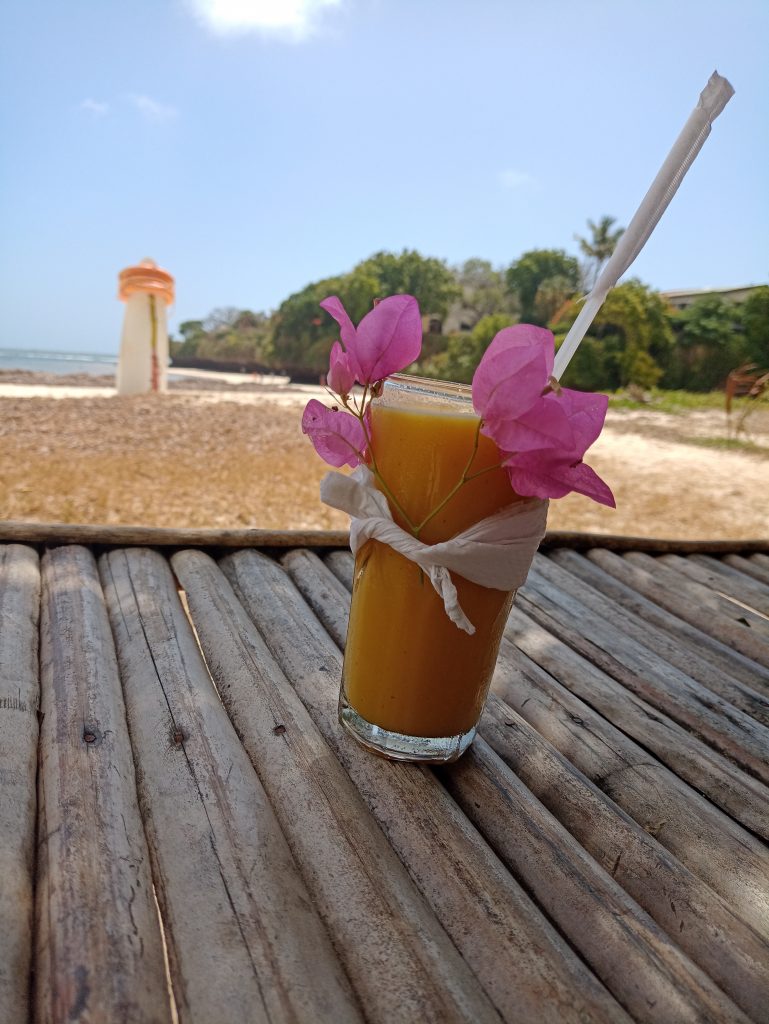
Kili Day 6: Millennium Camp – Mweka Camp – Mweka Gate
A sunny morning, so the solar charger was working well.

A great view of the mountain as the camp was dismantled for the last time.
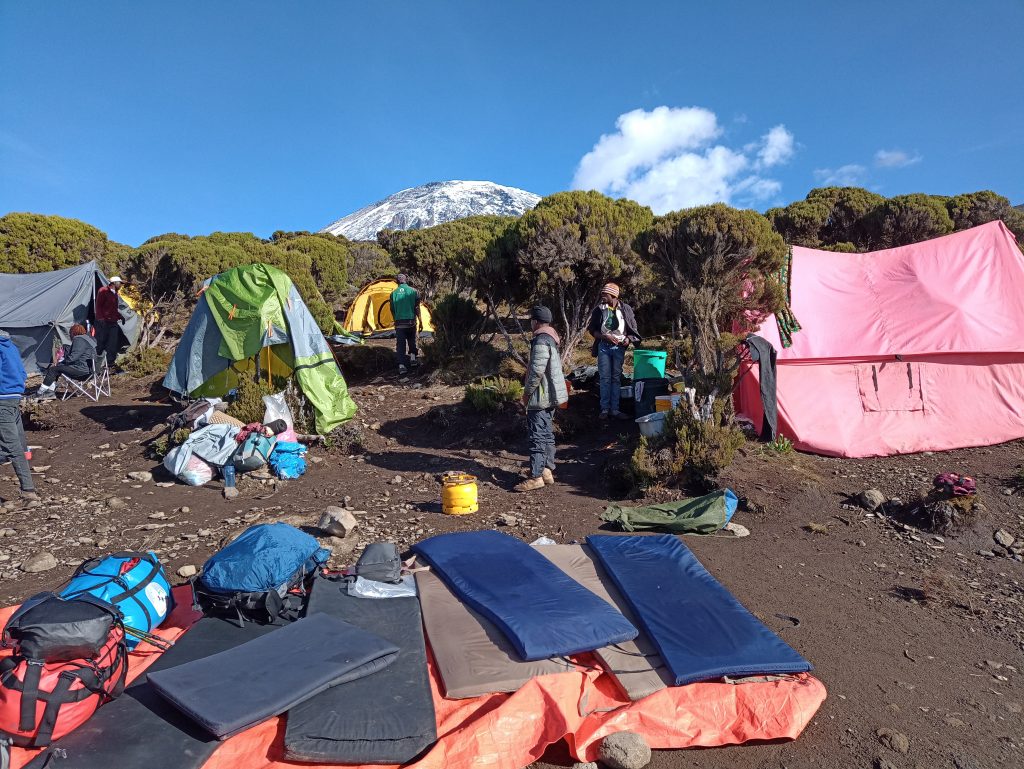
Time (and weather) to take tea outside, though we’re still at high altitude.
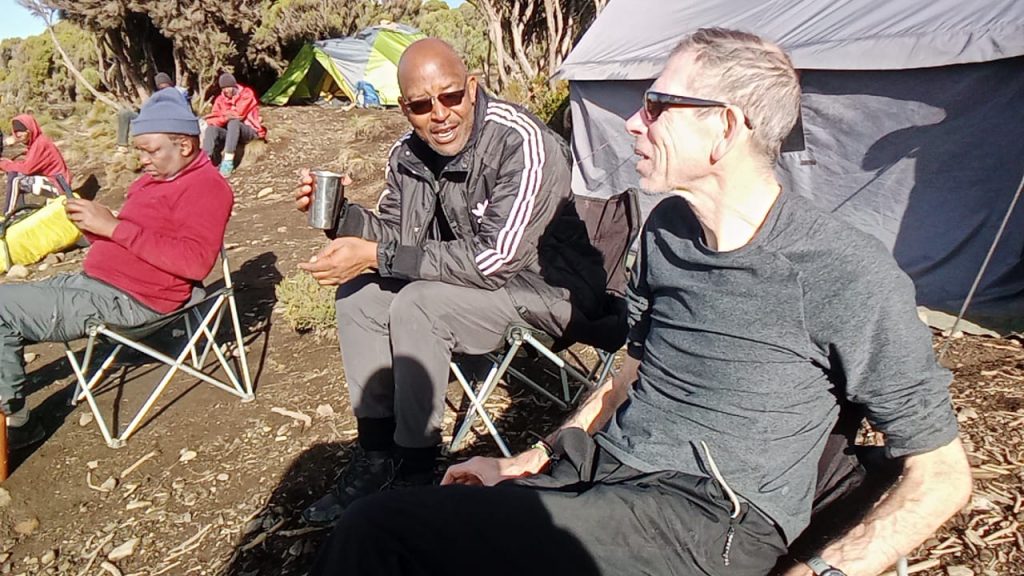
This is how you get the dust out of a tent (also works for late sleepers)
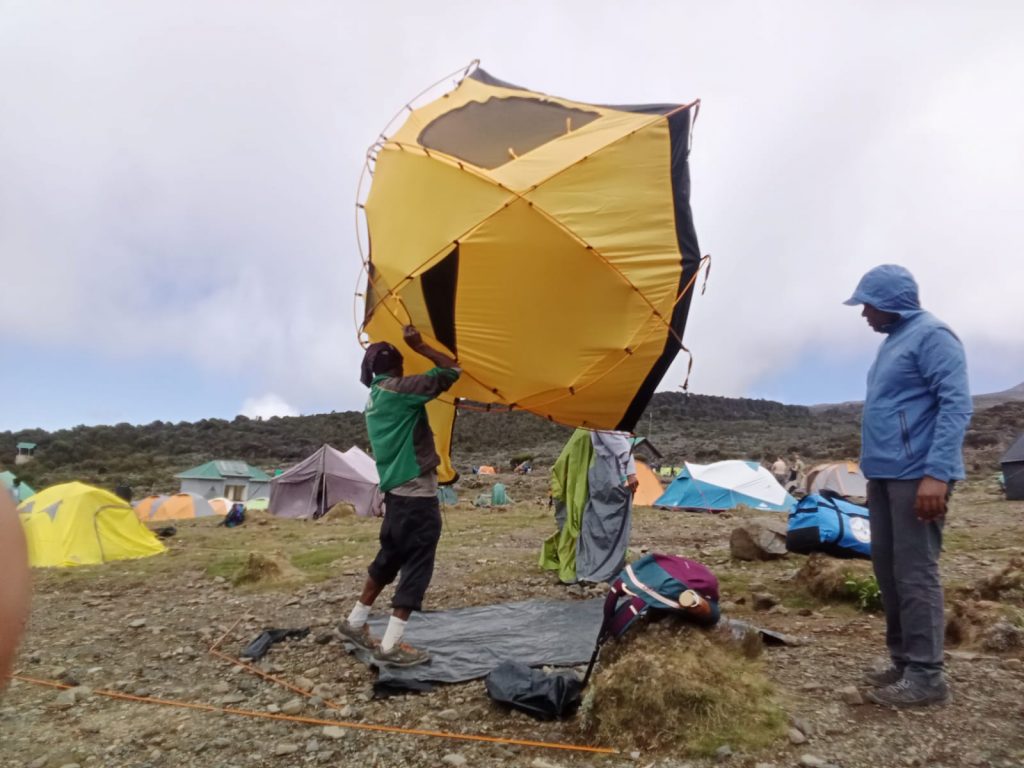
Ready to descend
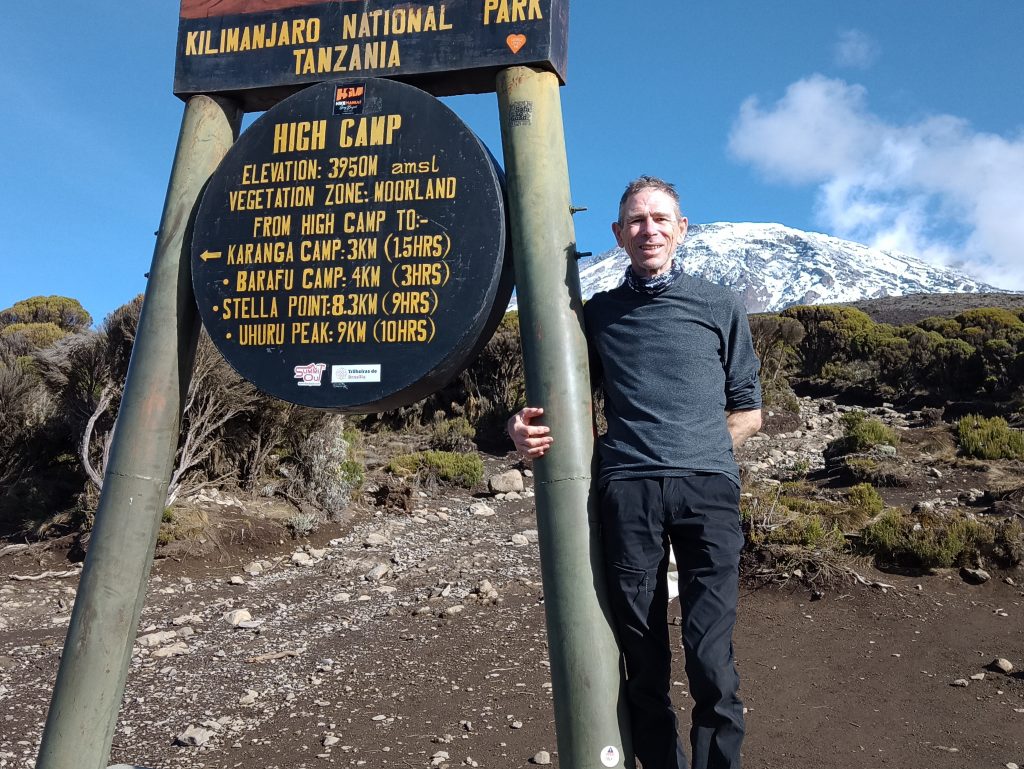
Farewell my friend
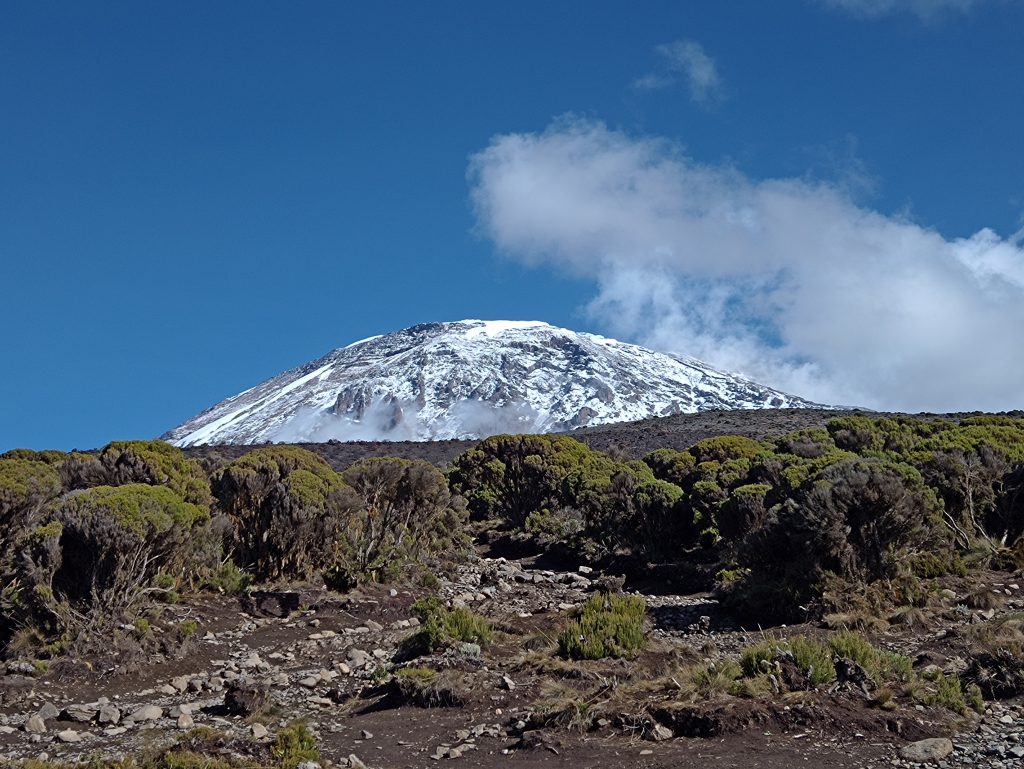
The descent started through moorland (as you can see in the above pictures) down to Mweka Camp. At this point I was on my own with everyone else ahead of me (I thought)

After Mweka Camp we were back into the rainforest, luxuriant and green, though steep and rocky at times. i was hurtling down, keeping with (even overtaking) the porters, with a few pauses for the scenery.
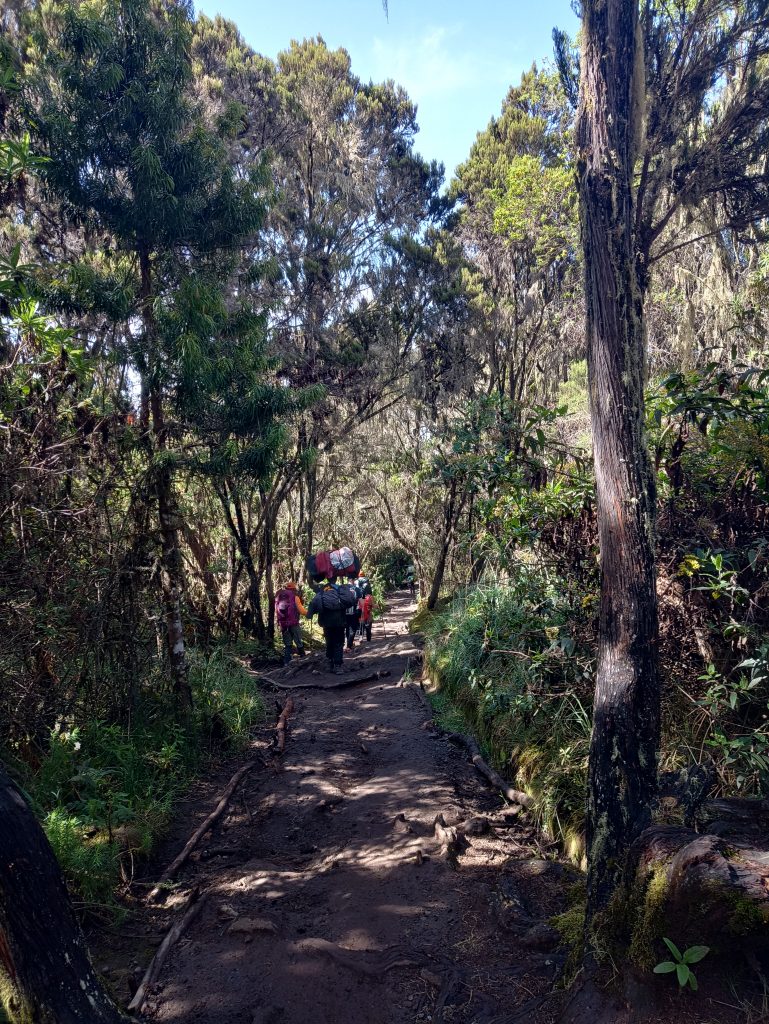
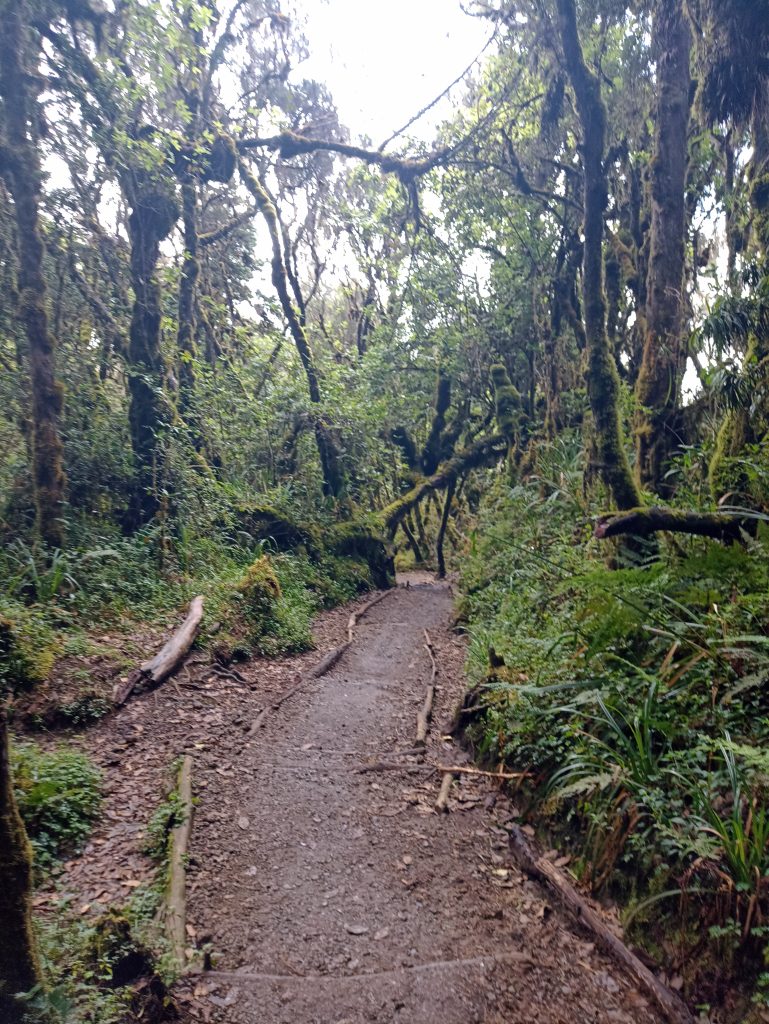

I rapidly descended to Mweka Gate – the end of the trail.

Here I met Mox, our steward, and we shared a beer (well deserved, especially on his part). This is when I learnt that somehow everyone else was behind me – like hours behind me – so we sat and supped until they caught up.
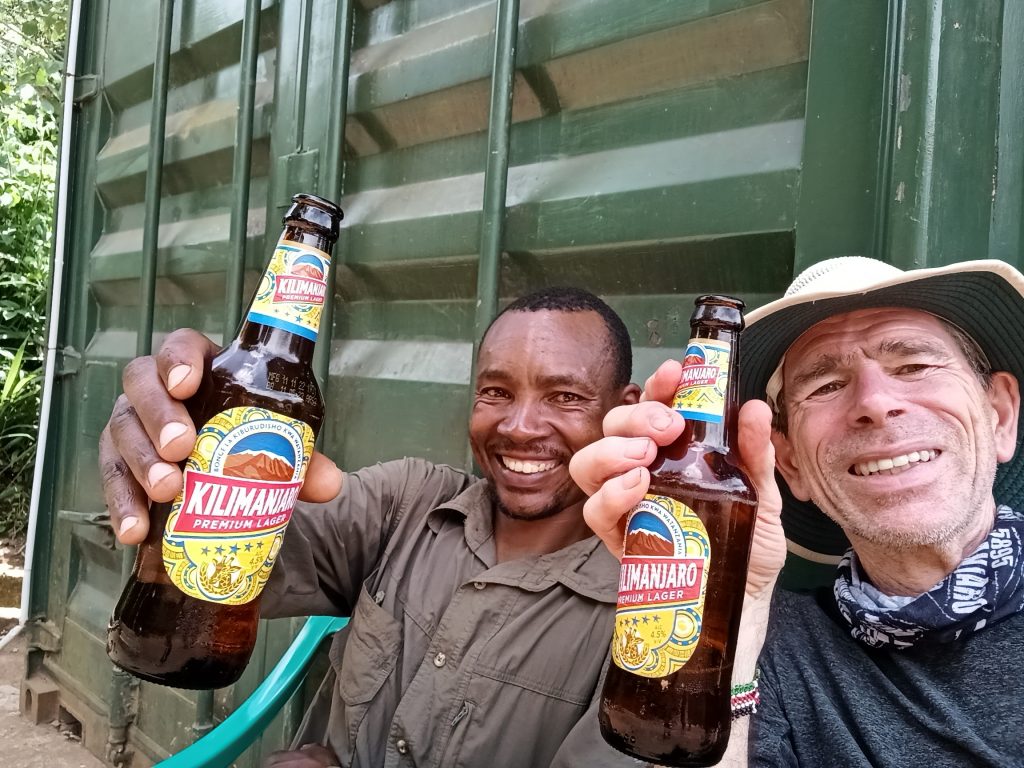
Then we all had to be officially signed out before being taken to an eatery nearby for lunch (now late lunch) and a chance to buy souvenirs and thank the team who’d supported us so well.
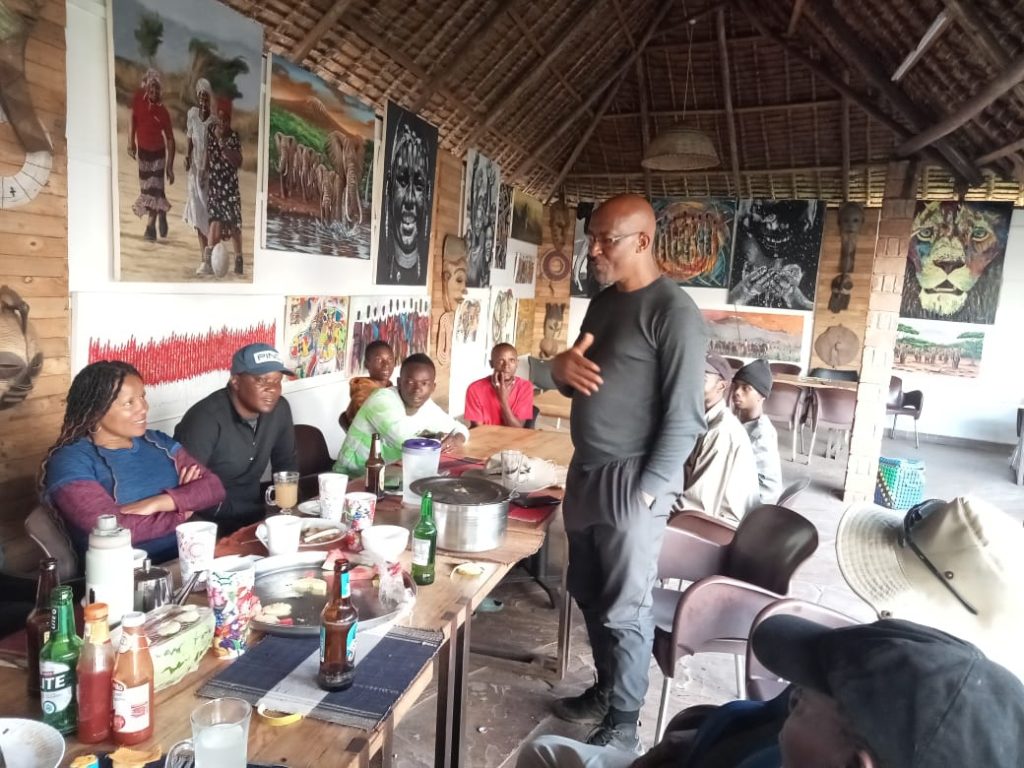
And then, back in the bus, via the hire shop to the Zebra Hotel in Moshi where we were awared our certificates of achievement by Ulrick, the head guide.
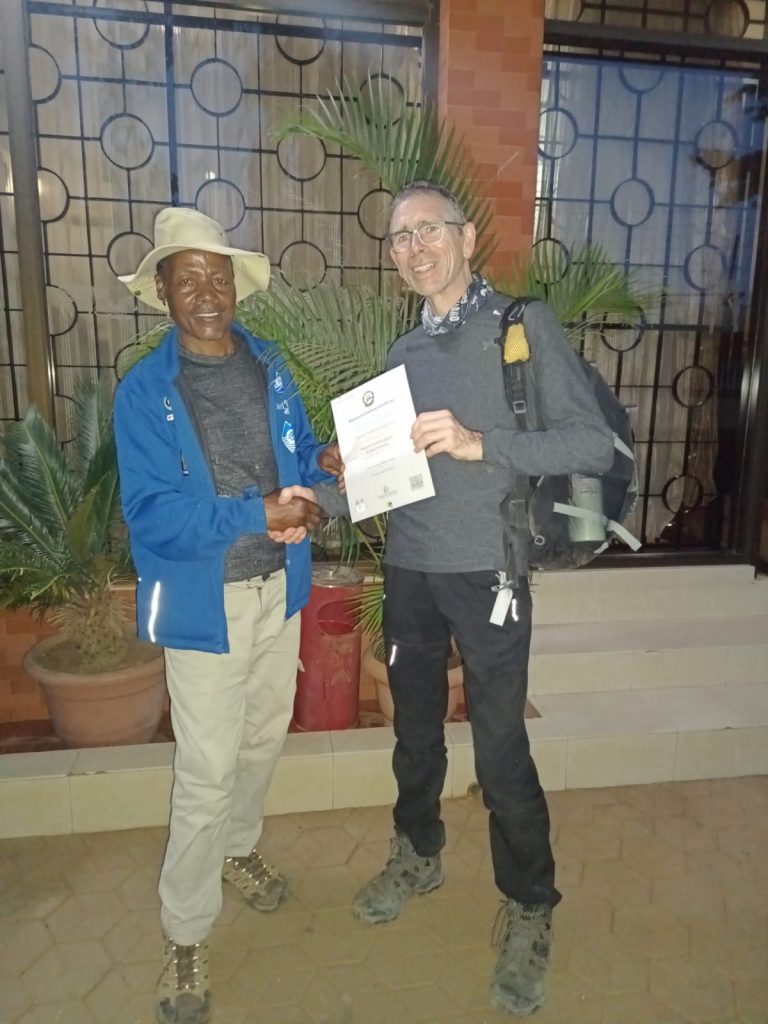
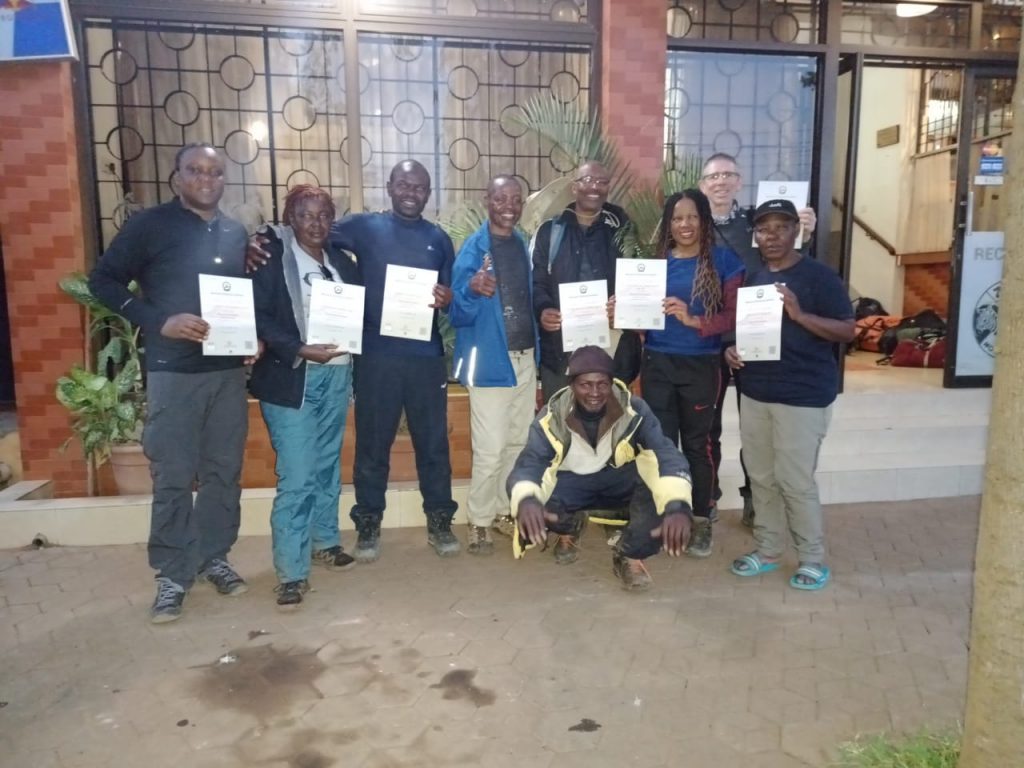
And then … shower (first for a week), dinner, more beers, bed (first for a week), repacking AGAIN. Saturday morning we were taken to the Kenyan border at Holili where our ways parted.
Kili Day 5: Barafu – Summit – Barafu – Millennium Camp
https://www.outdooractive.com/en/route/hiking-route/kilimanjaro-summit/260267160/
Our final ascent started at 00h30, in darkness, with us all lighting our way with headtorches. A snake of guides and hikers, among other snakes (other parties) all making their way up the mountain. We were already a good way up the mountain, which stands high above the surrounding land, and it was a clear night. There was an amazing view of the twinkling lights of Moshi way, way below us.
We continued in our snake for some time, walking polepole as instructed, but Coach Steve had an urgent call of nature and the group fragmented. I guess they didn’t want us all standing around in the cold (and it was pretty cold, though it didn’t penetrate my layers of insulation). Engr Anthony and I found ourselves with a guide who didn’t seem to have received the polepole briefing and we found ourselves asking him to give us time for breath. In the thin air, everytime I stumbled and gasped I had to wait and get my breathing back under control. The guide was helpful, carrying things like water bottles but we might have set a more realistic pace.
Talking of stumbling, i did quite a bit of that as in the limited light my depth perception was poor, and there was no shortage of odd rocks to trip over.
We weren’t quite at the top when the sun rose, but it was pretty spectacular.

It was pretty tough. As we neared the top I was getting confused (e.g. asking Nashon “where has Nashon gone?” and at Stella Point (where we met the rim I wanted to sit down but wasn’t allowed. We got some photos, but what happened thereafter is a bit of a blur until sometime later we were descending.
View into the crater.
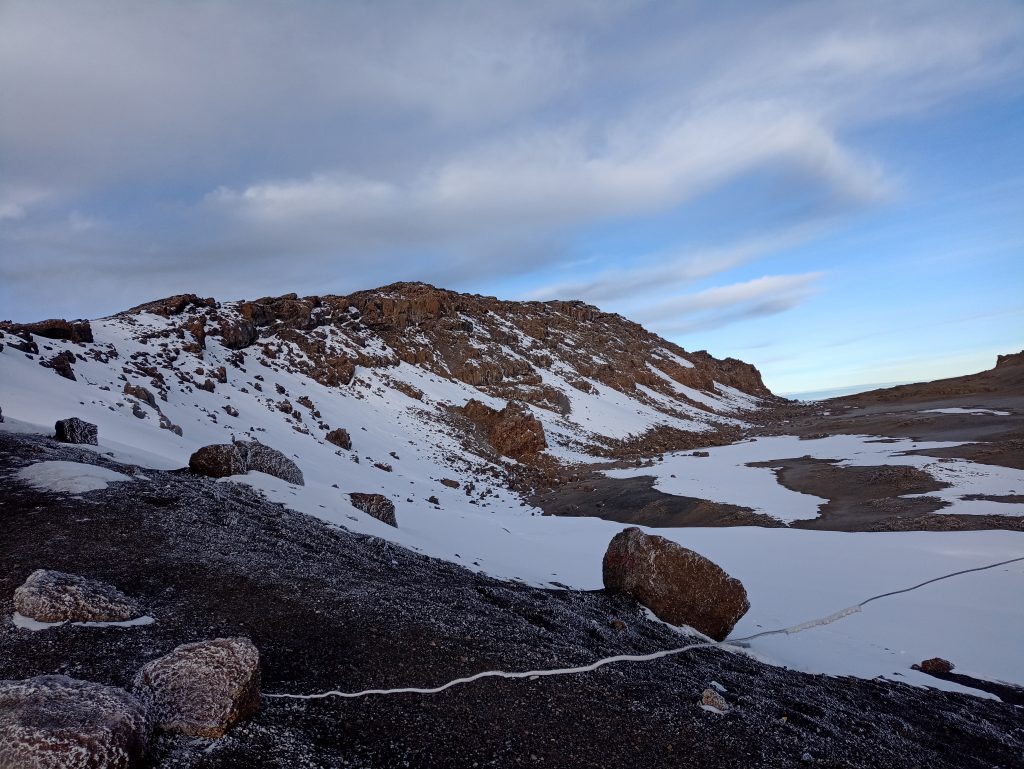
Me at Stella Point
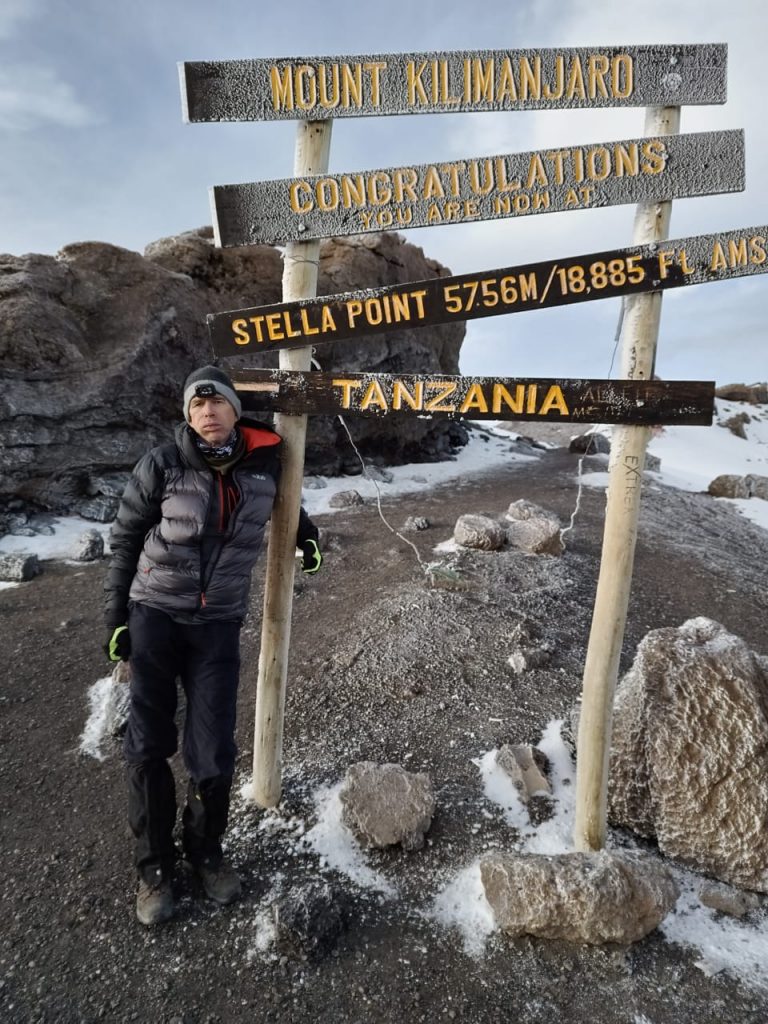
Me on the rim, more confused than usual.
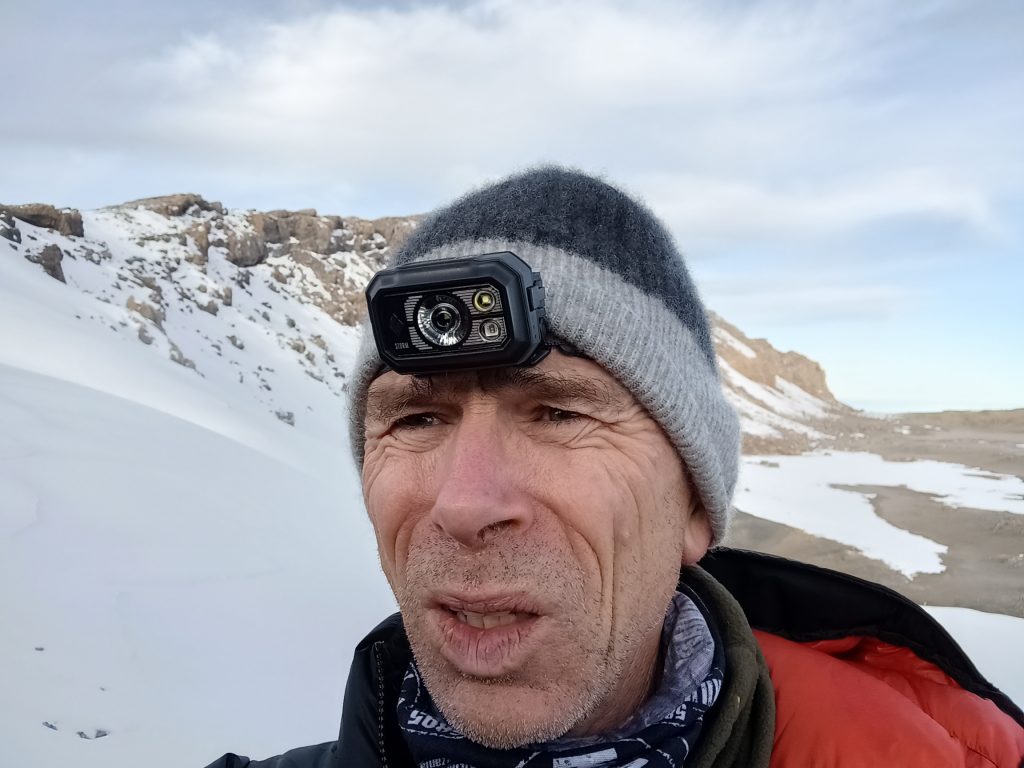
Approaching the summit.
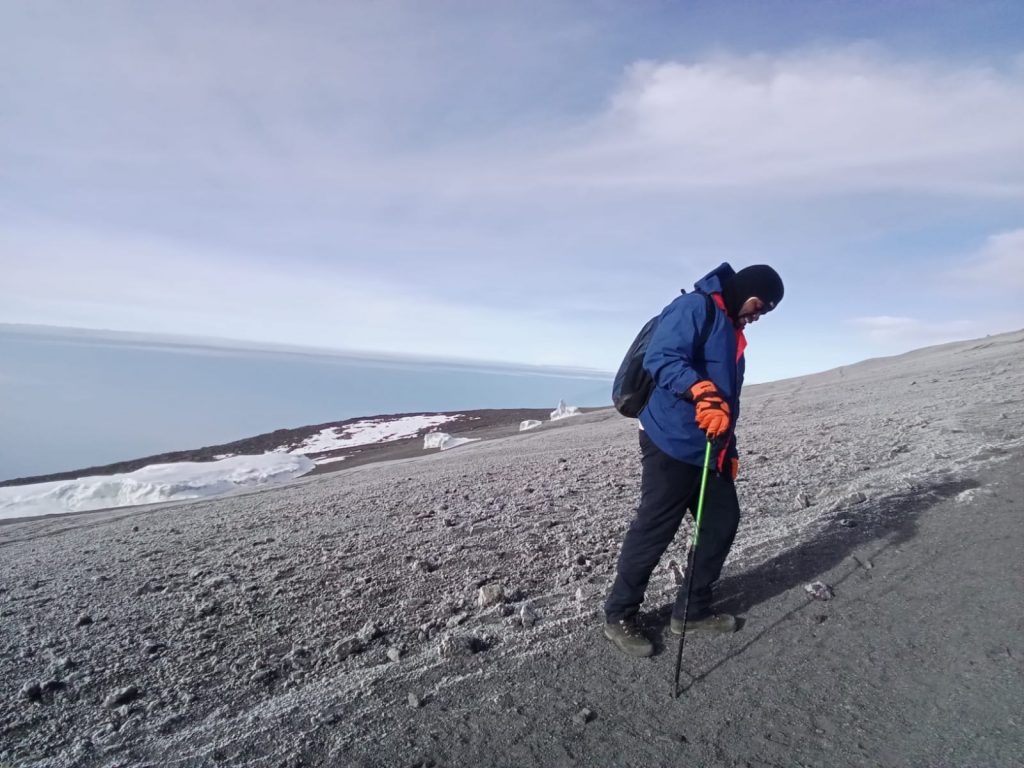
Uhuru Peak

Starting the descent

As you descend (in daylight) you get better views of the hill around you., if only you can stop to take a photo, and preferably not get your dayglo glove in the way.
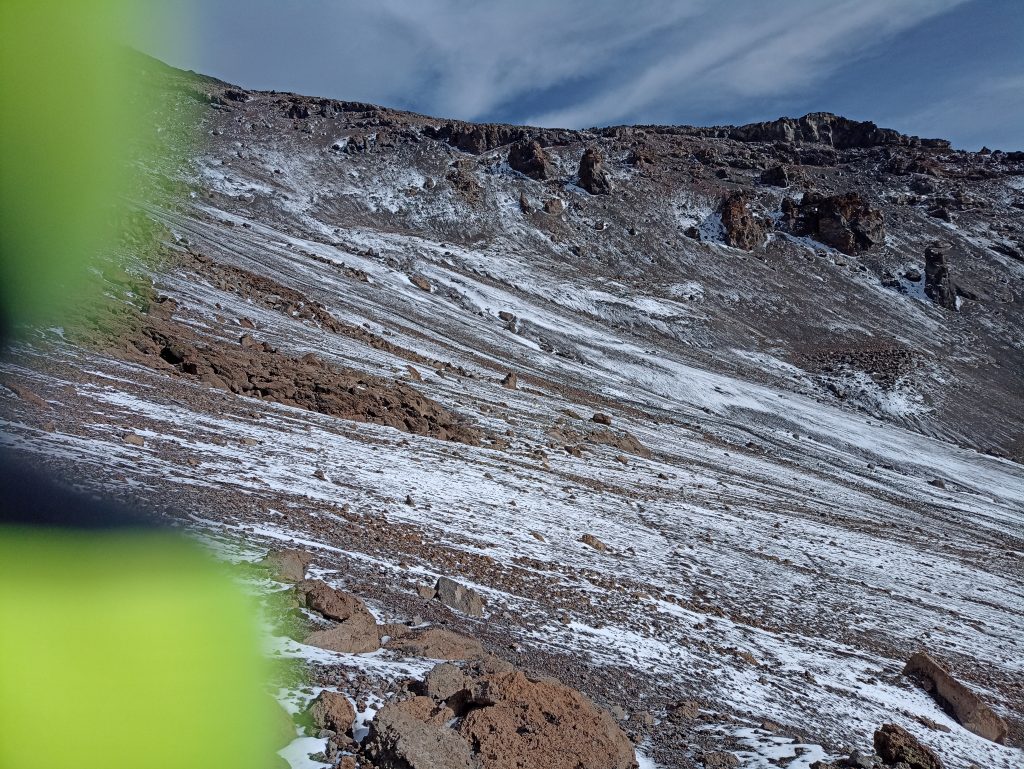

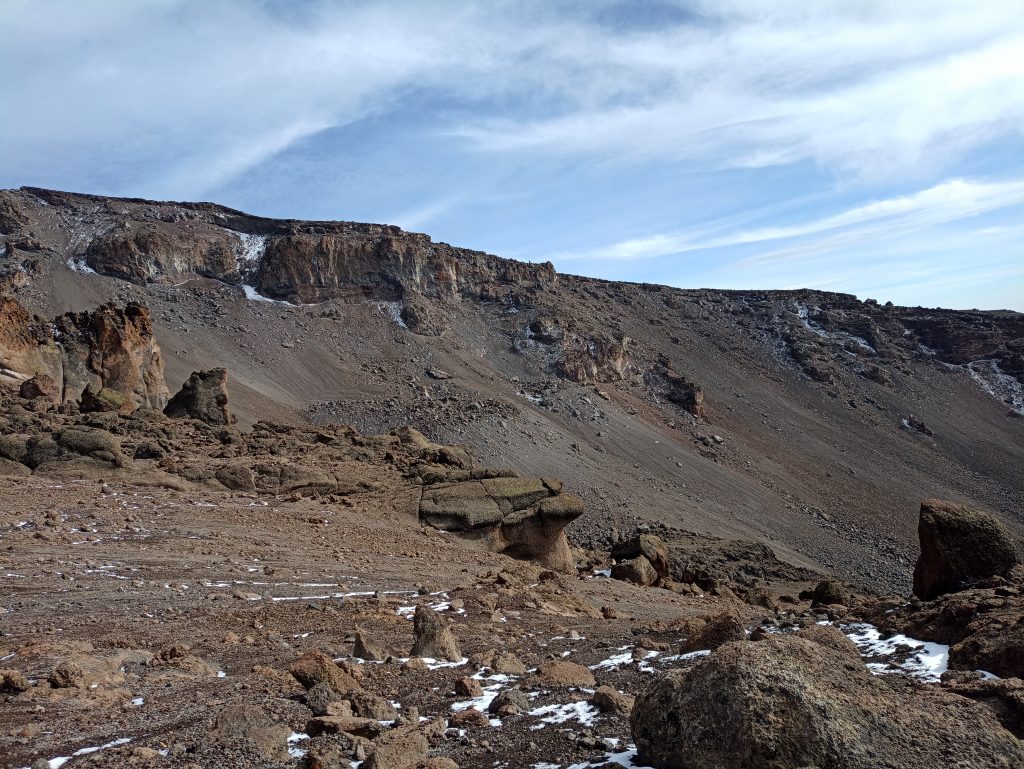
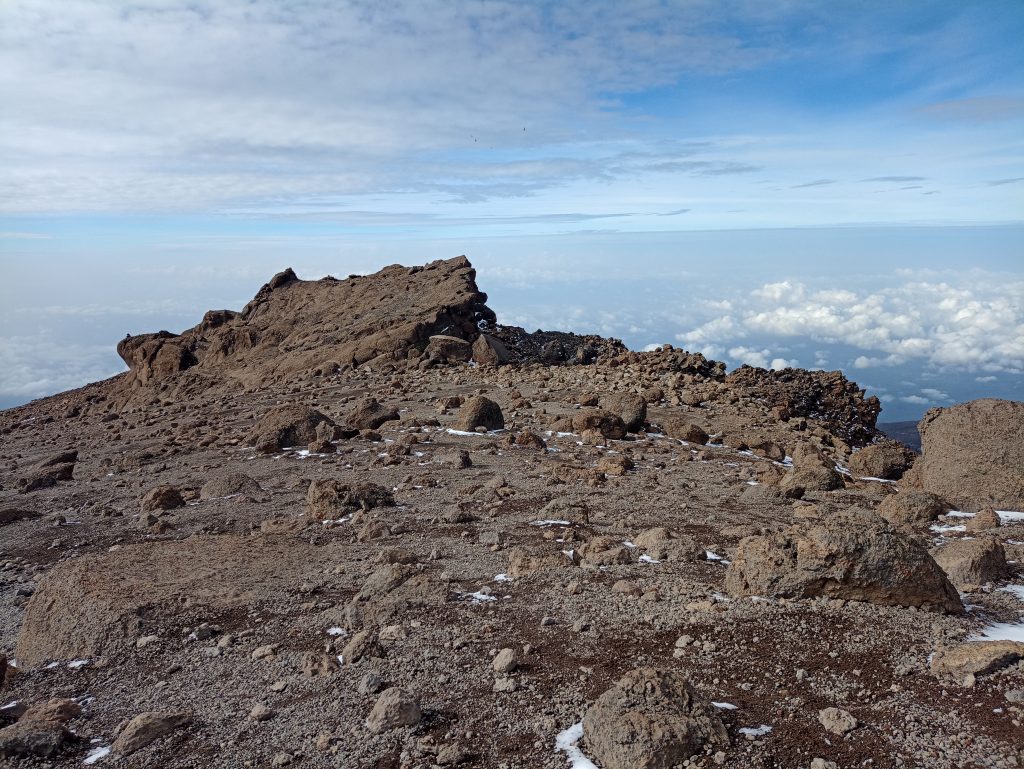
Approaching Barafu Camp from above, our line of yellow/green tents in the middle.
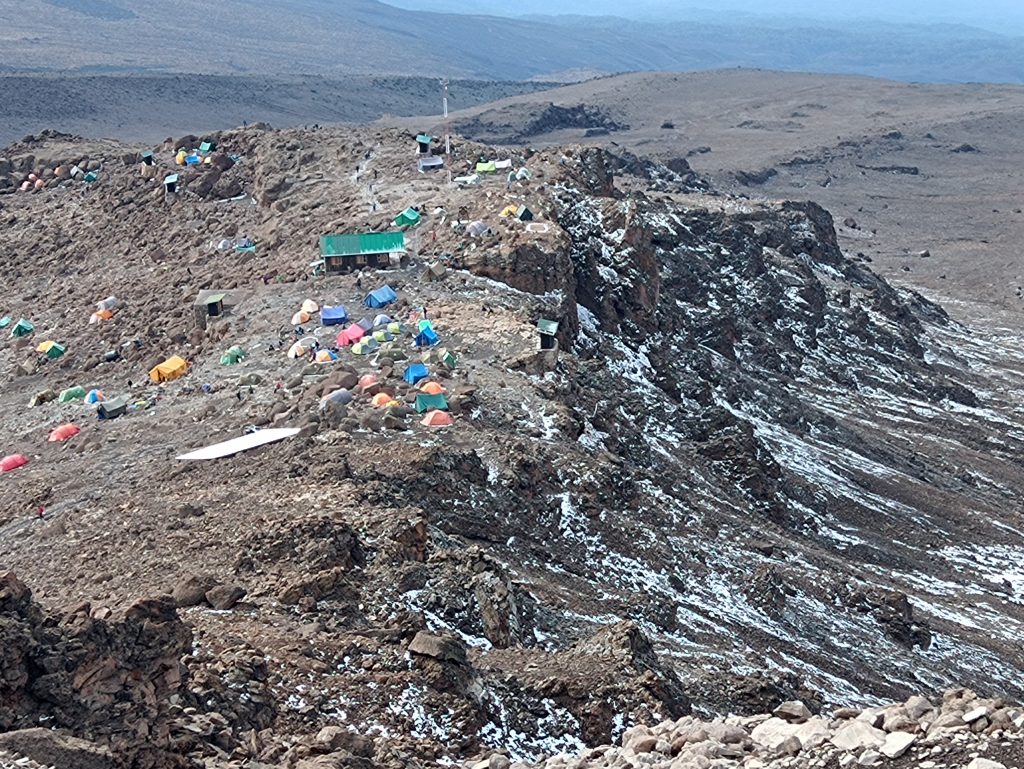
Back at Barafu Camp we had time to relax, snack, pack etc. Some of the group were hours later getting down, and I think I might have enjoyed the experience more if we hadn’t rushed, but c’est la vie.
We were not allowed to stay another night at Barafu, so we had to hike down another 4km to Millennium Camp. On the way we passed the “Kilimanjaro Ambulances” used to evacuate stretcher cases. You’d need to be in a bad way to want top travel on one of those!
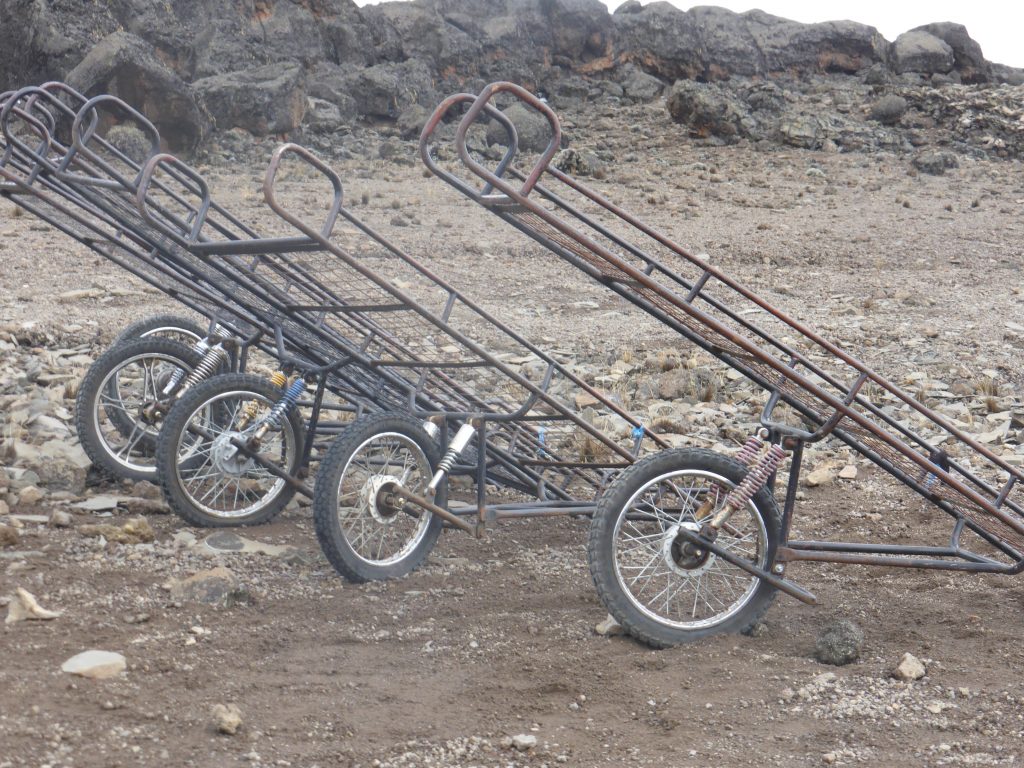
And so, to our last Camp, and a blissful night’s sleep.

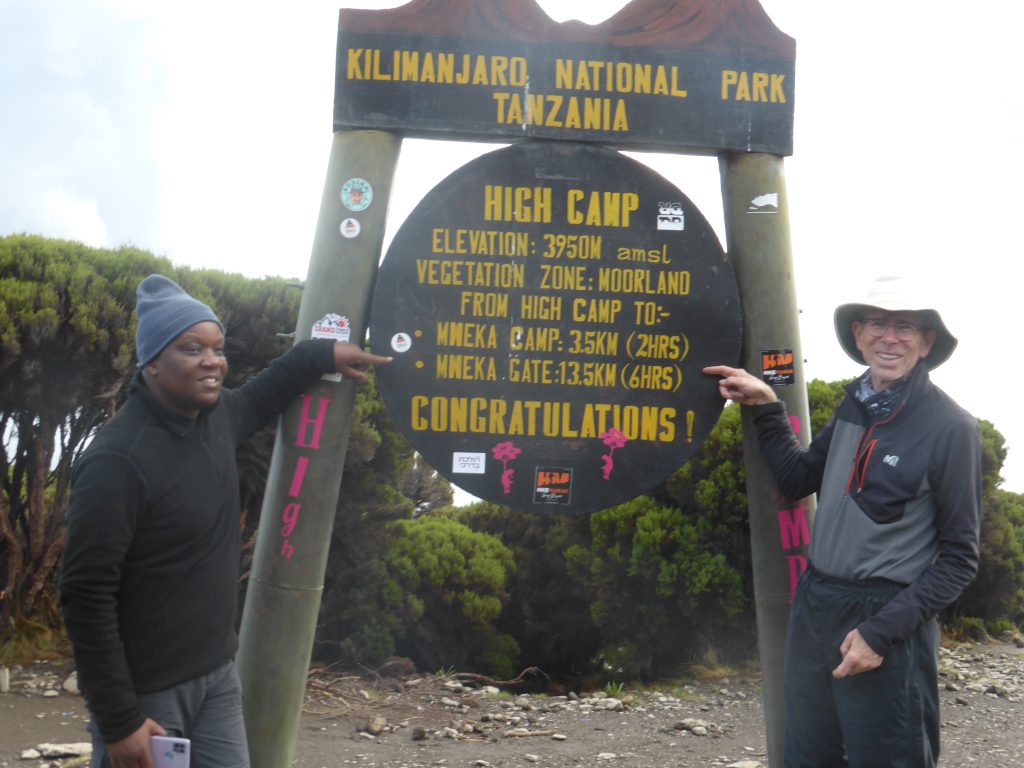
Kili Day 4: Barranco Camp to Barafu Camp via Karanga Camp
Again the morning was clearer than the precious afternoon and there were views up the mountain.
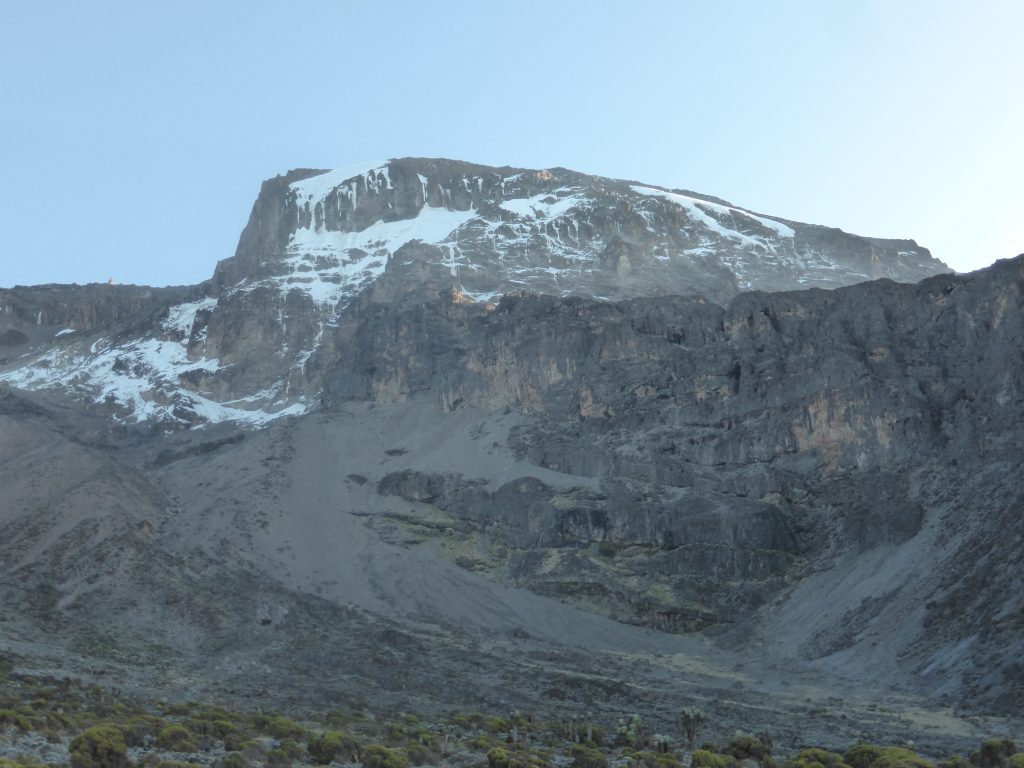
First we had to scale in the infamous Barranco Wall – a solid rock face that towers over the camp and looks really difficult to climb. In reality the route is well defined and there’s just more pushing up than walking forwards.
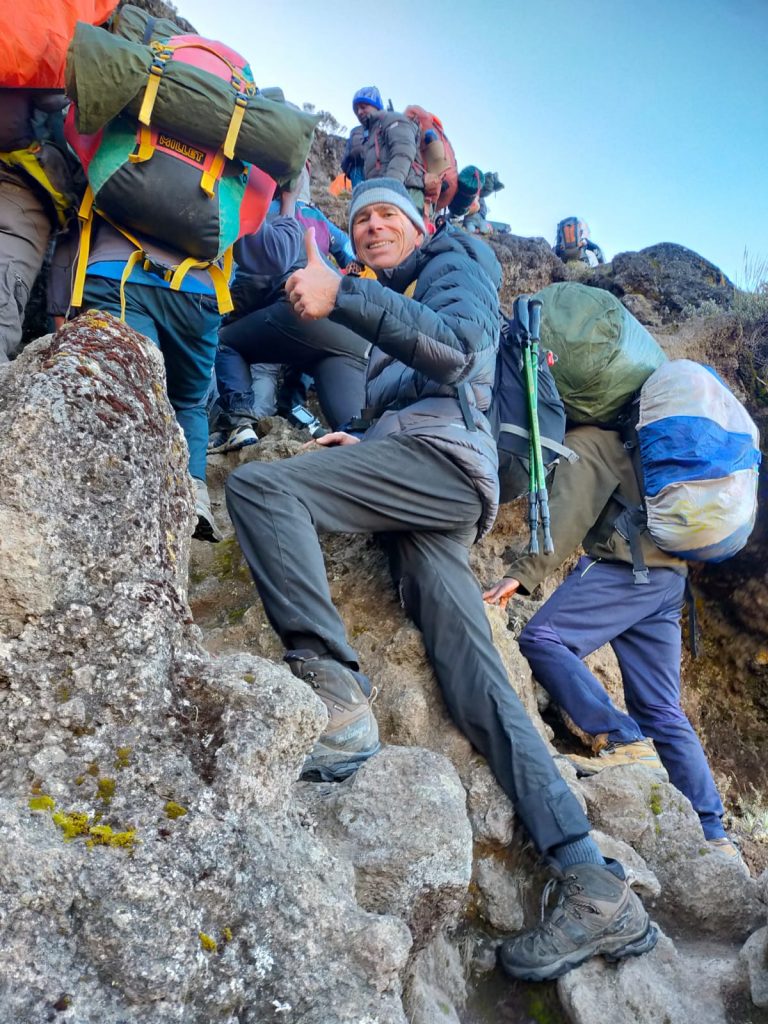
There were some narrow gaps to squeeze through
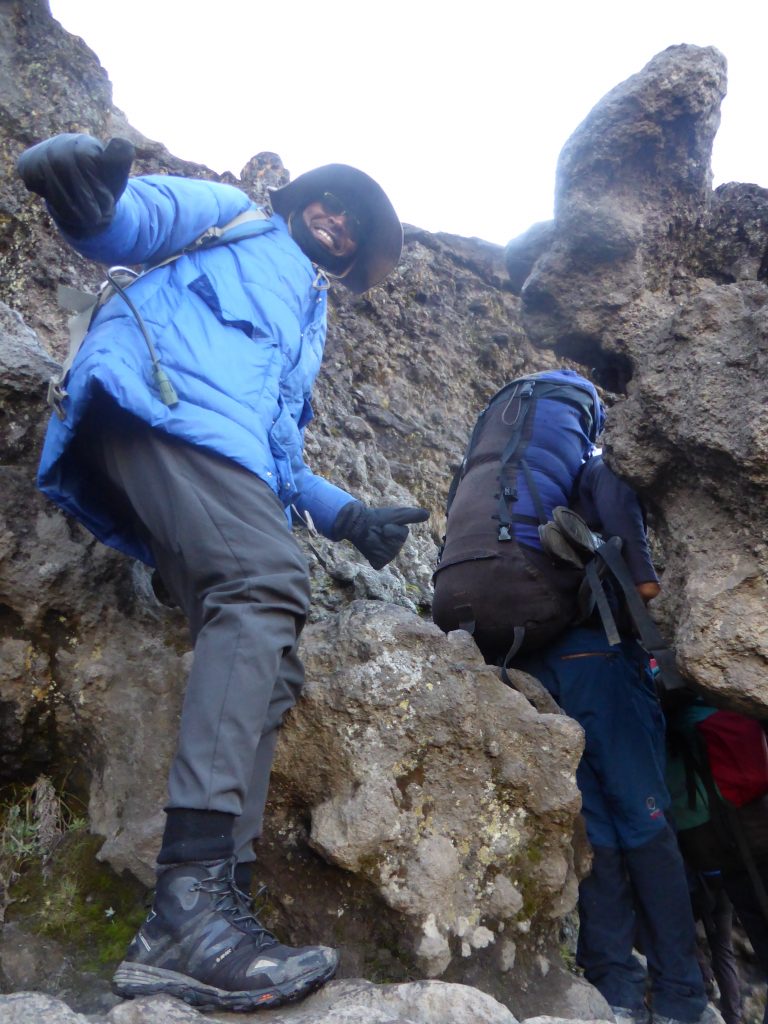
And the famous “kissing rock” where you slide round with your face to the rockface.
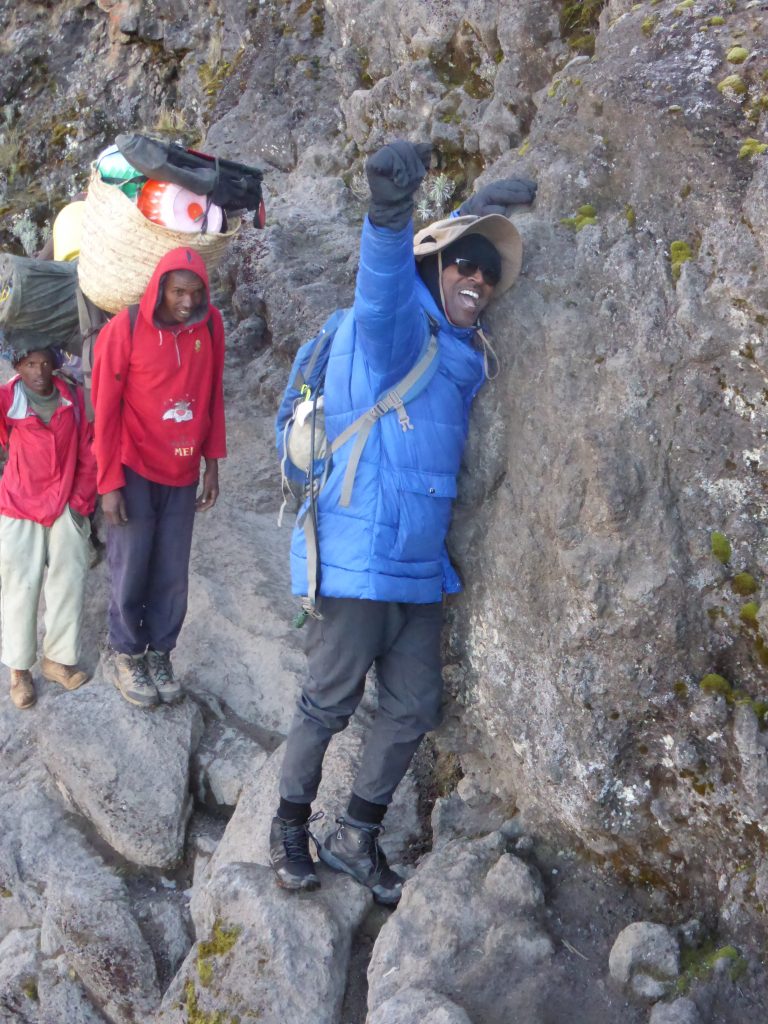
As we climbed, the views got better
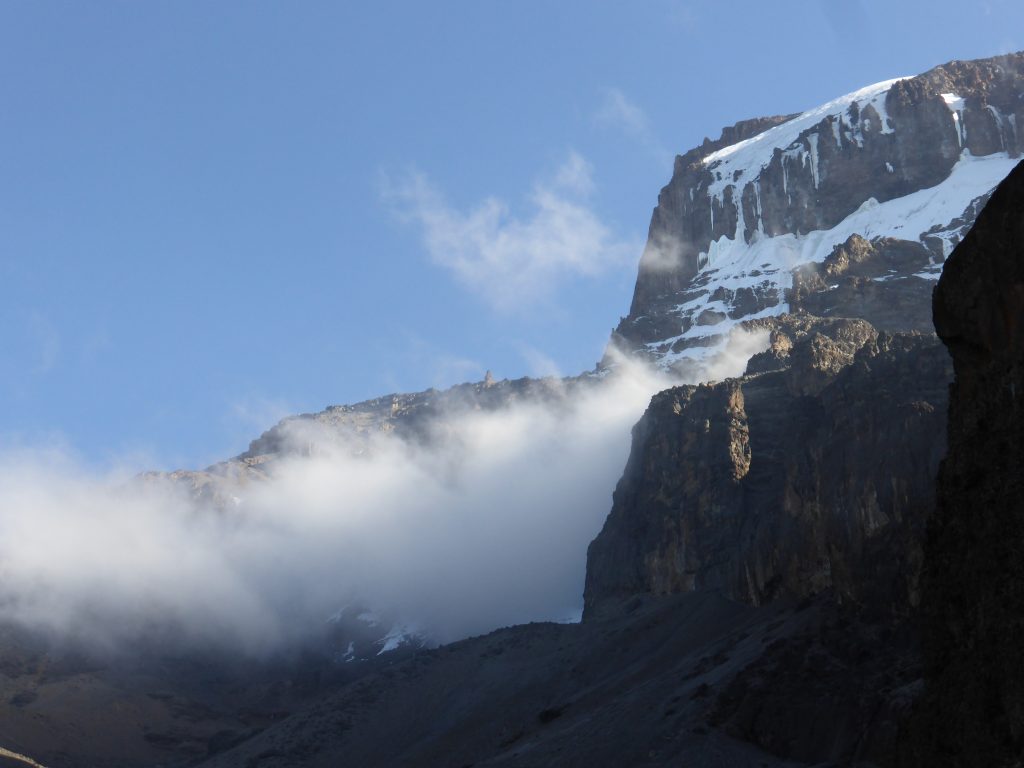
Having climbed the wall the route was up and down, with the off place to sit and rest
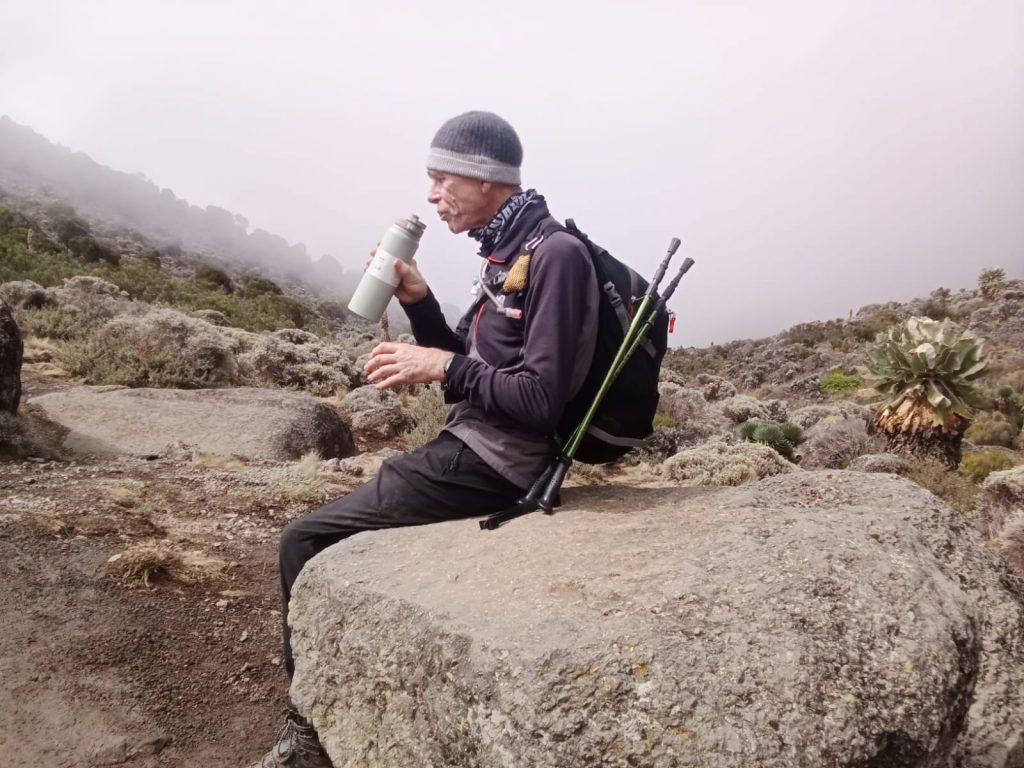
At Karanga Camp the weather was closing in again.
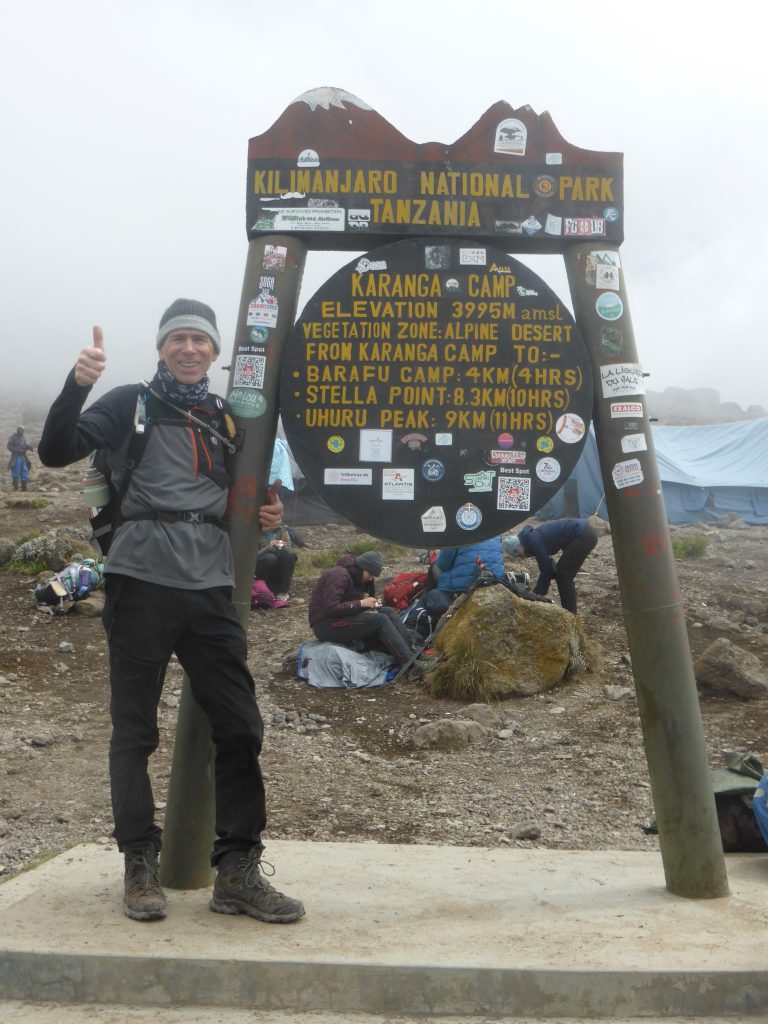
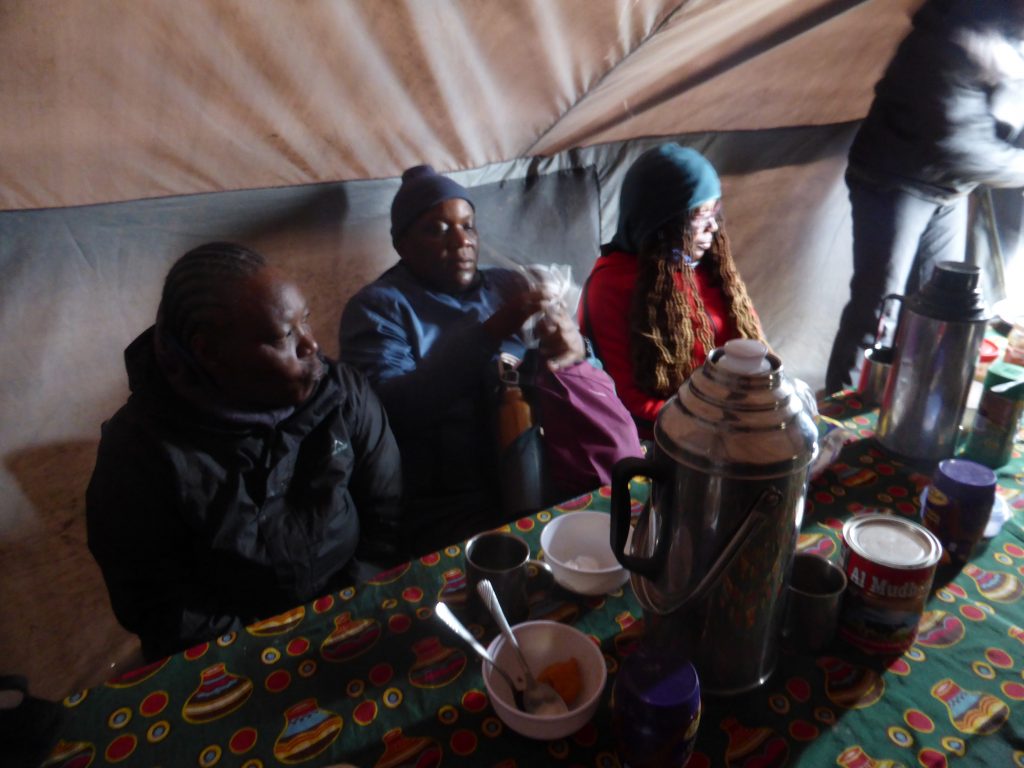
After lunch we set off again into a minor blizzard. We’d actually dropped lower than the start point, and had over 800m to climb to Barafu Camp.
We were relieved to reach Barafu Camp
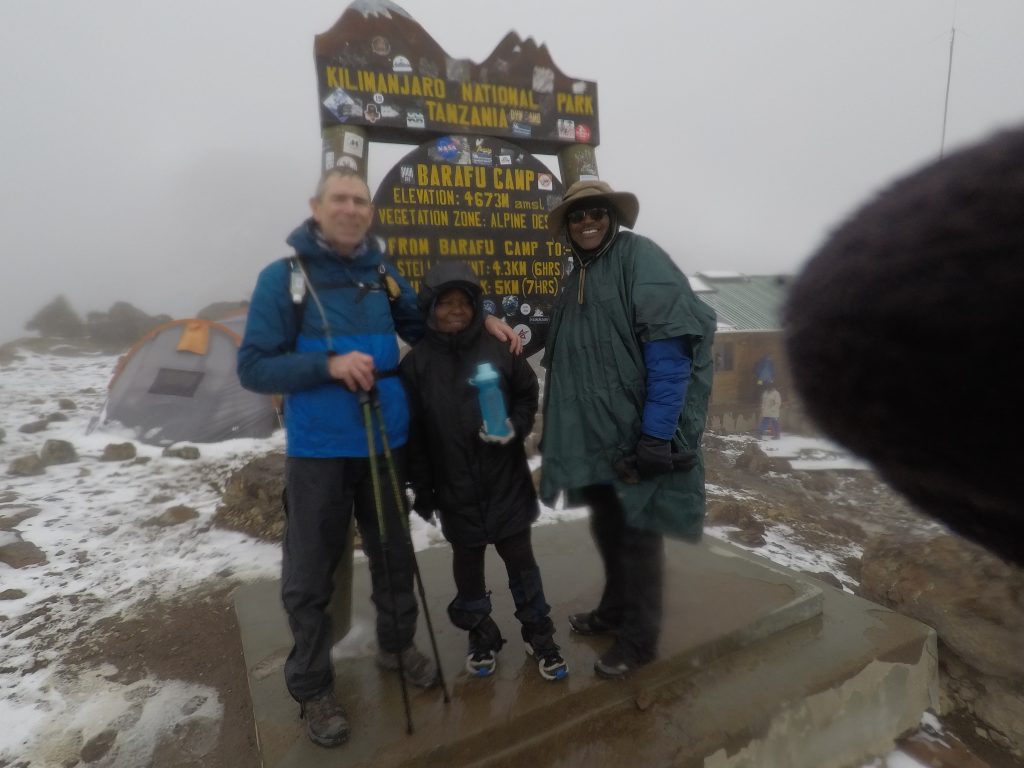
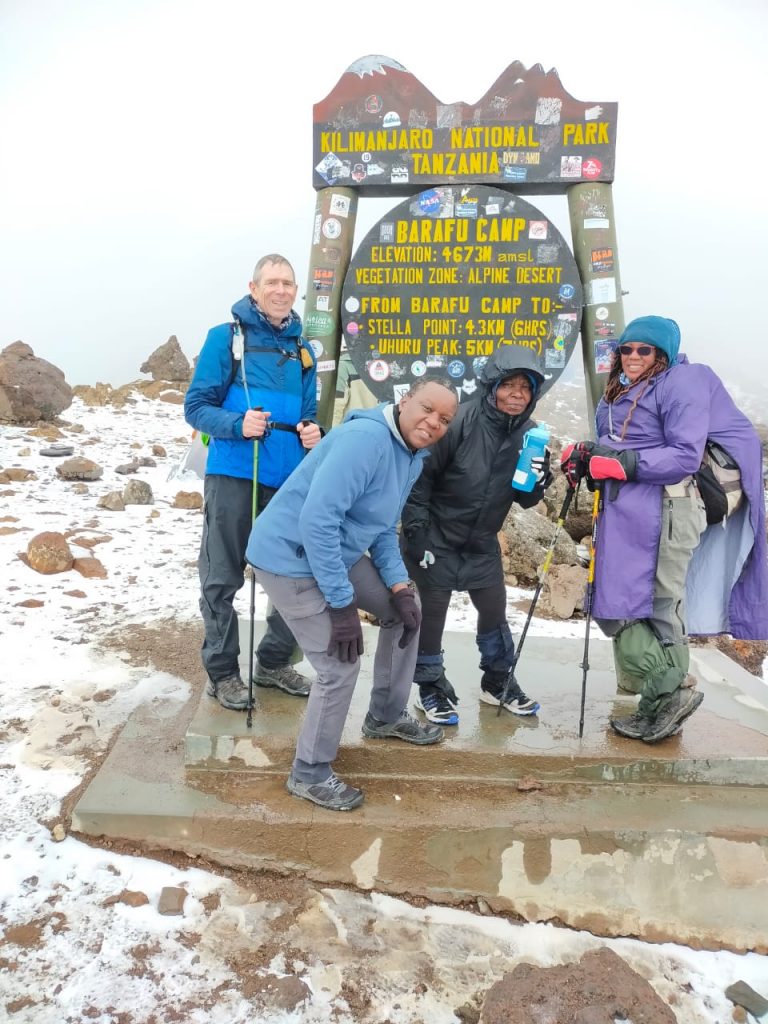
However, as we sat by the hut waiting for our camp to be ready, the sun emerged
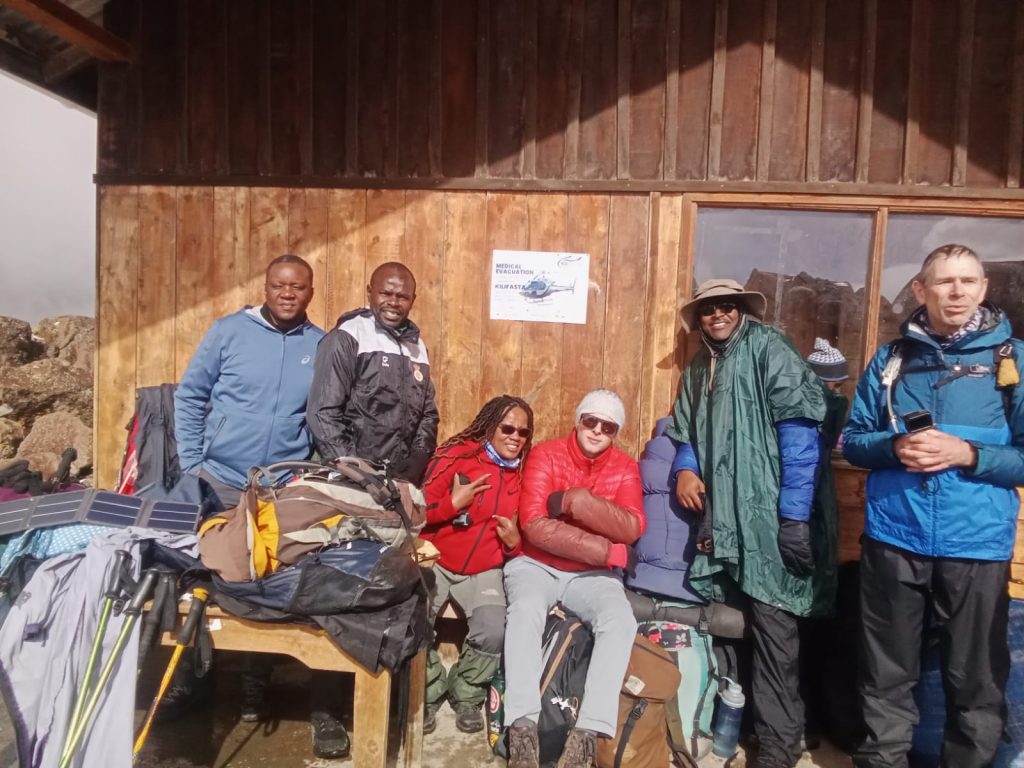
Here we are joined by hikers from Brisbane and BC – the whole world comes to Kilimanjaro.
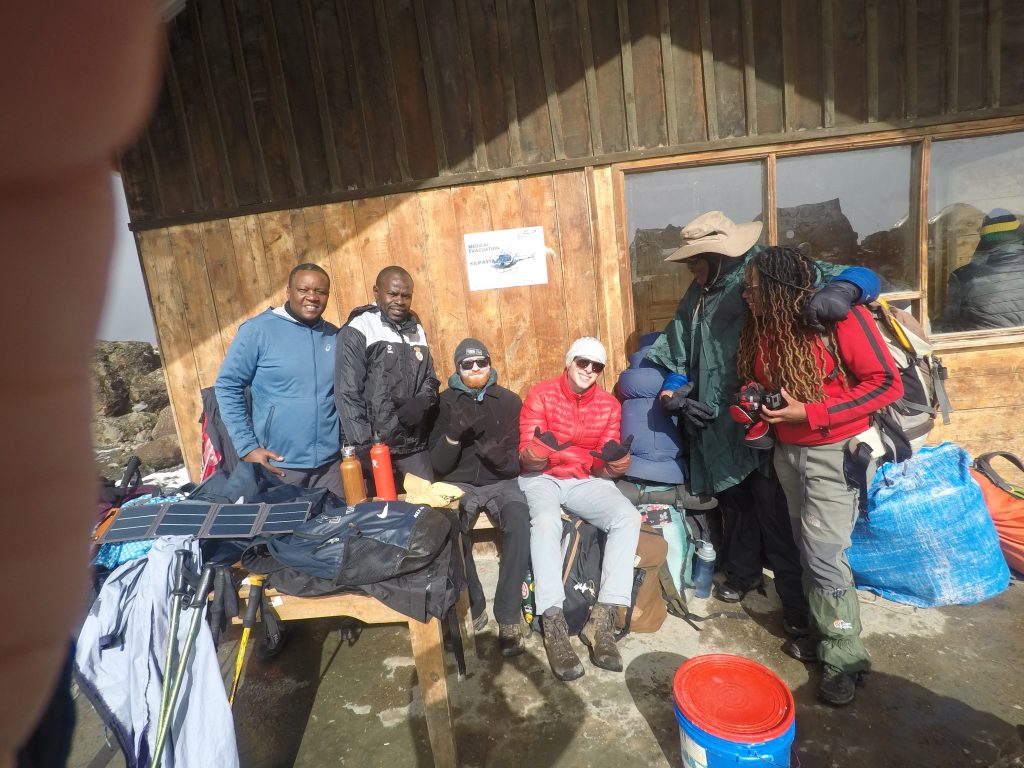
Even the summit came out to see us briefly
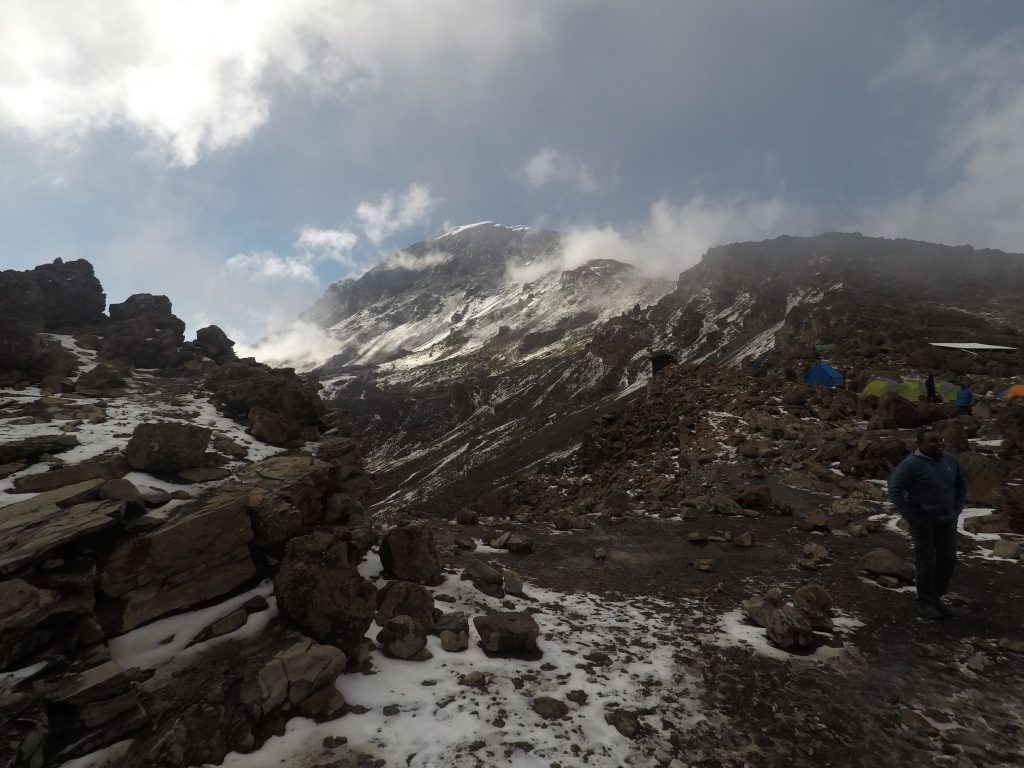

And so to camp, to be fed and to rest ahead of our ludicrously early start in the middle of the night. And they fed us PIZZA – good pizza. How do they manage that on the mountainside?
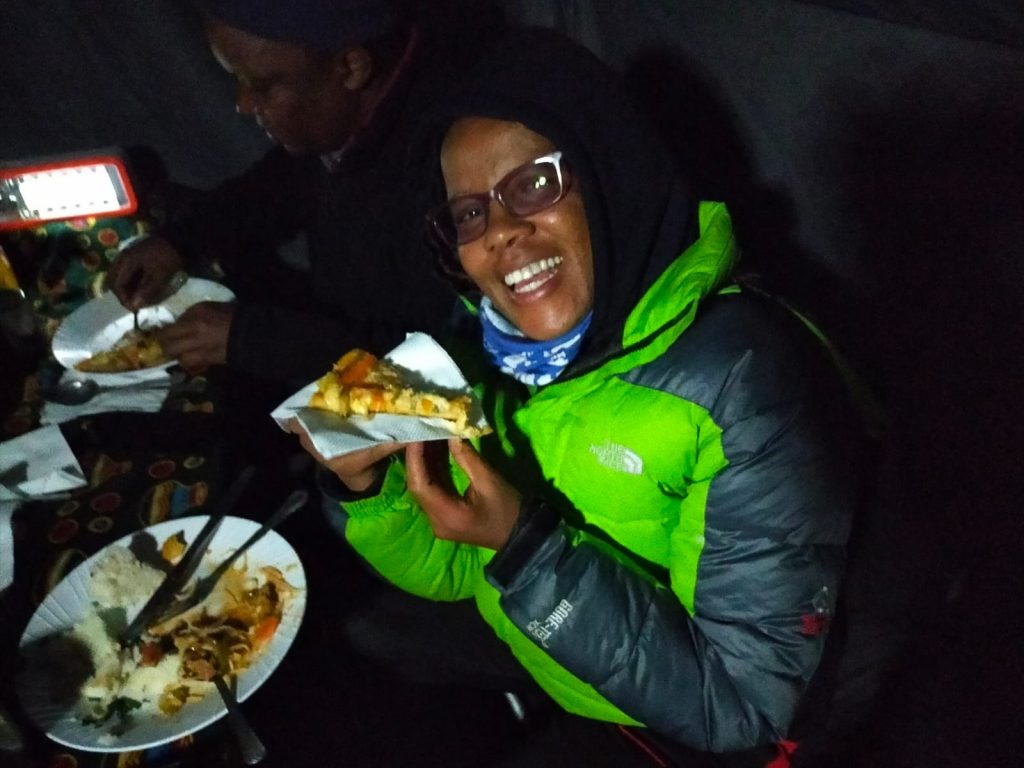
Kili Day 3: Shira Camp to Barranco Camp via Lava Tower
https://www.outdooractive.com/en/route/hiking-route/hike-shira-camp-to-barranco-camp/260266897
After yesterday afternoon in the clouds, today dawns clear and we have sight on the mountain above our camp.
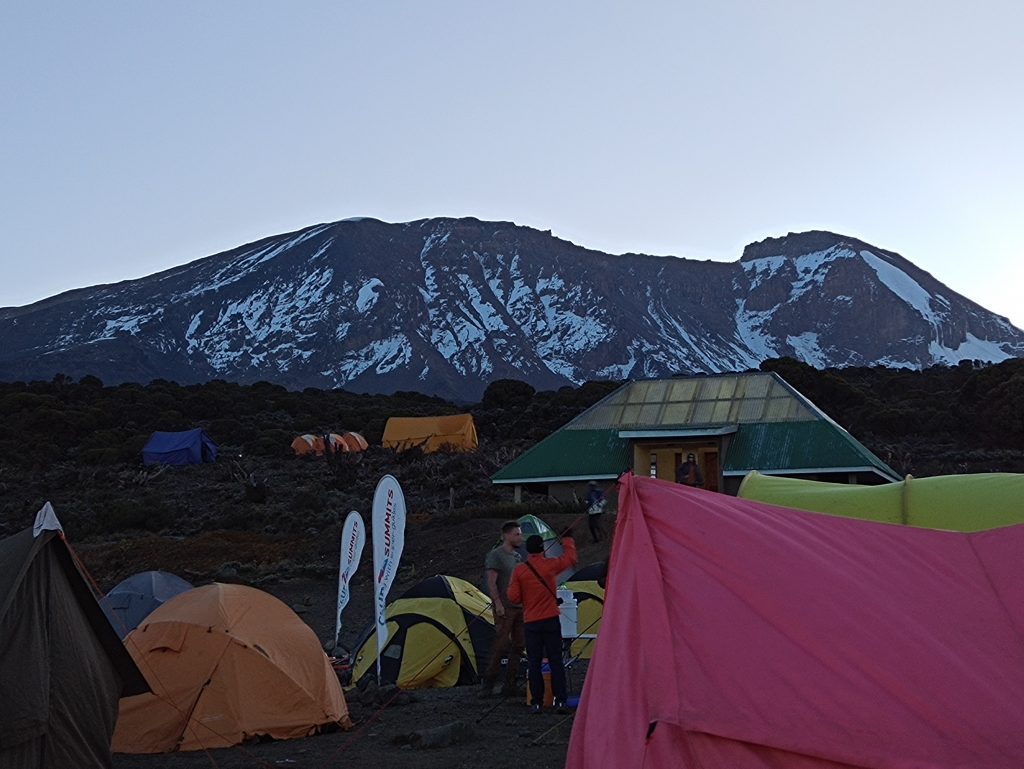
There are a lot of people here, and a lot of kit to be gathered up and carried by the porters.

Our team are ready for the day. It’s cool, but bright.
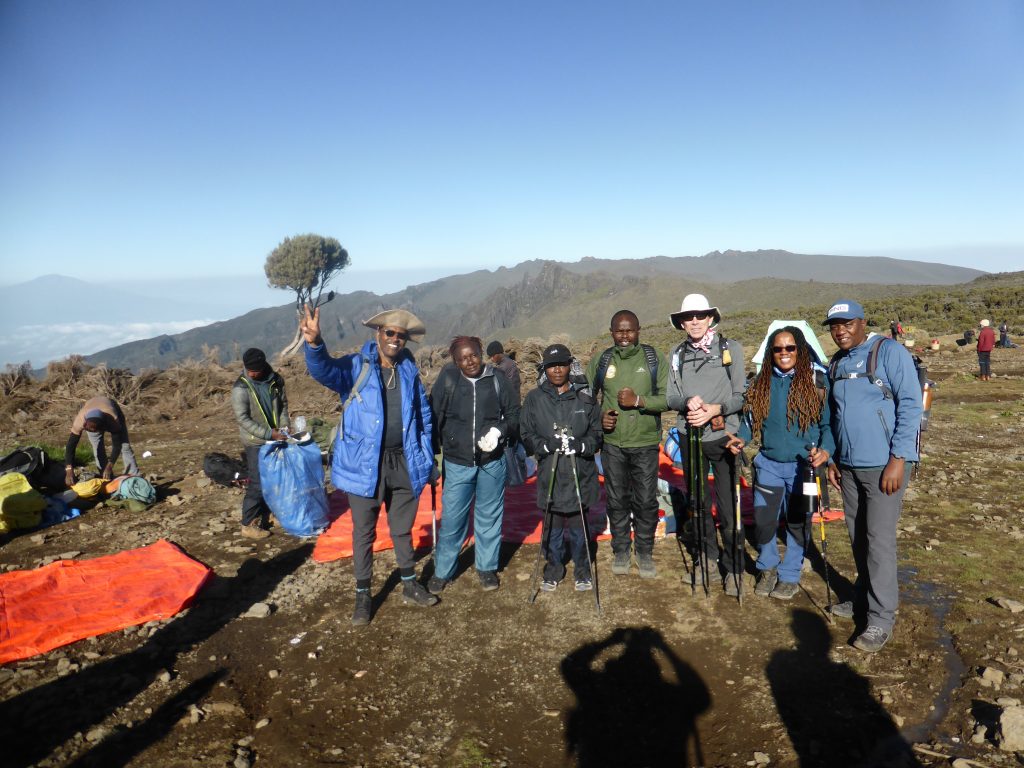
The morning was a long slog uphill – about 800m of ascent over 6.5km. The vegetation was getting sparser, but we had a view of the mountain to encourage us.
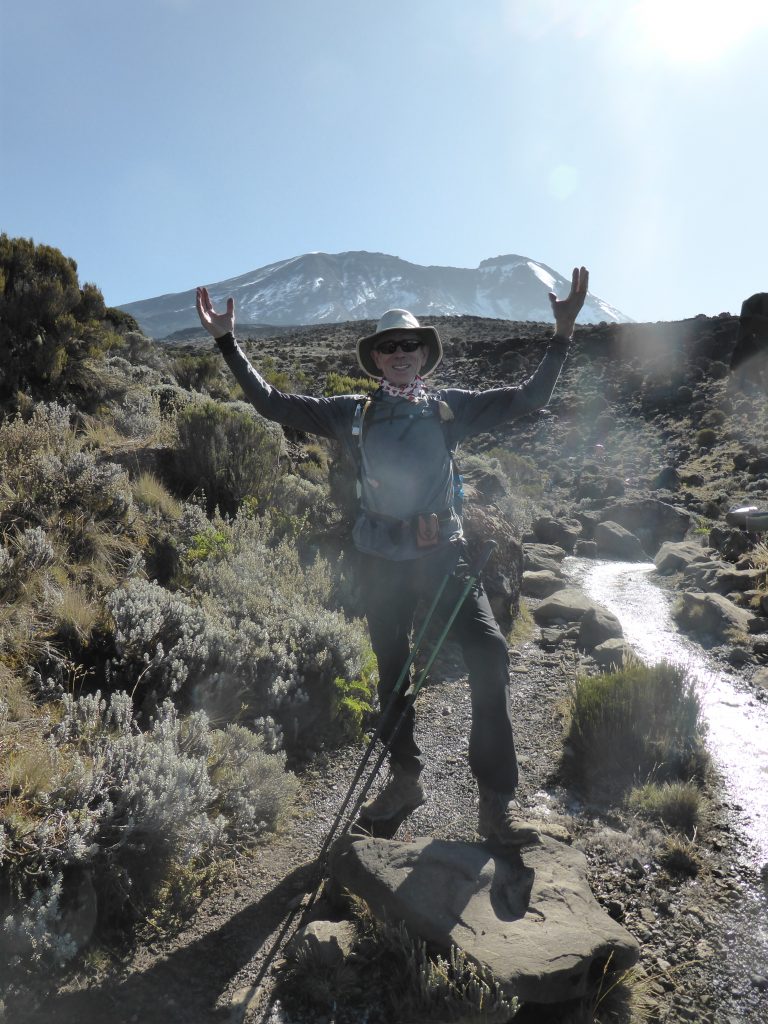
Not quite as processional as yesterday where overtaking was largely impossible, but a long ribbon of people snaking up the mountain. We were in awe of the porters carrying everything including the kitchen sink, while we just had daypacks.

Faith and Mary take a quick break.

As we got higher the clouds rolled in – not above us but around us – and the terrain became rougher.
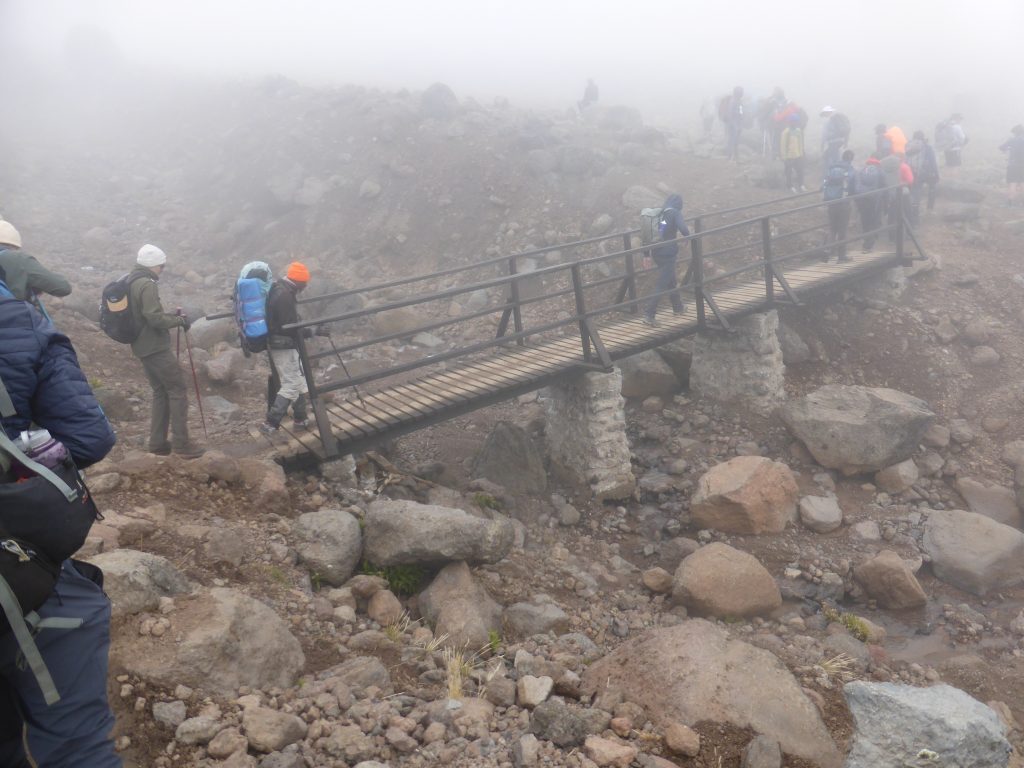
We eventually reached Lava Tower, where they had erected the mess and kitchen tents (and our loo) so we could dine in “comfort”. It was decidedly chilly in the damp breeze so shelter was essential.
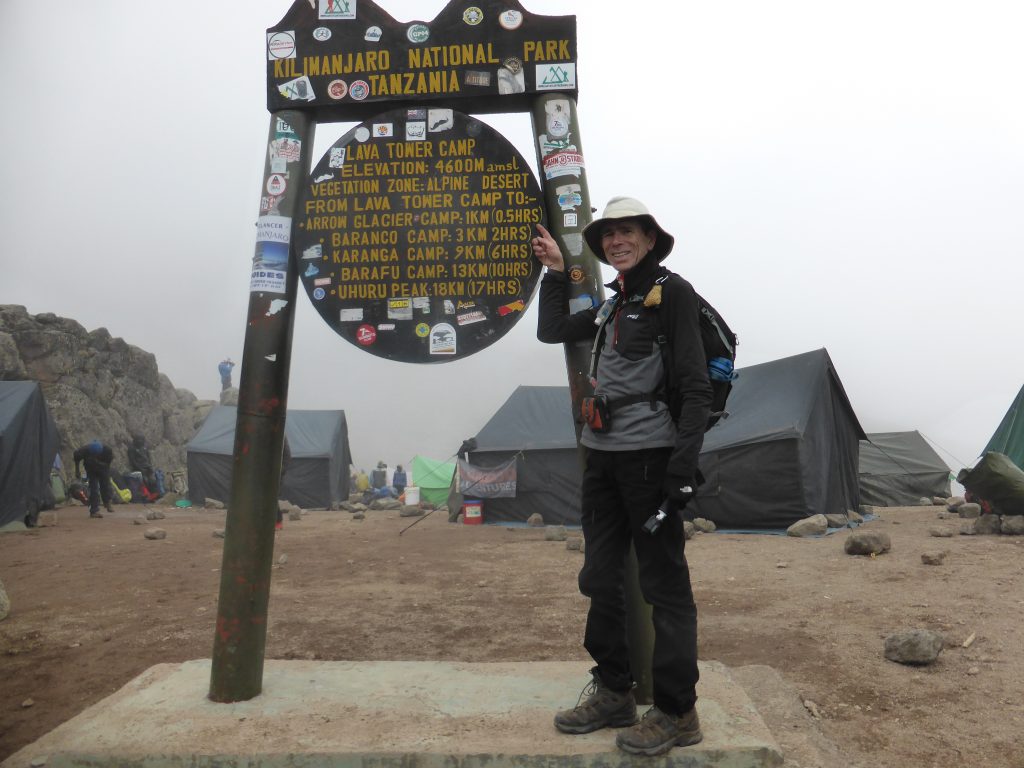
The Lava Tower could just about be made out in the mist. Finding the way down was also tricky!
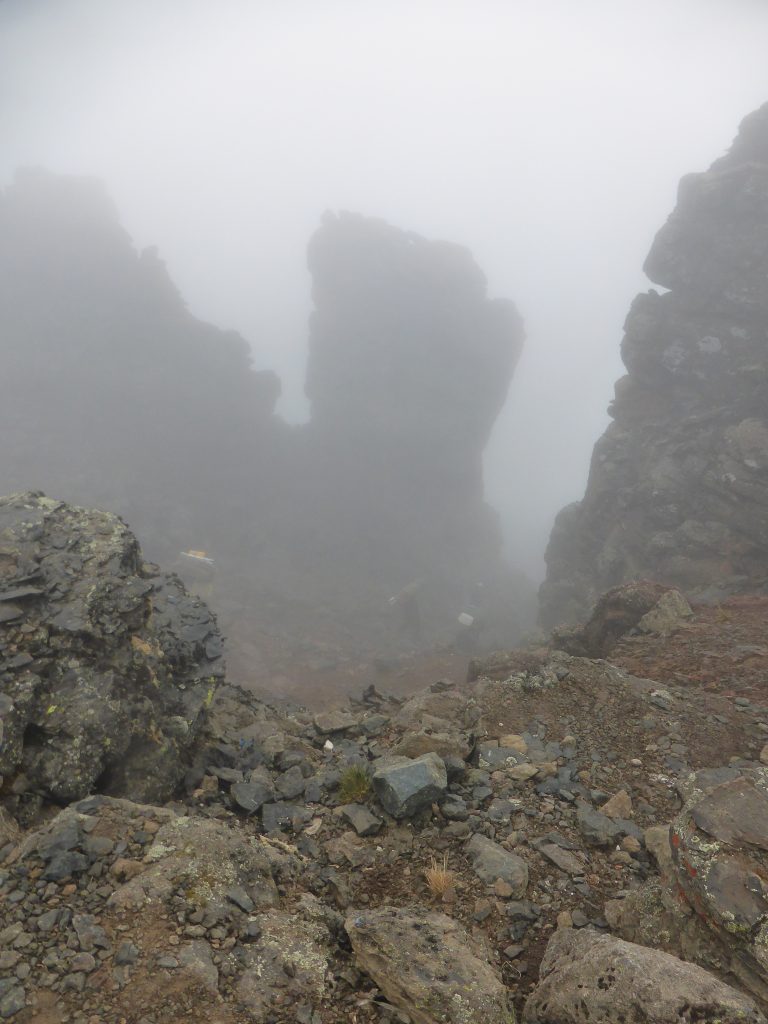
The afternoon was a descent of some 600m on wet shale (“hike high sleep low” being the mantra for avoiding altitude sickness). On this side there was some pretty weird vegetation, made even weirder by the mist. Well, maybe mizzle rather than mist because we got quite wet despite not sensing precipitation – should have worn my waterproof not a down jacket! Also note that the photos are from GoPro as the regular camera was stowed away to keep dry.
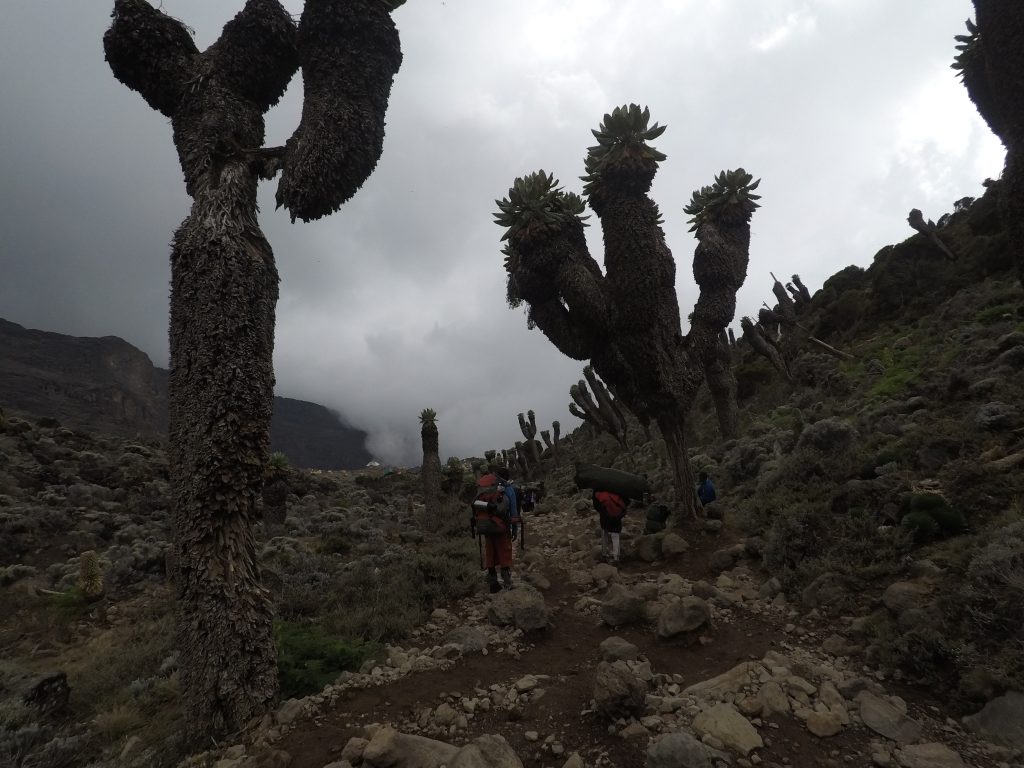

It was still pretty damp when we reached our next camp, tents perched between the rocks, the walk to the toilet tent a short but challenging adventure!

In the safety of the tent I took off my socks and inspected my legs and feet. Sunburn from Ngong Hills still shining, and swollen where the socks didn’t compress them. Still, felt OK.
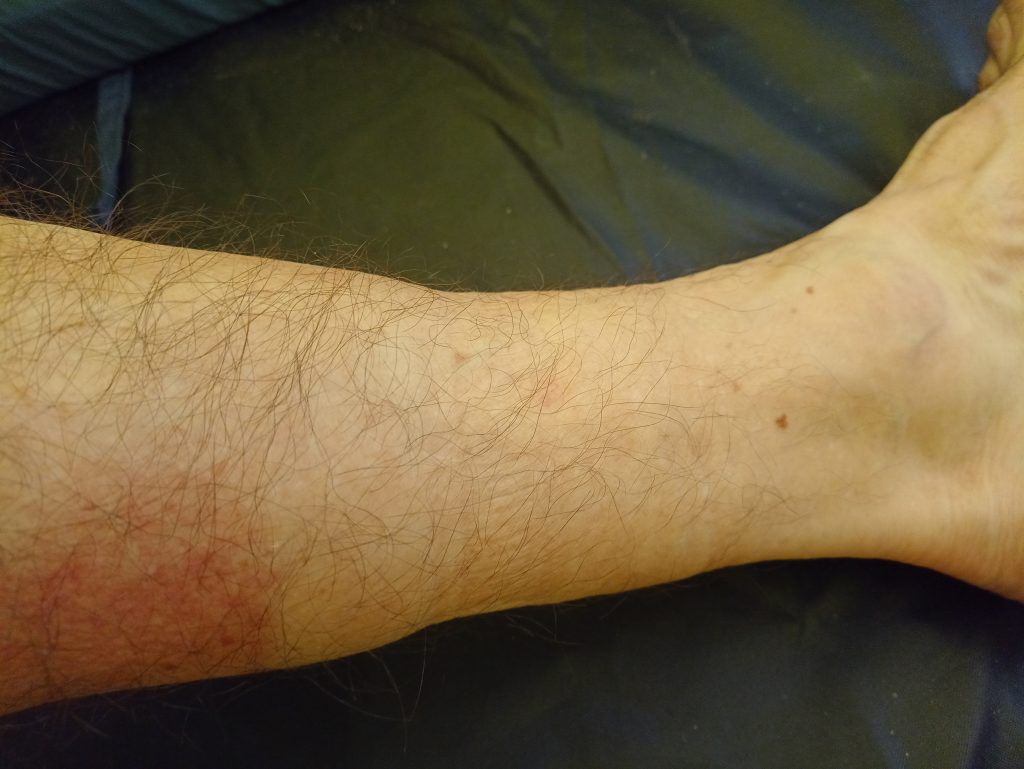
Kili Day 2: Machame Camp to Shira Camp
Hike: Machame Camp to Shira Camp • Hiking Route » outdooractive.com
Today’s was just a morning hike climbing some 900m from 3,000m to 3,900m over 5.1km. That’s rather steeper than yesterday’s longer steady climb.
Having arrived not long before sundown yesterday, we got a better view of our camp this morning. The hikers are housed in the little green tents.
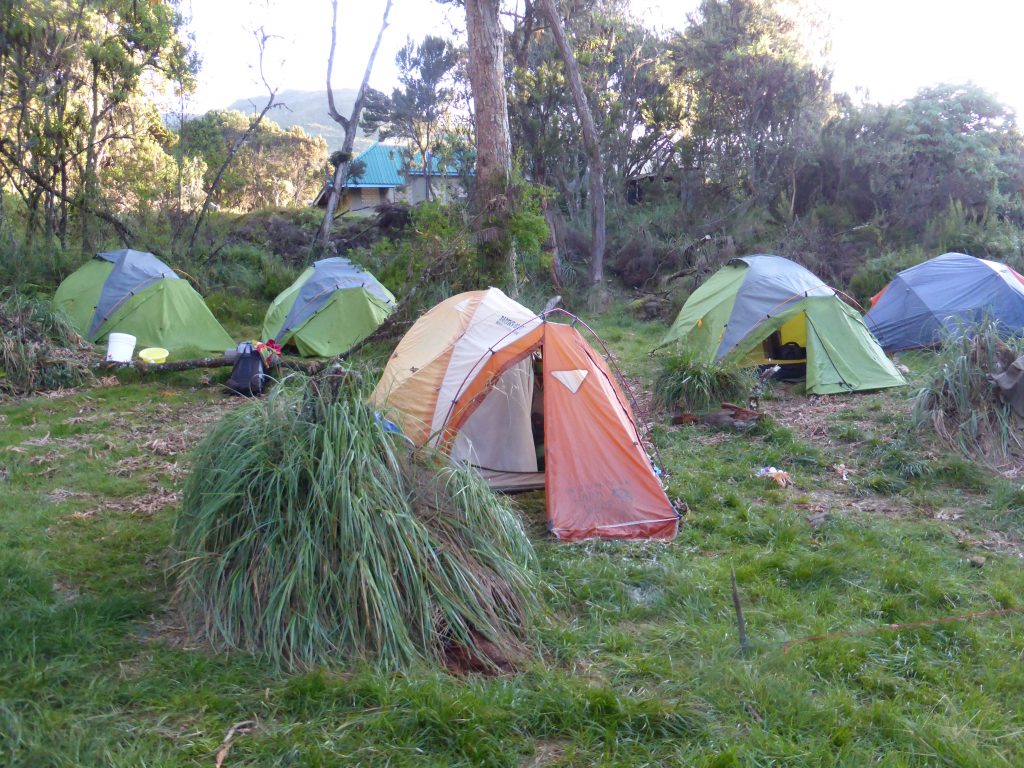
Breakfast was served in the mess tent – dark blue and always gloomy inside.
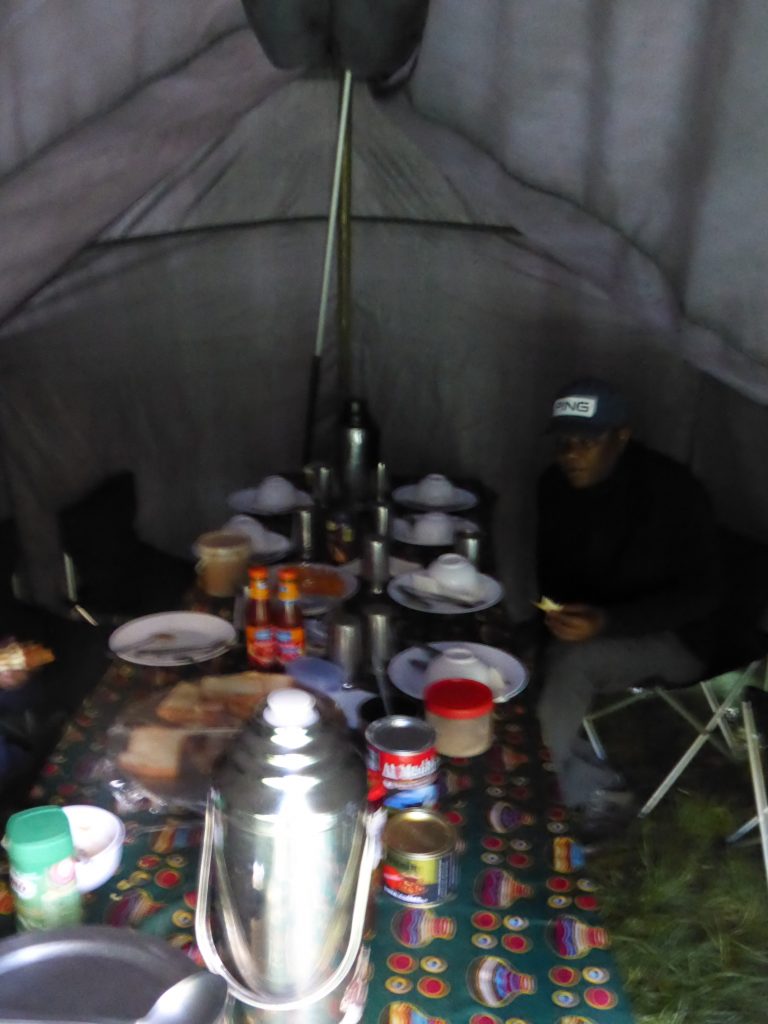
Mary, next oldest after me, is ready for the day.

The climb starts immediately and is relentless. But we’re only carrying ourselves and our day packs – the porters carry much more.

We are encouraged by the view ahead and around us.

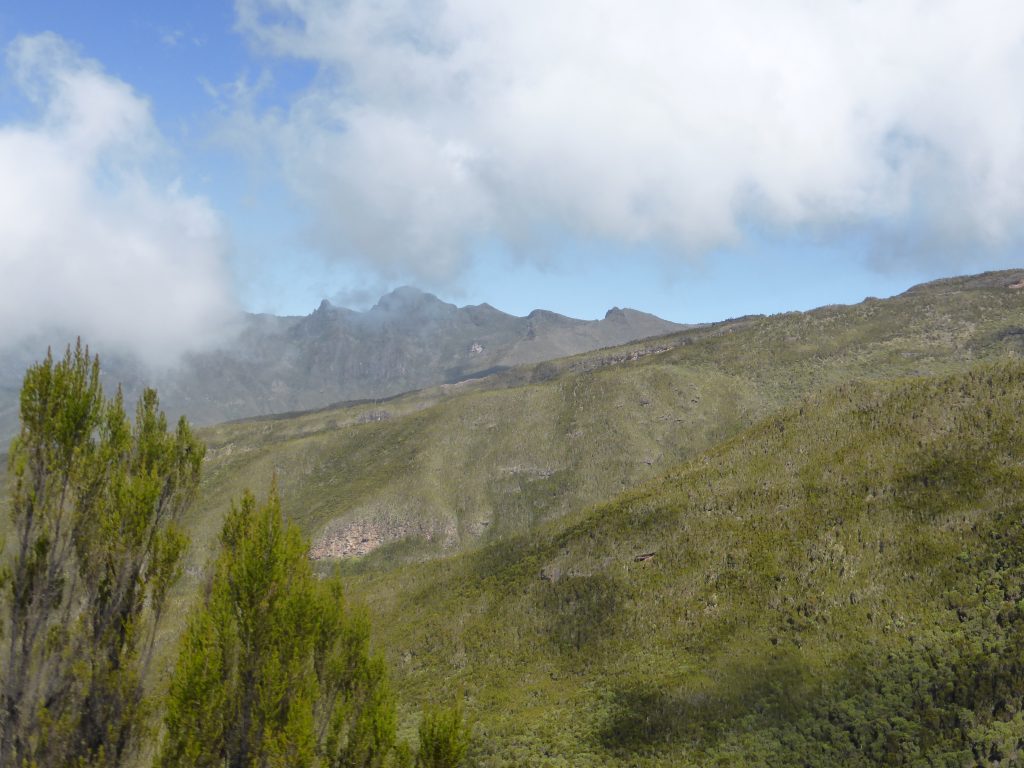
Here it is quite a procession with little chance to pass unless someone stops. The porters are always keen to get ahead – they want to have the camp ready for our arrival.

This cold shower wasn’t quite tempting

We’re out of the rain forest now, with weird vegetation and evidence of how damp it generally is up here.
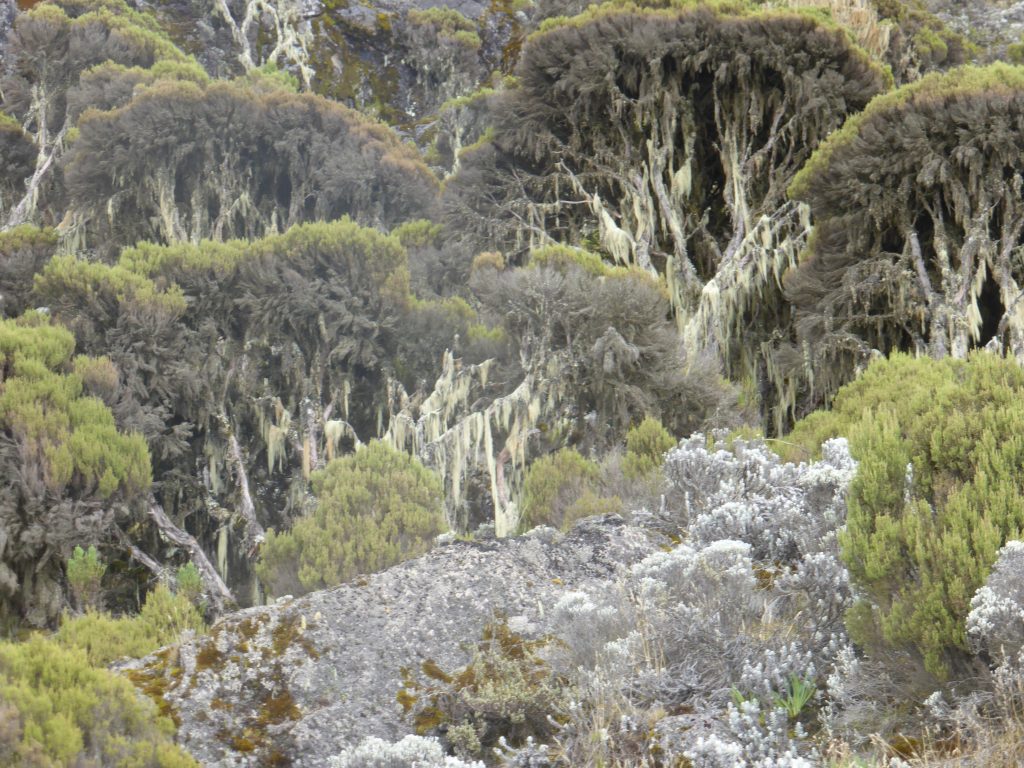
As we turned across the face of the mountain it was less steep but tricky underfoot.
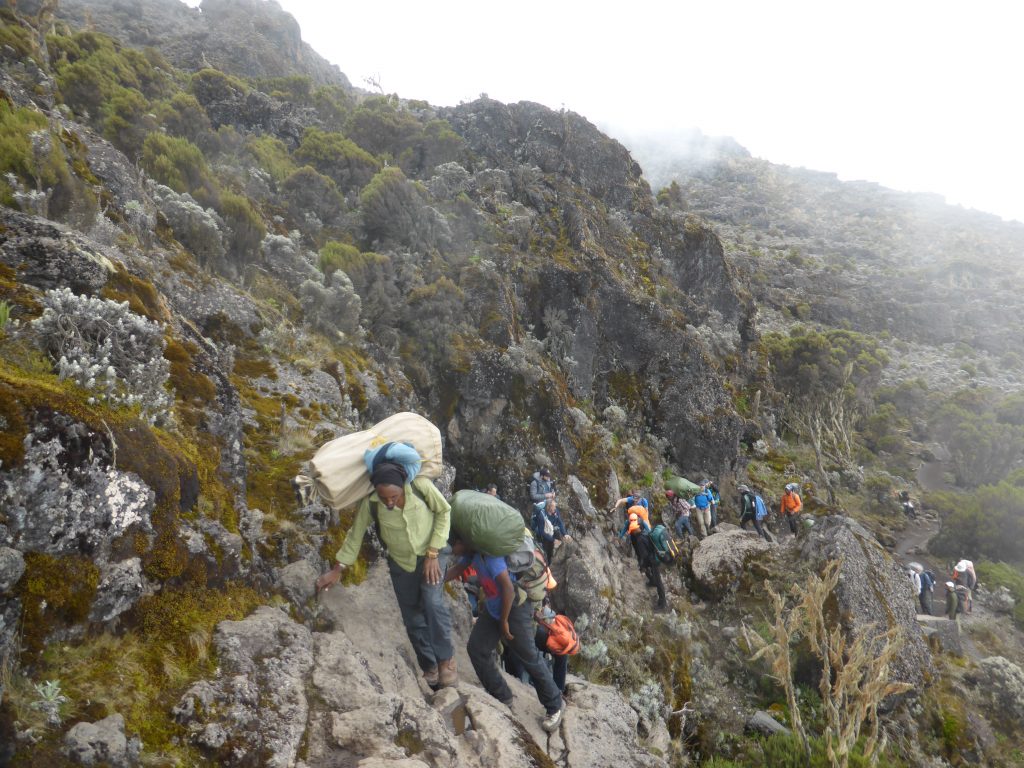
Some splendid mountain thistles
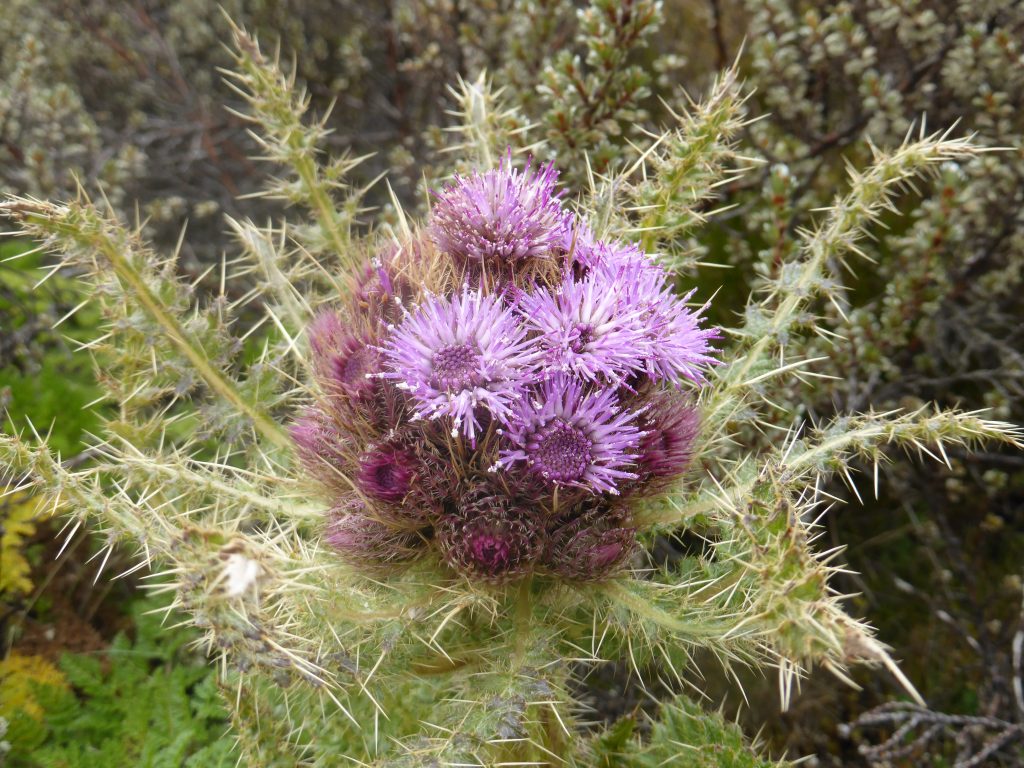
We reached Shira Camp in time for lunch – and in time for the cloud to settle on us.
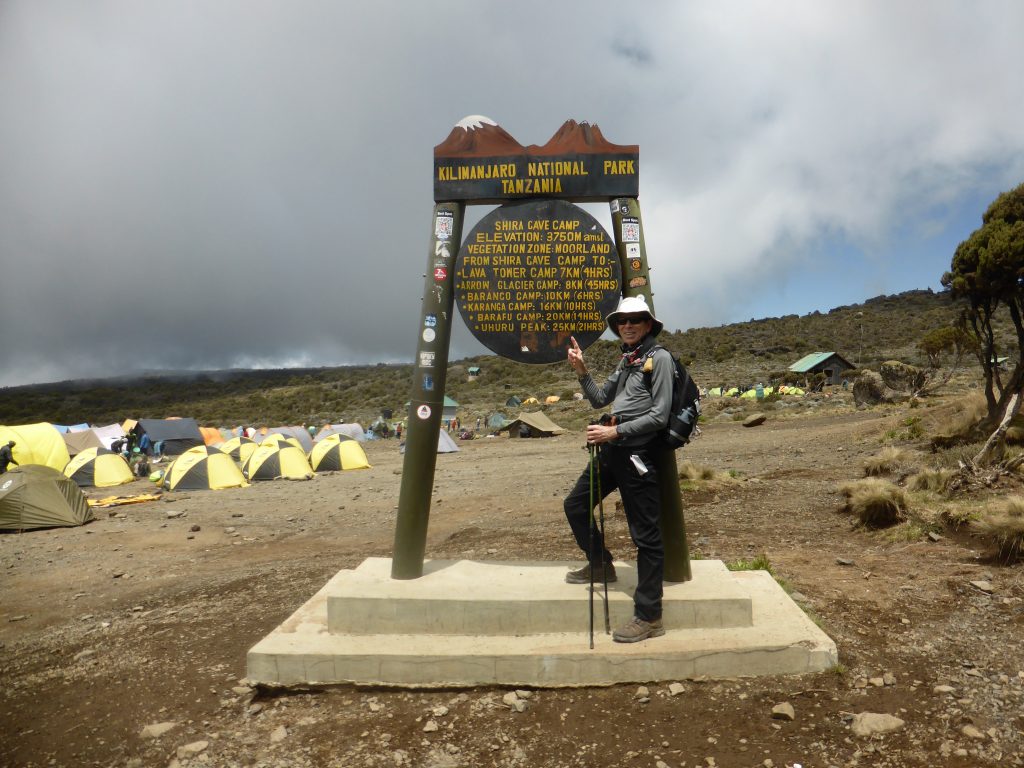
Washing up after lunch
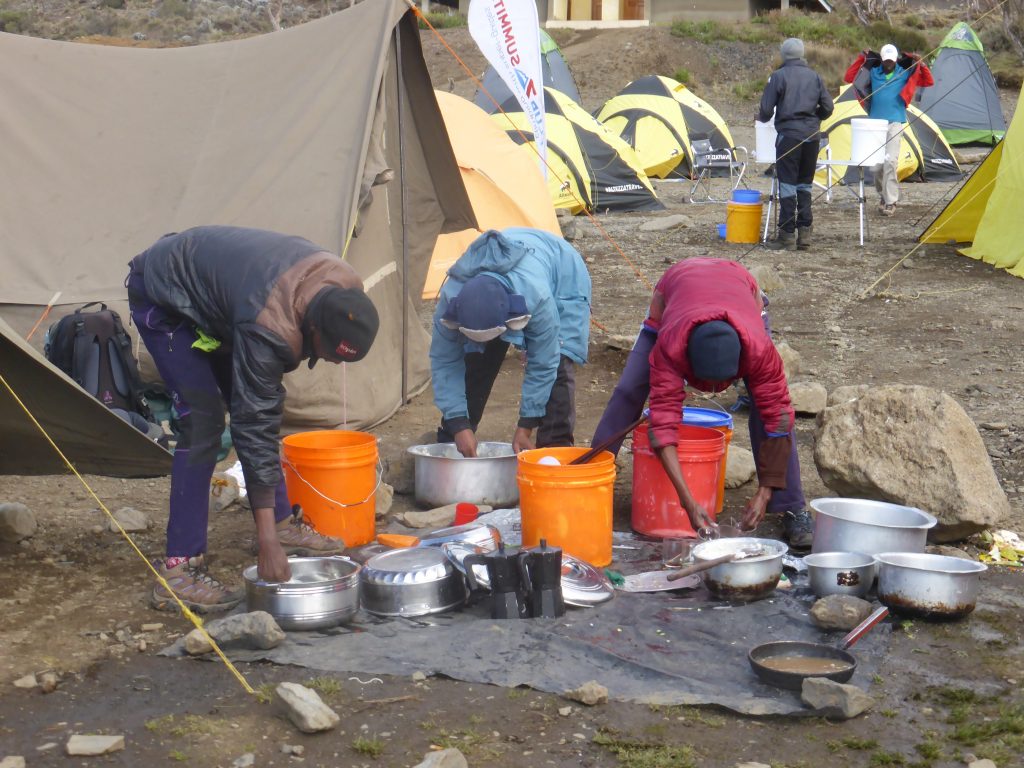
The Shira Cave
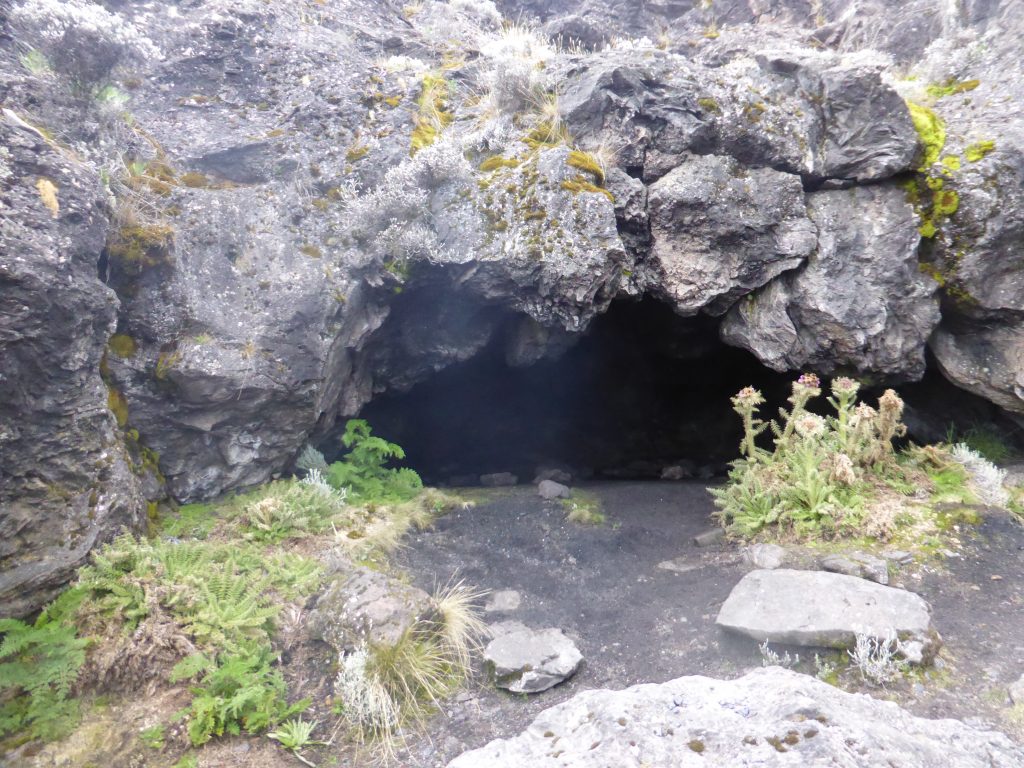
Nashon and I took a further excursion to a small hill which should have a view….
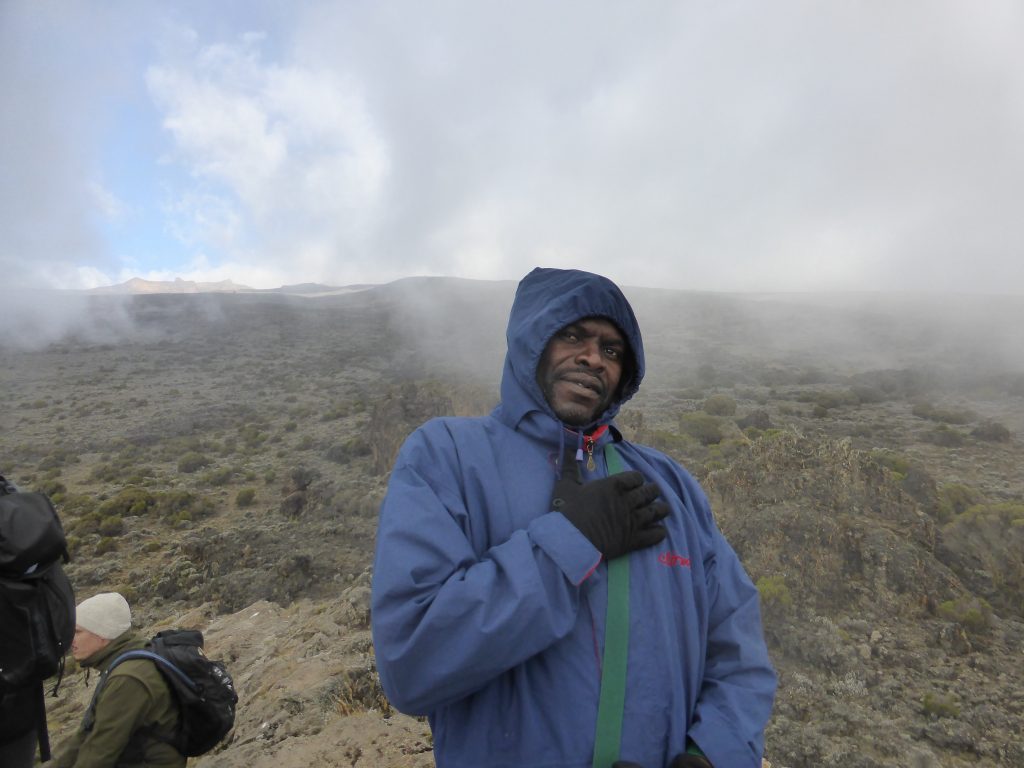
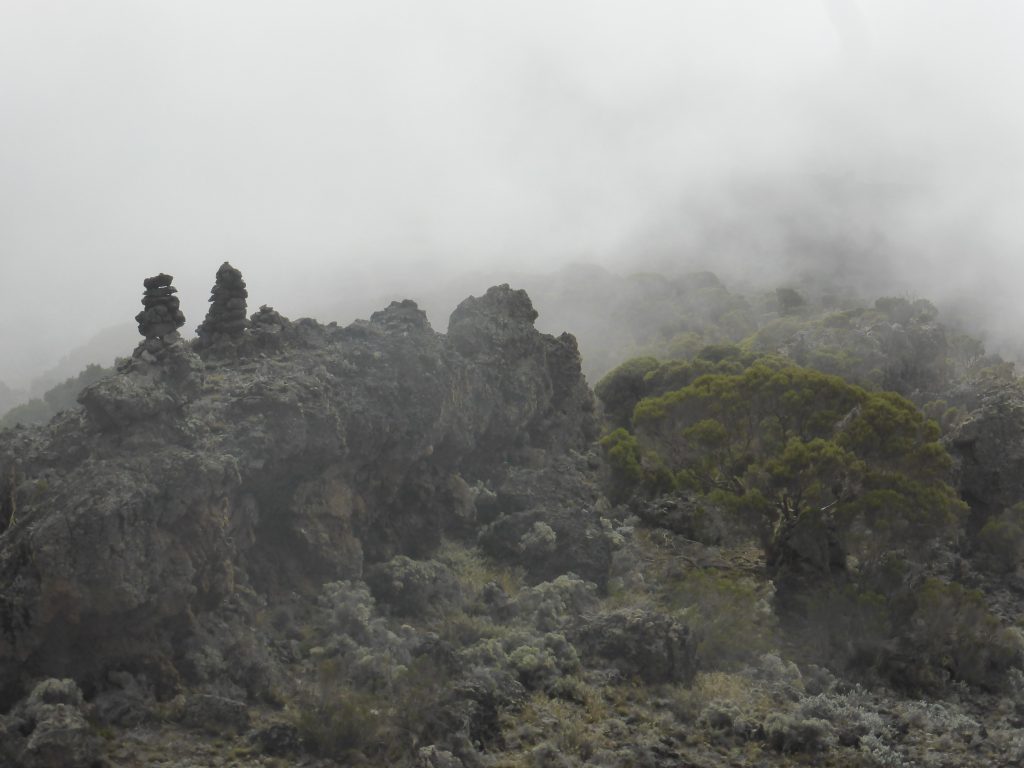
Our tents

Preparing supper
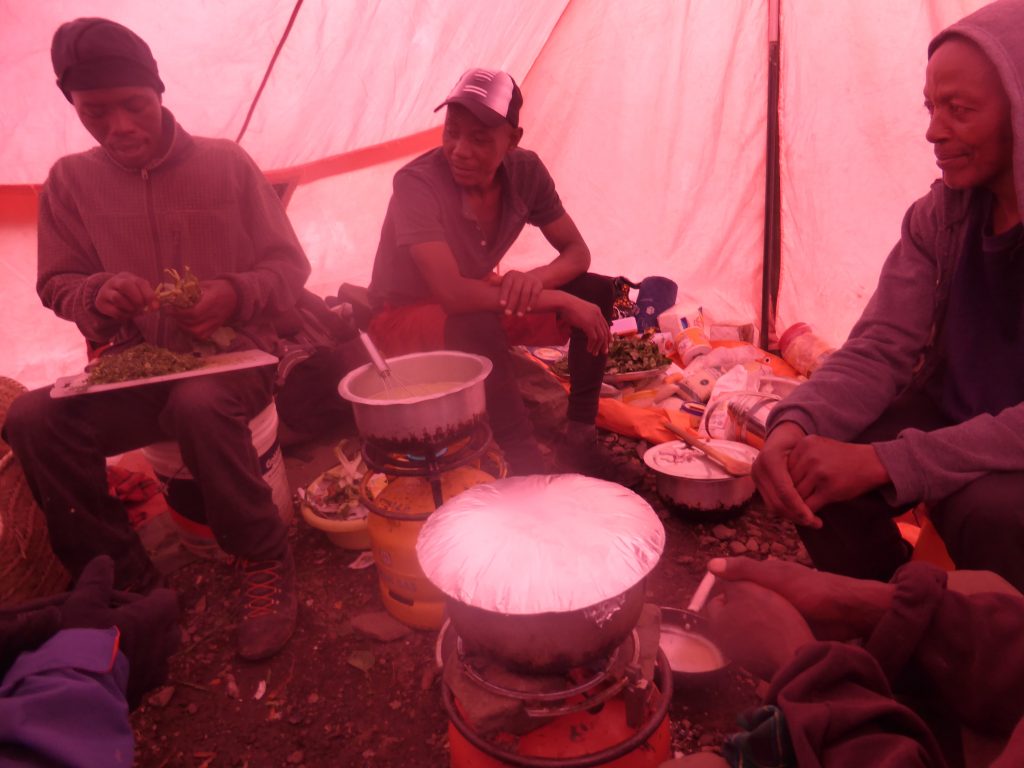
As darkness fell the clouds cleared – what a sight.
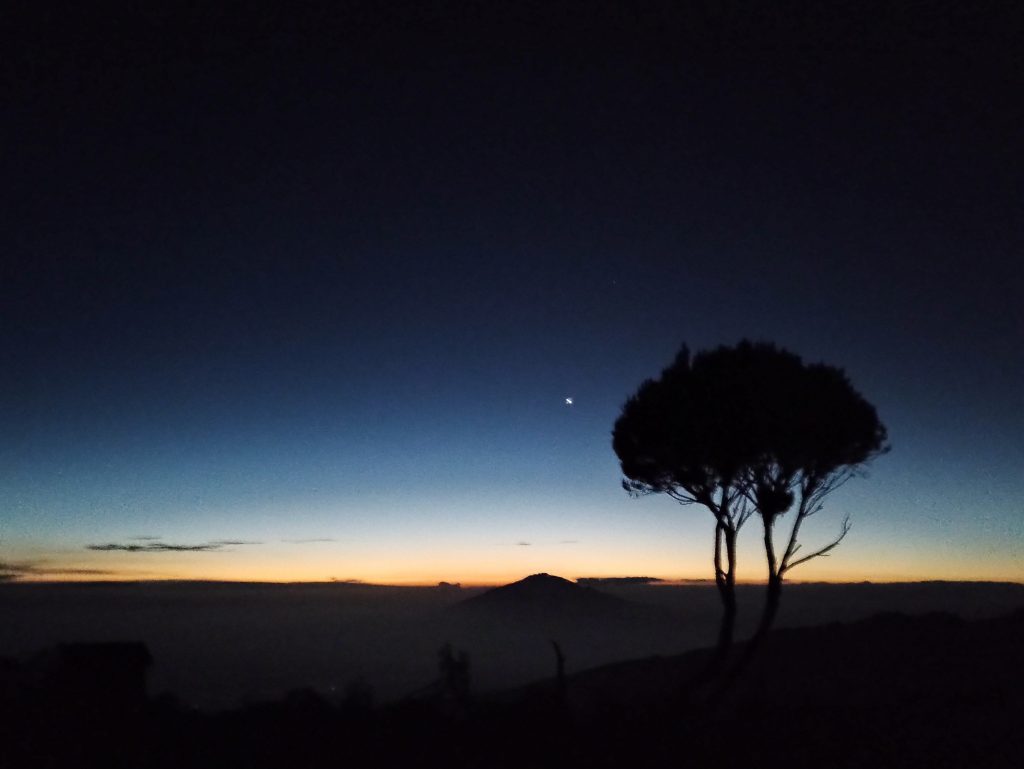
Kili Day 1 – Machame Gate to Machame Hut
Hike: Machame Gate to Machame Hut • Hiking Route » outdooractive.com
Our first day started early but with lots of hanging around at the Zebra Hotel in Moshi.
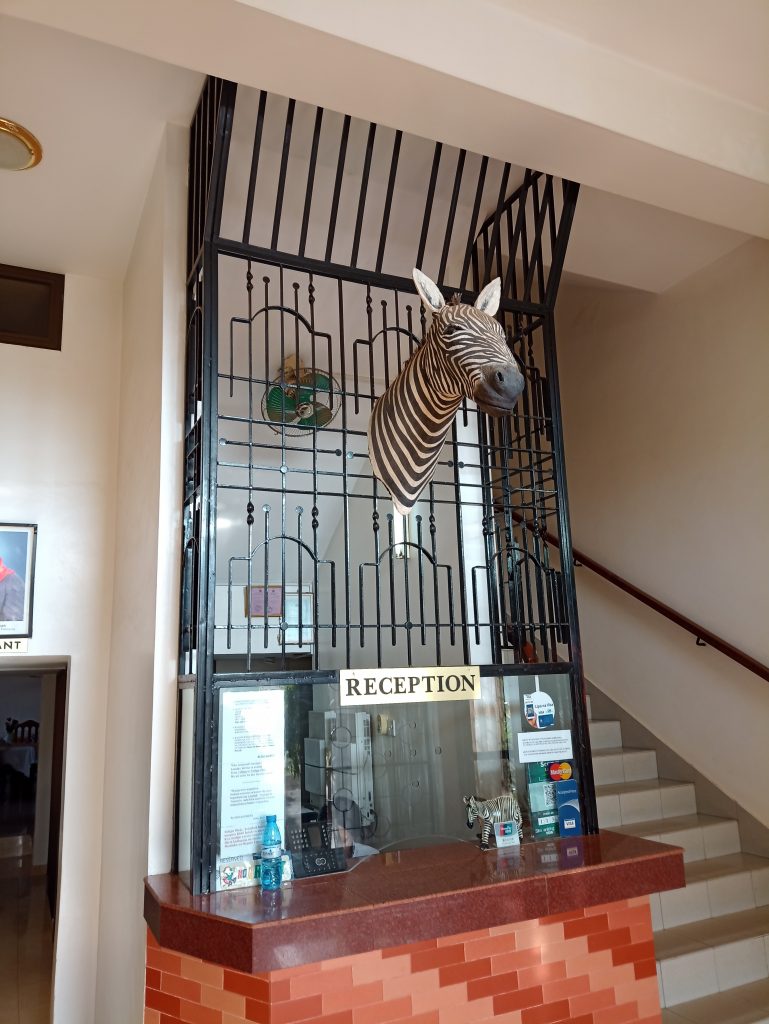
For those prepared to climb 6 storeys to the roof, Kilimanjaro was just visible.
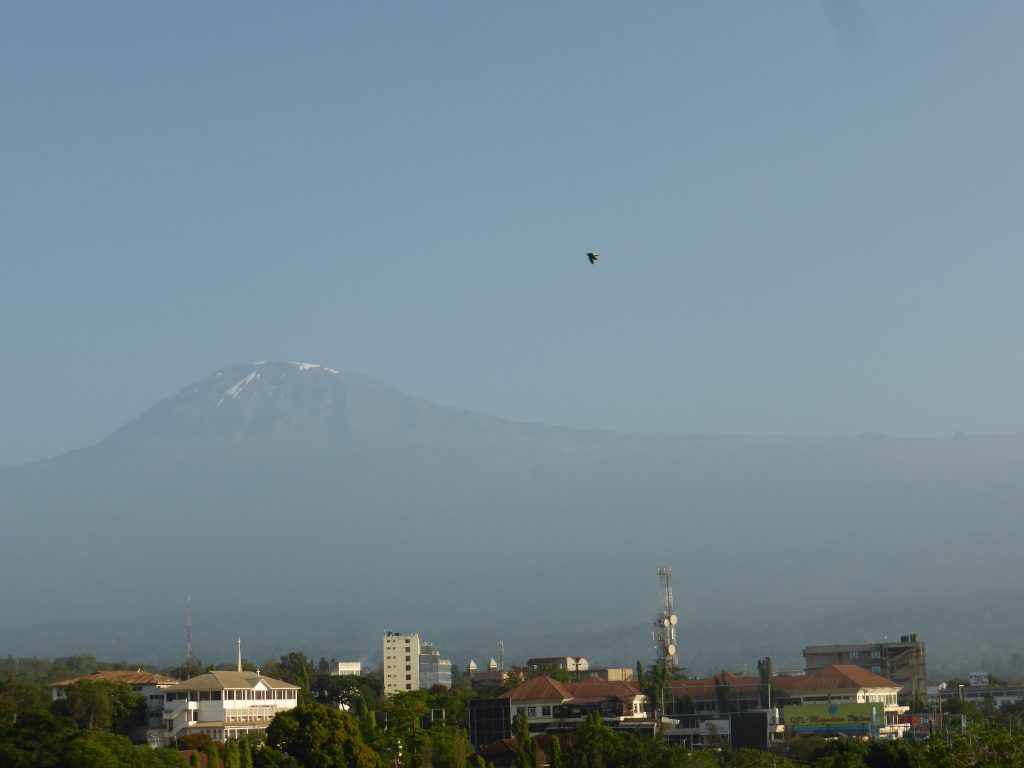
Meanwhile, Wolfgang (manager of the guiding company) checked our equipment.
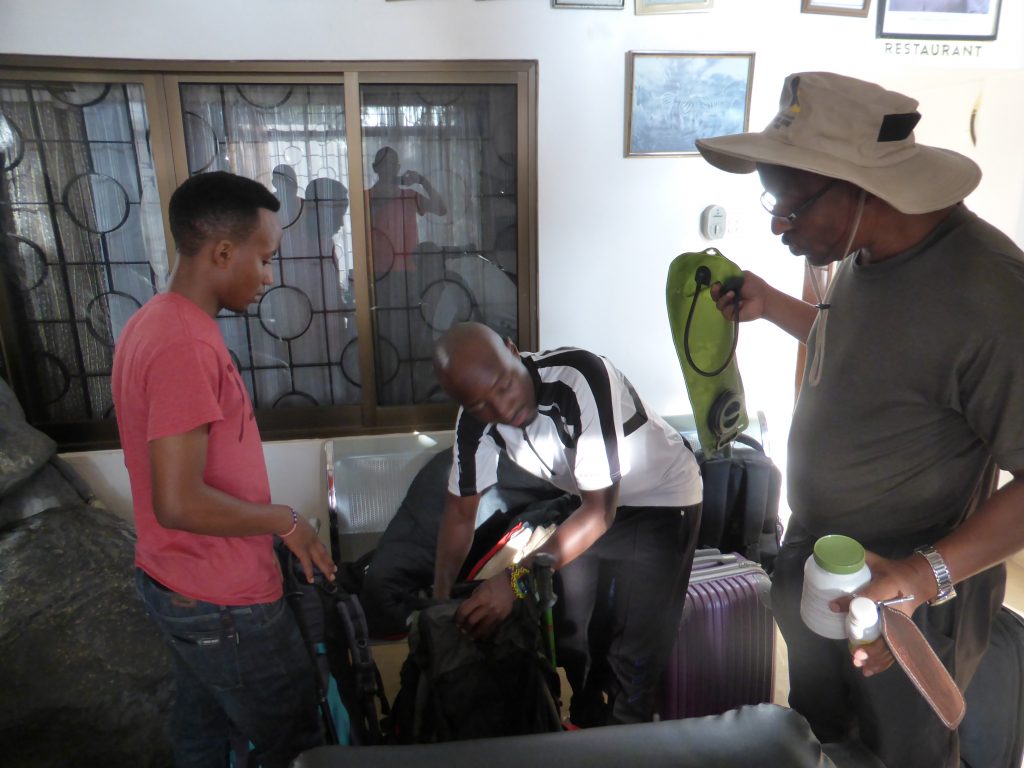
The luggage (max 15kg per person) was loaded onto the roof of the bus. Then the people were loaded and we drove to the equipment hire place where some hired missing kit, some bought extra items, and we picked up our support team and all the equipment to sustain us for a week on the mountain.
A drive of about an hour the Machame Gate followed. There the porters unloaded all the equipment again, ready to carry it to our first night’s camp.
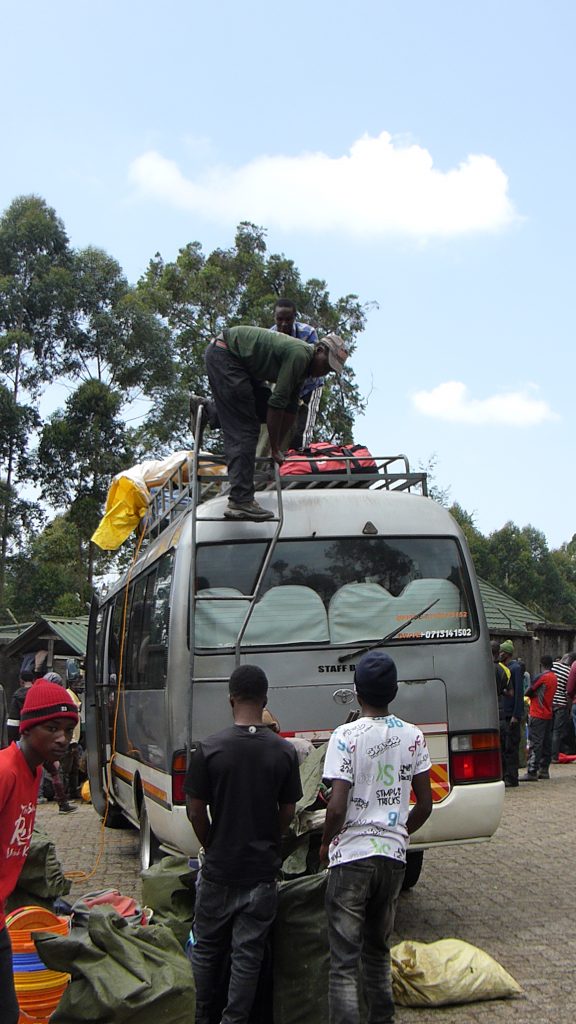
Everyone wanted their photo taken by the sign at the start of the route, but eventually we got it to ourselves.

We were served lunch then, later than I’d expected (about 13:40), we were off on the trail.
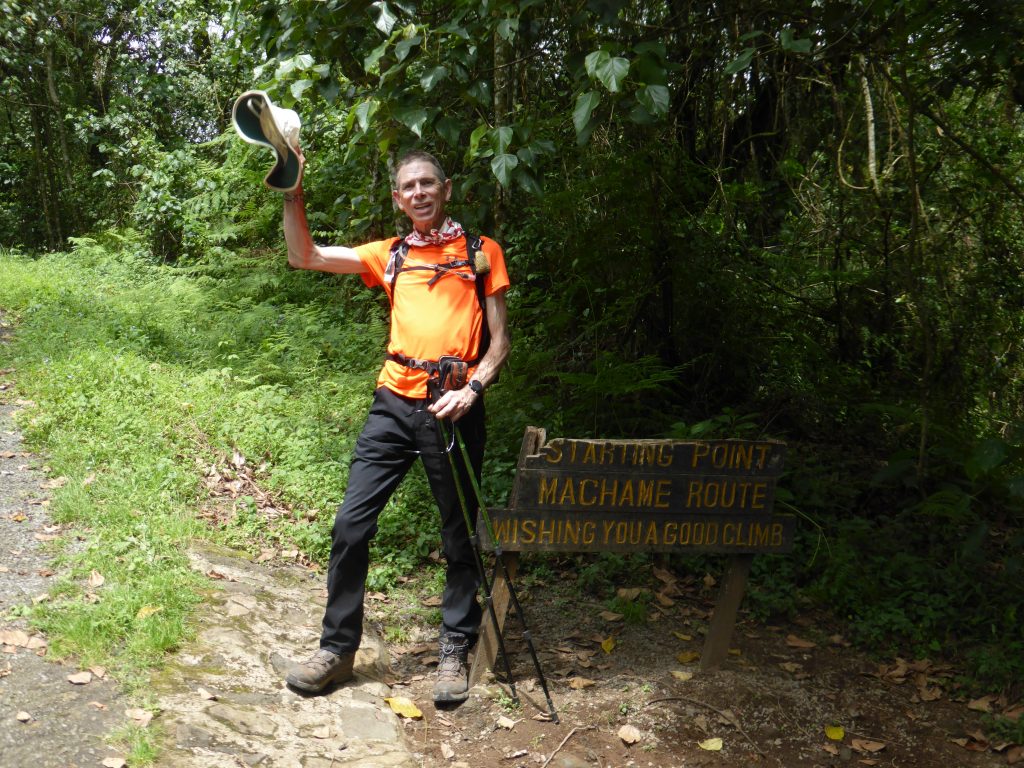
Today’s hike is a steady ascent of 1,200m (from 1,800m to 3,000m) over 10.8km all on a good trail through the rainforest.
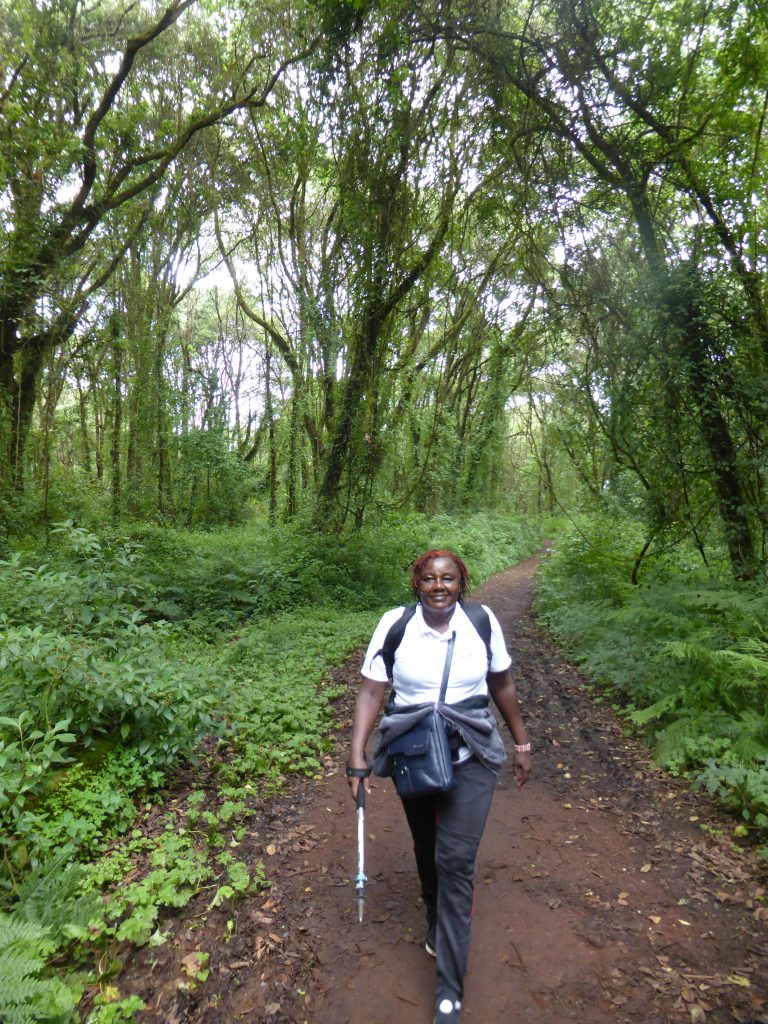
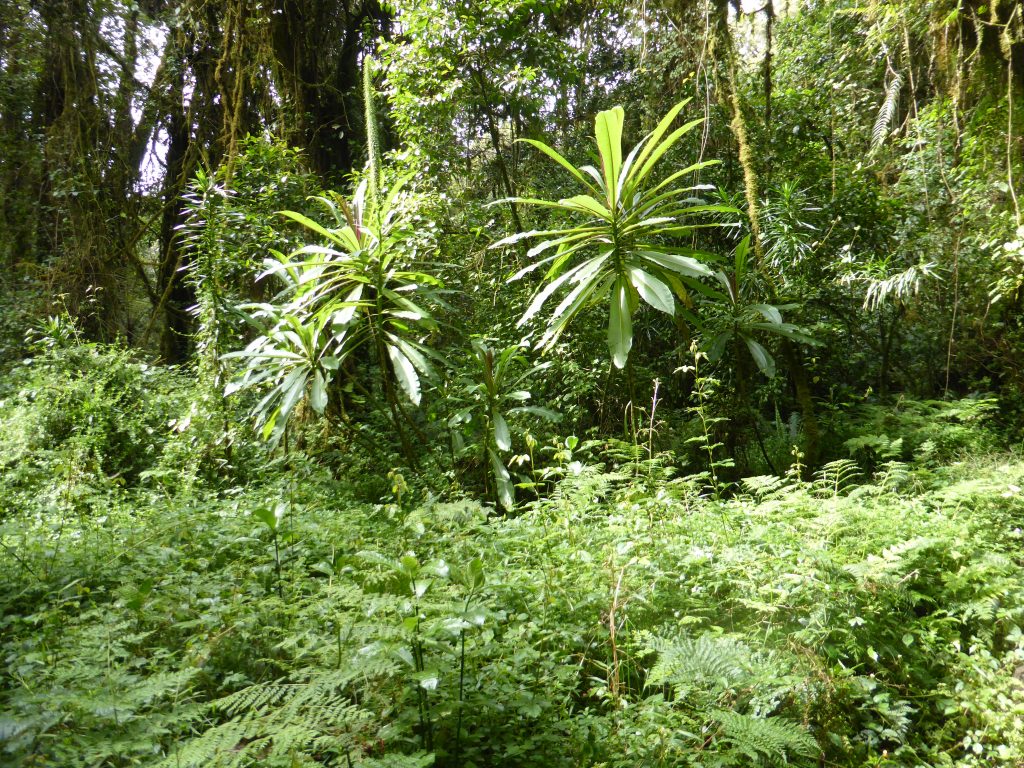
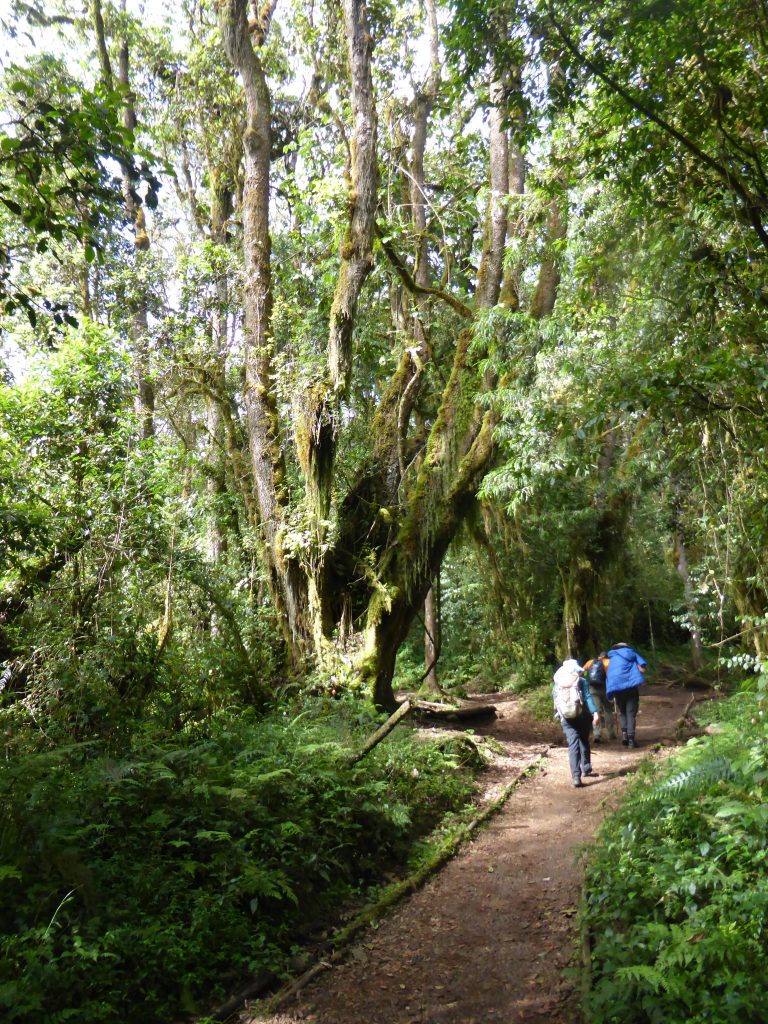
It can be a procession at times, with hikers and porters all using the same trail.
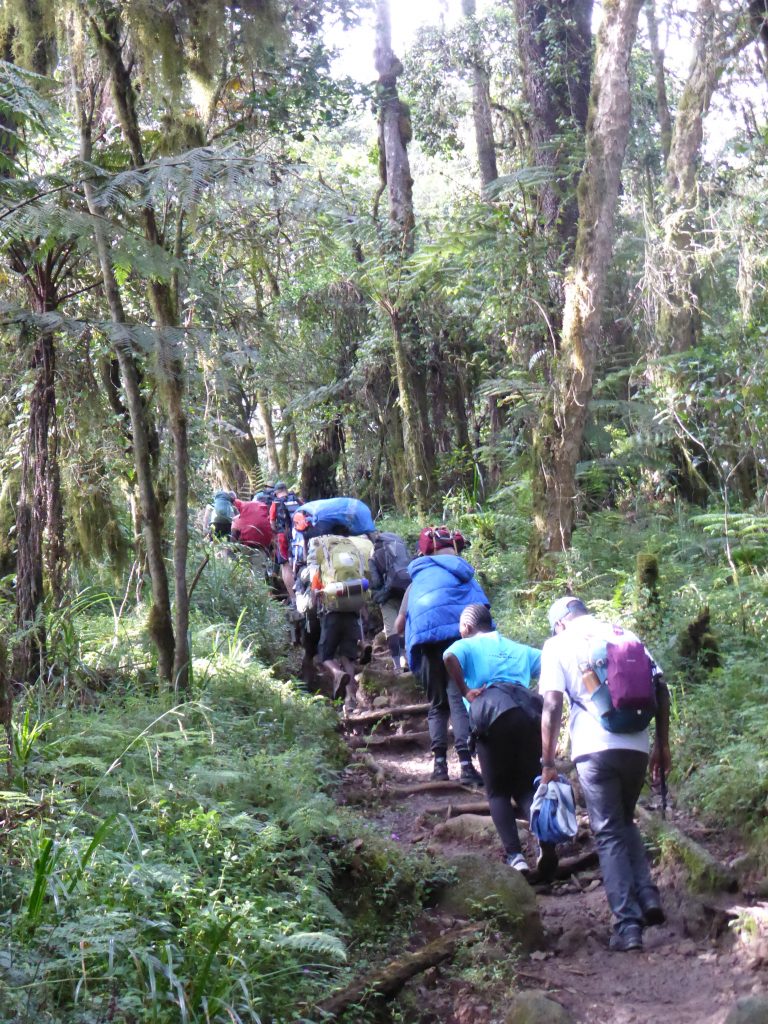
Some 3h40 after setting out we reached Machame Camp.

Here our tents were being erected and we were fed and watered before retiring to our tents for the first night under canvas.
Ngong Hills Hike with Dr Faith
Morning Hike – Ngong Hills end to end and back • Hiking Route » outdooractive.com
In Nairobi ahead of my Kilimanjaro climb, Dr Faith and her brother Steve took me to Ngong Hills for a training hike – more altitude than I’ve found in Hampshire (with a minimum elevation above 2,000m it’s higher than anywhere in UK)!
We met at 5am then an hour’s drive from Syokimau to Ngong in time to see the sun rising.

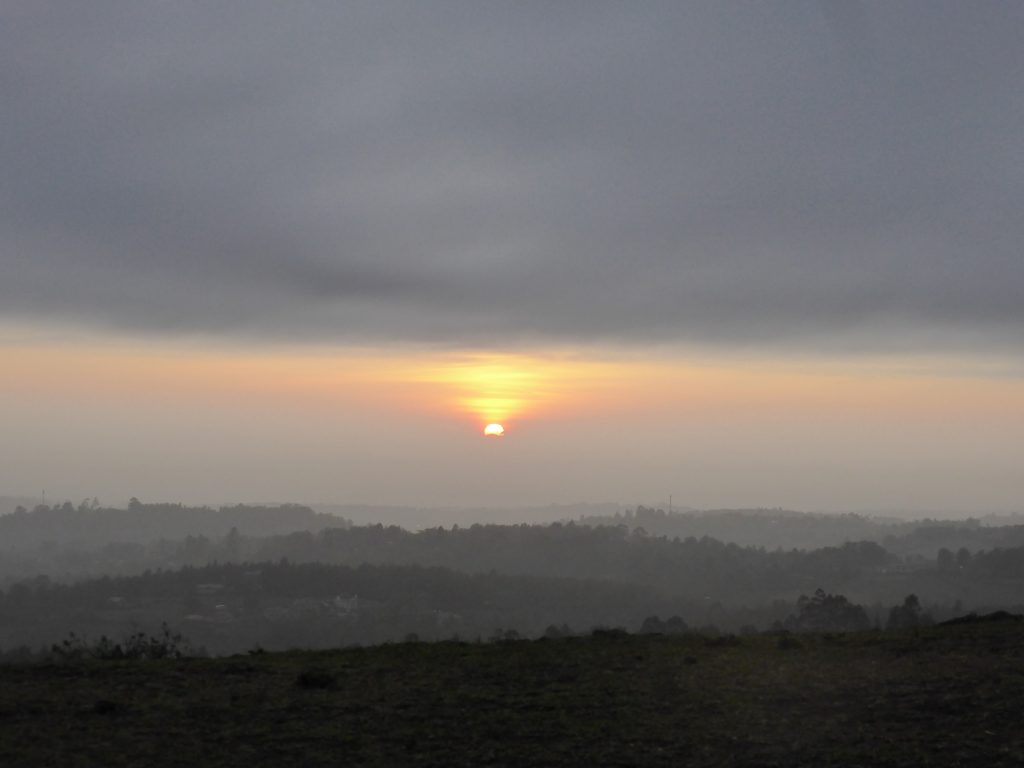
Well, just about see the sun rising as we were up in the clouds. As we started the hike (it was chilly) we could hear rather than see the wind turbines around us, and views were pretty limited.
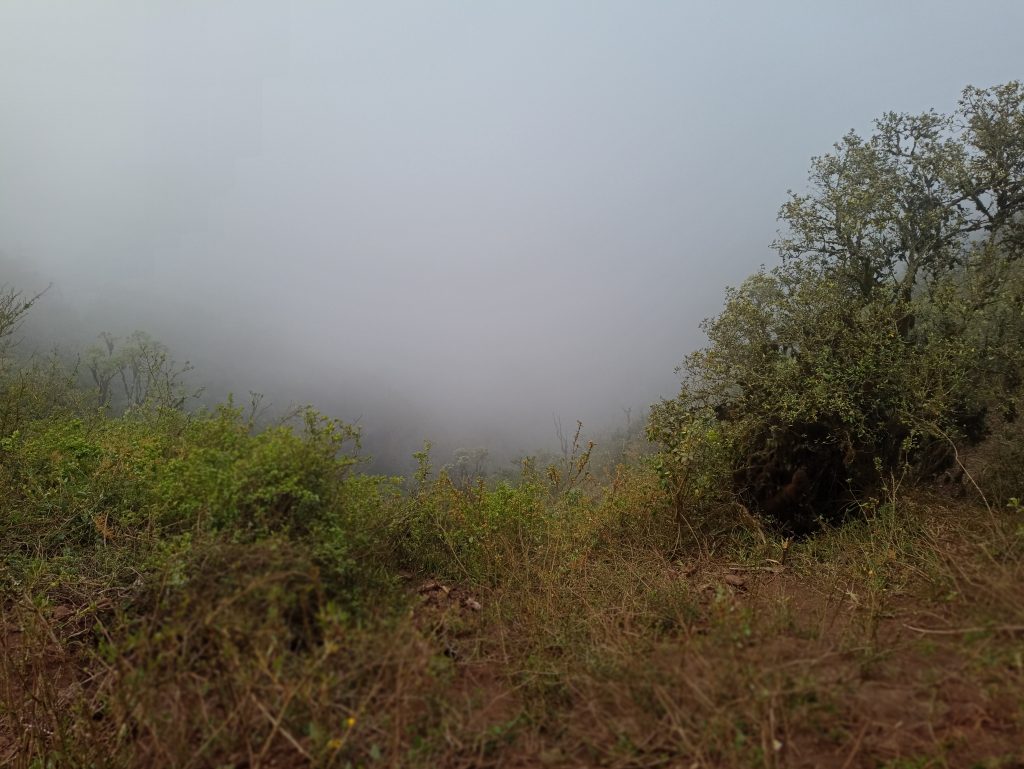
The hike starts with a steady climb (250m in 3km)
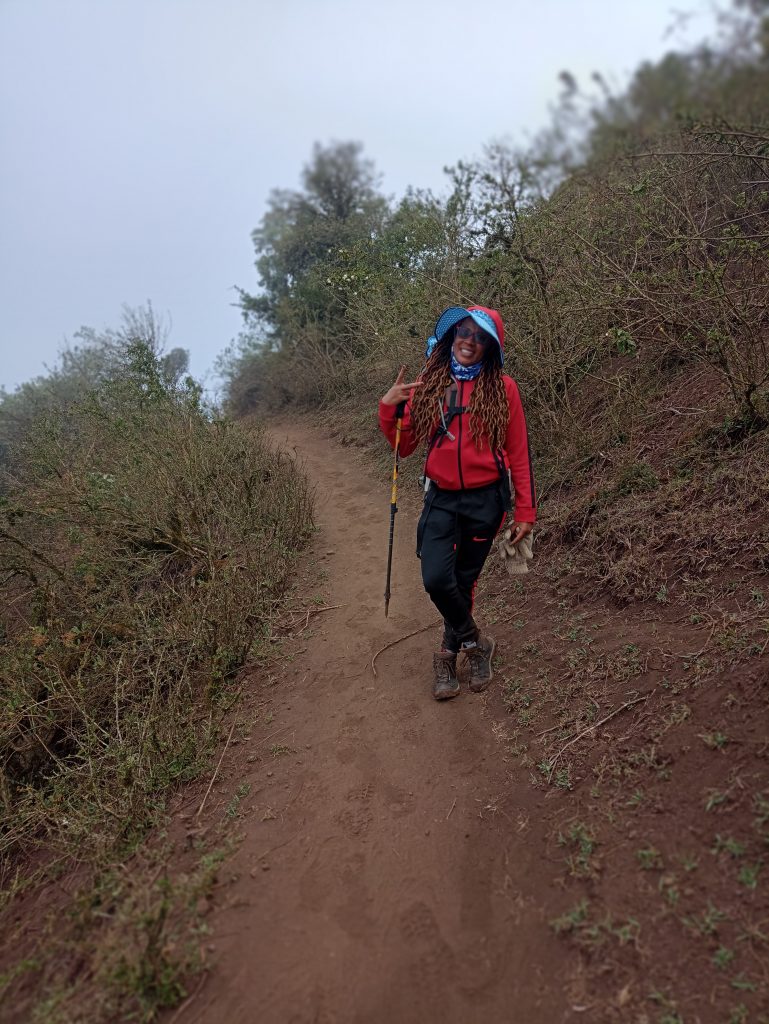
This is followed by a series of mini-summits and improving views.
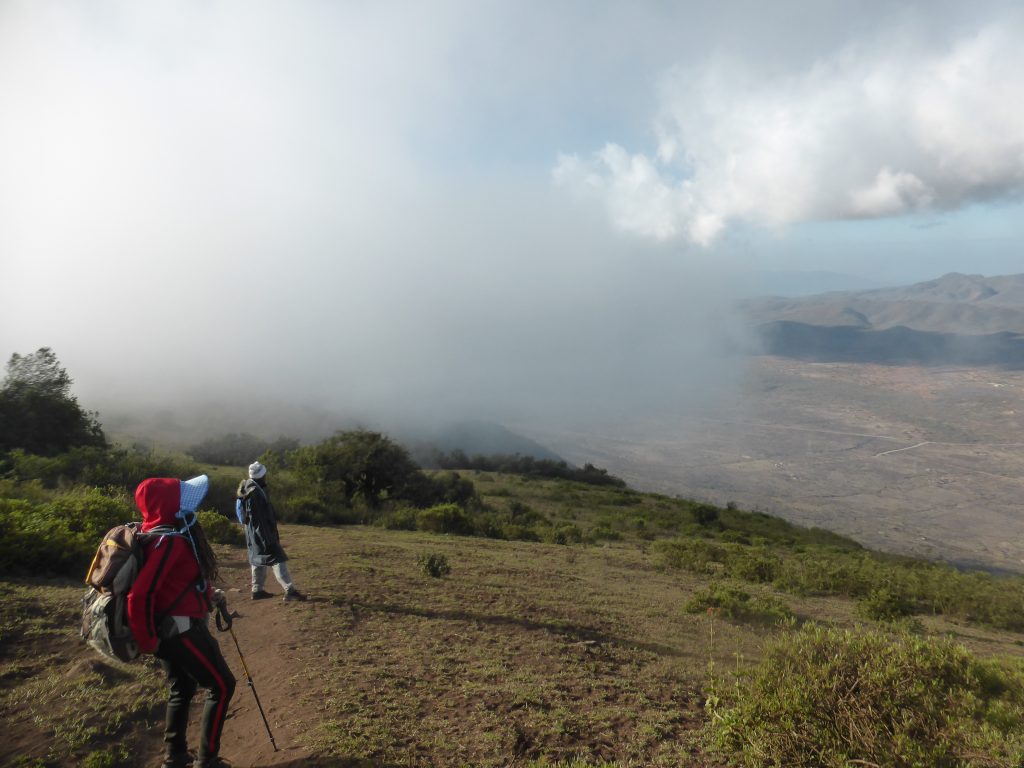
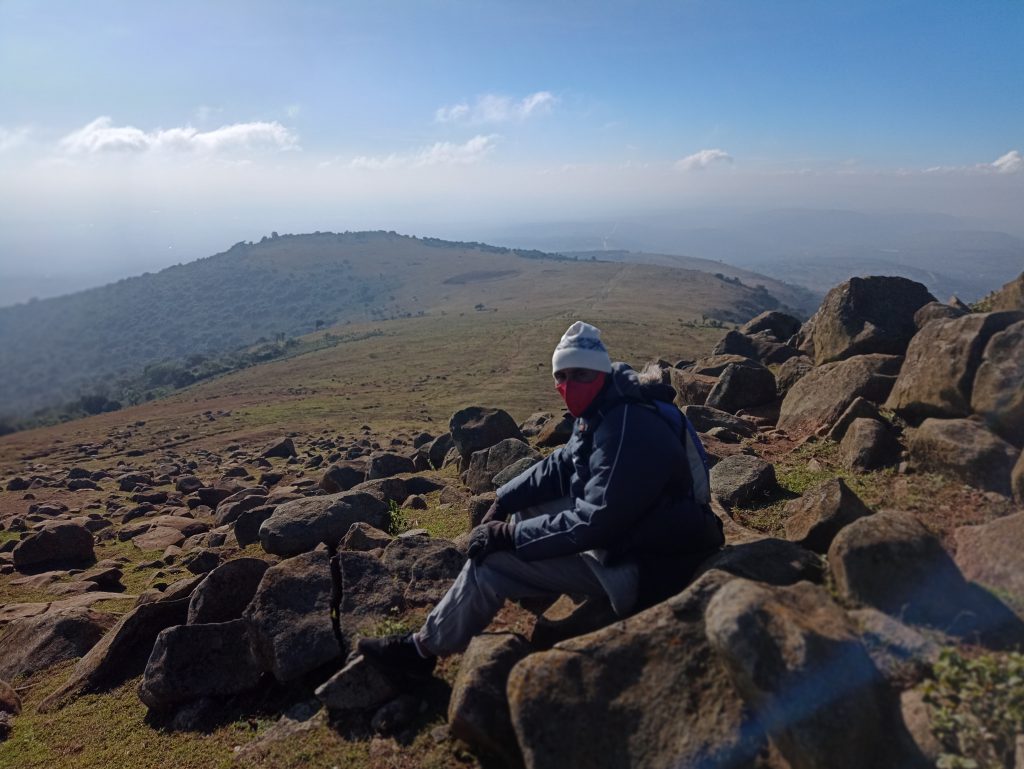

Then a long descent to the southern gate (100m lower than the northern gate) where we had to pay our entrance fees.

Then reverse the route back to the start, with increasing temperature and sun.
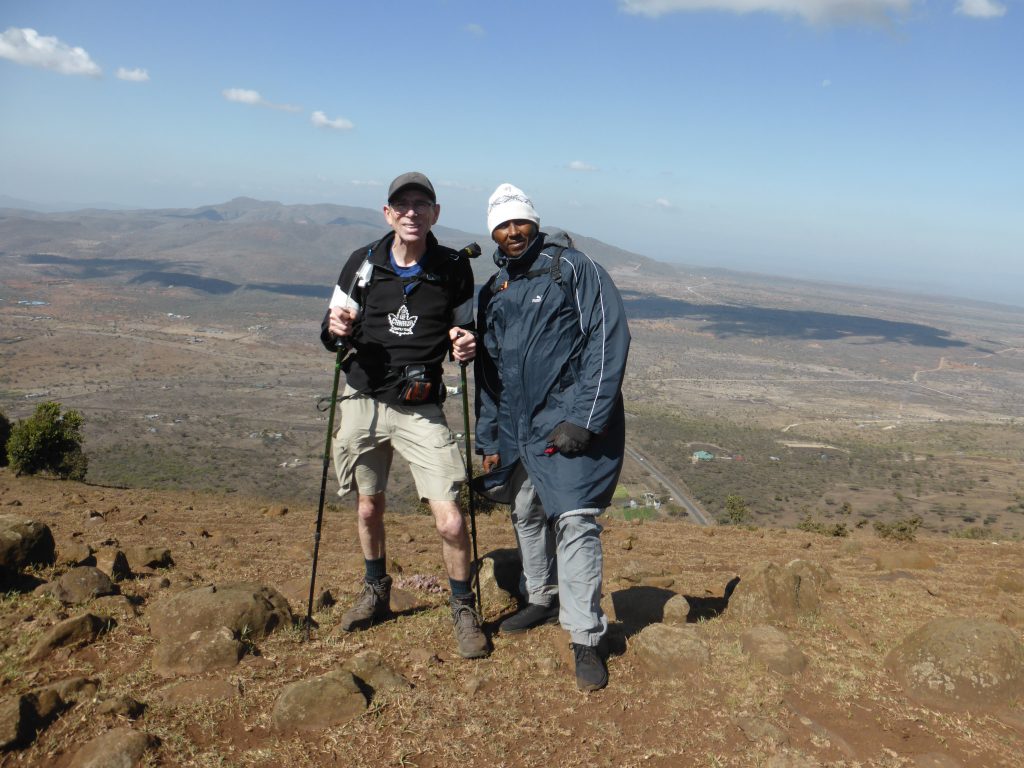

This group were singing and playing hymns that could be heard far our over the hills, an inspiration as you slogged up towards them.
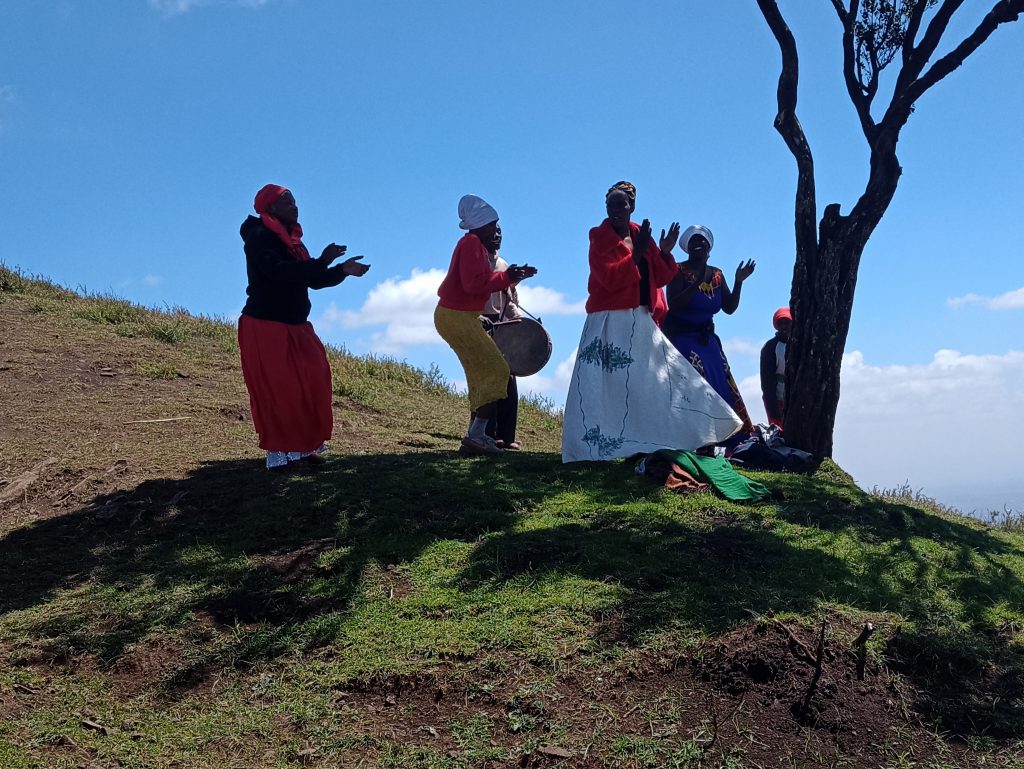
We made it – the two daktaris!
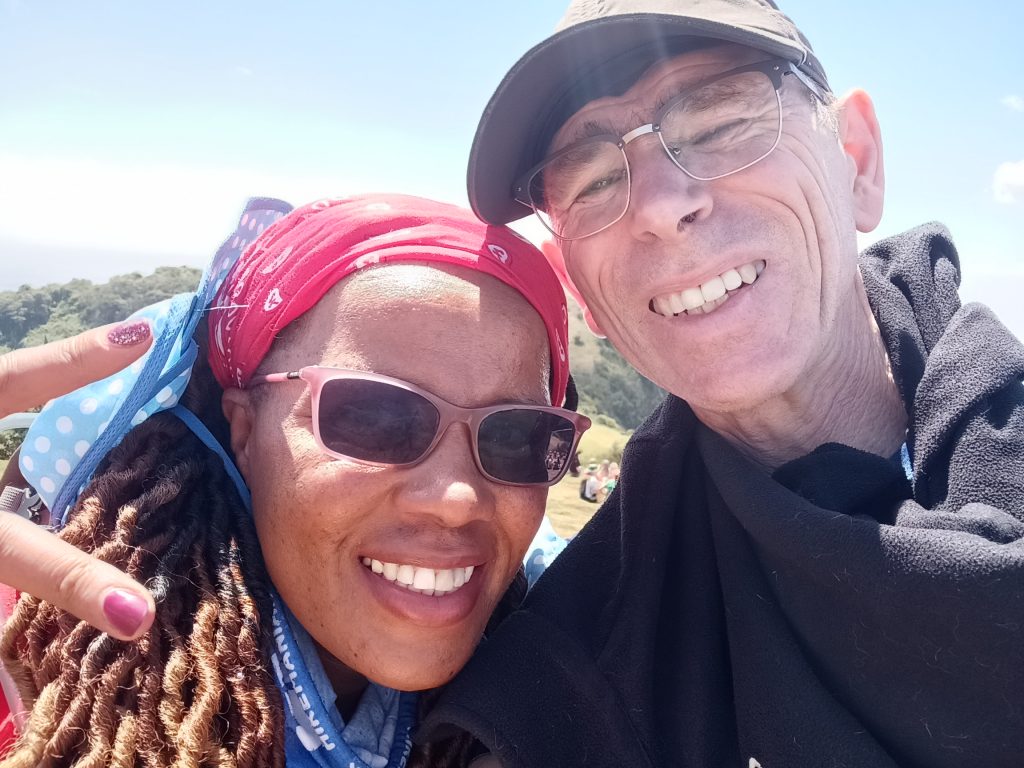
Back near the start, cattle and goats were grazing in the sunshine.

My new boots, bought the day before I left and only worn on the flight out, now looked well and truly used!
